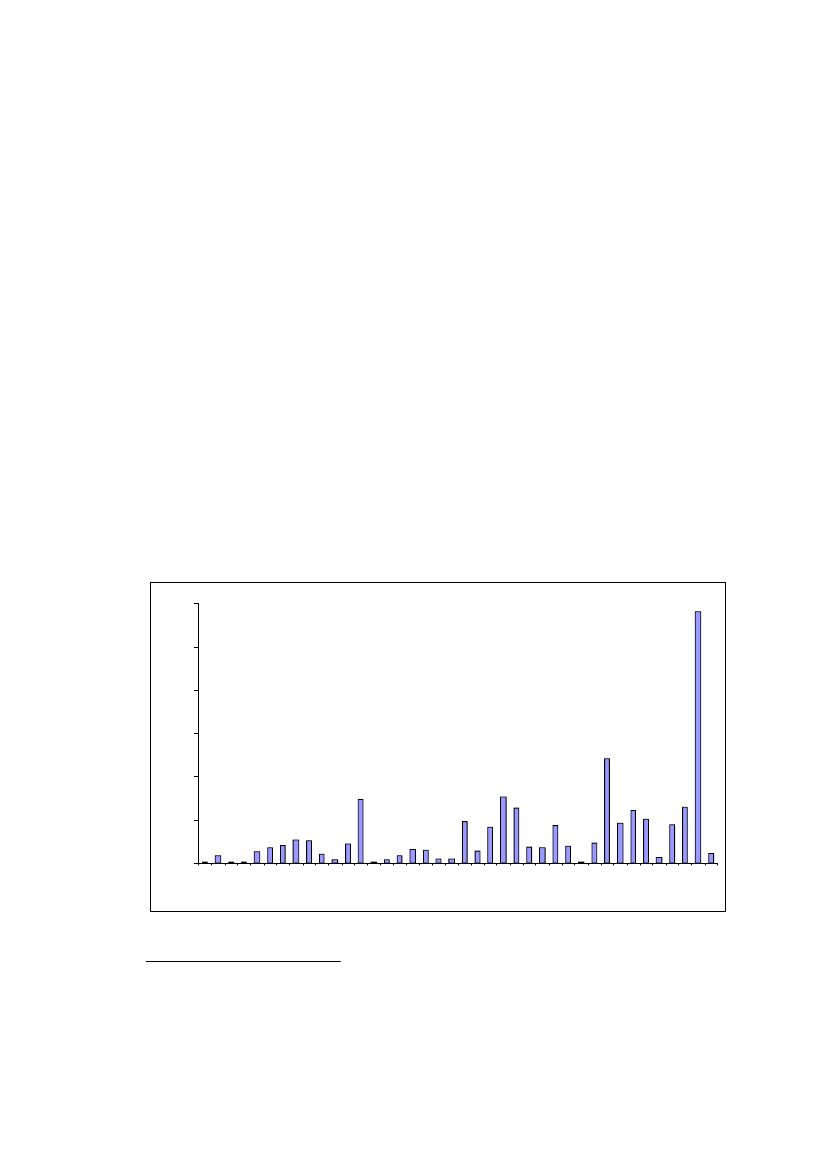Det Udenrigspolitiske Nævn 2004-05 (1. samling)
Bilag 5
Offentligt
Human Rights Watch
October 2004 Vol., No. ()
Razing Rafah:Mass Home Demolitions in the Gaza StripI. SUMMARY................................................................................................................................ 1A Pattern in the Rubble ........................................................................................................... 3Tunnels................................................................................................................................... 3Protecting the Border........................................................................................................... 5Rampage in Rafah: May 2004.................................................................................................. 8Doctrines of Destruction....................................................................................................... 11Nowhere to Turn.................................................................................................................... 14Methodology............................................................................................................................ 14II. RECOMMENDATIONS.................................................................................................... 15III. BACKGROUND ................................................................................................................ 19Map 1: Gaza Overview (Map 1: Gaza Overview) [place opposite page to the text] ........ 21The Uprising in Gaza: From Closure to “Disengagement”............................................. 22Photo: Tent.JPG.......................................................................................................................... 24Map 2: Rafah Features (Map 2: Rafah Features) [place opposite to the text].................... 26Rafah ......................................................................................................................................... 26Mass Demolition: Security Rationales, Demographic Subtexts....................................... 28Photo: Rubble.JPG ..................................................................................................................... 29IV. THE SECURITY SITUATION IN RAFAH................................................................. 32Photo: Outpost.JPG ................................................................................................................... 32The IDF and Palestinian Armed Groups............................................................................ 33Fighting on the Border........................................................................................................... 35Smuggling Tunnels in Rafah ................................................................................................. 38An Overview ....................................................................................................................... 39Tunnels vs. Shafts............................................................................................................... 42Destruction Around Inoperative Tunnels ...................................................................... 44Alternatives to House Destruction .................................................................................. 47V. THE RAFAH BUFFER ZONE SINCE 2000................................................................. 51The Expanding Buffer Zone................................................................................................. 52Photo: Wall.JPG .......................................................................................................................... 53GRAPH 1: House Demolitions in Rafah by Month, October 2000-June 2004 ............... 53Map 3: Buffer Zone Expansion (Map 7: Block O Patrol Corridor/Buffer ZoneExpansion) [place opposite page to the text].......................................................................... 54New Realities: Widening the Buffer Zone .......................................................................... 54Map 4 : Existing and Proposed Buffer Zones (Map 12: Buffer Zones) [place oppositepage to the text]........................................................................................................................... 58Impact of Destruction............................................................................................................ 59
1
HUMAN RIGHTS WATCH VOL. NO. ()
Photo: School.JPG (Can be dropped)...................................................................................... 59Photo: Qifaya. JPG (Can be dropped)..................................................................................... 60Photo: Jamal.JPG ........................................................................................................................ 60VI. A Violent Season: Destruction in Rafah, May 2004 ....................................................... 61Rampage in Rafah: An Overview ......................................................................................... 62Map 5 : IDF Operations in Rafah May 2004 (Map 3: Rafah Incursions) [place oppositepage to the text]........................................................................................................................... 62Rafah Incursions by Neighborhood, May 12-24................................................................ 70Block O & Qishta (evening May 12-morning May 15)................................................. 70Map 6 : Tel al-Sultan 2004 (Map 8: Tel al-Sultan) [place opposite page to text]............... 75Tel al-Sultan (May 18-May 24).......................................................................................... 75Photo: Sabir.JPG (Passport Size).............................................................................................. 76Photo: Sandbag.JPG ................................................................................................................... 77Photo: Sultan.JPG....................................................................................................................... 78Map 7: Brazil Features (Map 11: Brazil Before and After) [place opposite to the text]... 83Brazil and Salam (evening May 19-morning May 24) ................................................... 83Photo: Hamaad.JPG (Can be dropped)................................................................................... 87Tactics of Destruction............................................................................................................ 90Home Demolitions to Enhance Mobility ....................................................................... 91Map 8: Brazil Destruction During Operation Rainbow (Map 10: Brazil Quarter,Rainbow) [place opposite to the text] ...................................................................................... 91Infrastructure Destruction ................................................................................................ 91Photo: Ripper.JPG ...................................................................................................................... 92Photo: Water.JPG ....................................................................................................................... 92Map 9: Razing of Agriculture (Map 9: Tel al-Sultan—Agriculture) [place opposite to thetext]................................................................................................................................................ 94Razing Agricultural Land................................................................................................... 94Photo: Agriculture.JPG .............................................................................................................. 94VII. ROLE OF THE INTERNATIONAL COMMUNITY ............................................. 94Paying for the Mess ................................................................................................................ 96VIII. PROPERTY DESTRUCTION UNDER INTERNATIONAL AND ISRAELILAW............................................................................................................................................100International Humanitarian Law ........................................................................................100Responsibilities of an Occupier: Military Operations vs. Security Measures ..........101Destruction of Property in Occupation: Military Operations and Absolute Necessity.............................................................................................................................................103Control of Property in Occupation: Security Measures and Rights..........................107Human Rights Law and Occupied Territories .................................................................108Forced Evictions and the Right to Adequate Housing...............................................109Right to Effective Remedies ...........................................................................................111
HUMAN RIGHTS WATCH VOL., NO. ()
2
Israeli Jurisprudence and Law.............................................................................................112Exceptions Over the Rule: Israeli Courts and Destruction of Property..................112Reparations ........................................................................................................................114IX. Appendix: Statements by International Community Condemning Destruction inRafah ...........................................................................................................................................116ACKNOWLEDGEMENTS ..................................................................................................118
3
HUMAN RIGHTS WATCH VOL., NO. ()
Human Rights Watch
October 2004 Vol., No. ()
I. SUMMARYThese houses should have been demolished and evacuated a long time ago… Three hundred meters of the Strip along the two sides of the bordermust be evacuated … Three hundred meters, no matter how many houses,period.Major-General Yom-Tov Samiya,former head of IDF Southern Command1I built homes for Israelis for 13 years. I never thought the day would comewhen they’d destroy my house. … They destroyed the future. How can Istart all over now?Isbah al-Tayour, Rafah resident,former construction worker in Israel2Over the past four years, the Israeli military has demolished over 2,500 Palestinian houses inthe occupied Gaza Strip.3Nearly two-thirds of these homes were in Rafah, a denselypopulated refugee camp and city at the southern end of the Gaza Strip on the border withEgypt. Sixteen thousand people – more than ten percent of Rafah’s population – have losttheir homes, most of them refugees, many of whom were dispossessed for a second or thirdtime.4As satellite images in this report show, most of the destruction in Rafah occurred along theIsraeli-controlled border between the Gaza Strip and Egypt. During regular nighttime raidsand with little or no warning, Israeli forces used armored Caterpillar D9 bulldozers to razeblocks of homes at the edge of the camp, incrementally expanding a “buffer zone” that iscurrently up to three hundred meters wide. The pattern of destruction strongly suggests thatIsraeli forces demolished homes wholesale, regardless of whether they posed a specificthreat, in violation of international law. In most of the cases Human Rights Watch foundthe destruction was carried out in the absence of military necessity.
1
Voice of Israel Radio, January 16, 2002, cited in B’tselem,Policy of Destruction: House Demolitions andDestruction of Agricultural Land in the Gaza Strip,February 2002.Tsadok Yehezkeli, “Regards from Hell,”Yediot Ahronoth,June 11, 2004 (Hebrew).
23
Unless otherwise stated, statistics for homes demolished and persons rendered homeless were provided bythe United Nations Relief and Works Agency for Palestine Refugees in the Near East (UNRWA) based mostlyon assessments by its social workers. UNRWA classifies damage in three categories: total destruction, partialdestruction (rendered uninhabitable, in need of reconstruction), and damage (habitable, in need of repair).References to homes “demolished” or “destroyed” in this report refer to all those rendered uninhabitable, i.e. thefirst two categories, unless otherwise stated. UNRWA statistics also include data on the demolition of non-refugee homes.UNRWA’s operational definition of “refugee” includes descendents of those who fled or were expelled fromwhat became Israel (“Who is a Palestine refugee?” UNRWA website, available athttp://www.un.org/unrwa/refugees/whois.html,accessed September 24, 2004).
4
1
HUMAN RIGHTS WATCH VOL. NO. ()
In May 2004, the Israeli government approved a plan to further expand the buffer zone, andit is currently deliberating the details of its execution. The Israeli military has recommendeddemolishing all homes within three hundred meters of its positions, or about four hundredmeters from the border. Such destruction would leave thousands more Palestinianshomeless in one of the most densely populated places on earth. Perhaps in recognition ofthe plan’s legal deficiencies, the Israel Defense Force (IDF) is not waiting for thegovernment to approve the plan. Ongoing incursions continue to eat away at Rafah’s edge,gradually attaining the desired goal.This report documents these and other illegal demolitions. Based on extensive research inRafah, Israel, and Egypt, it places many of the IDF’s justifications for the destruction inserious doubt, including smugglers’ tunnels and threats to its forces on the border. Thepattern of destruction, it concludes, is consistent with the goal of having a wide and emptyborder area to facilitate long-term control over the Gaza Strip. Such a goal would entail thewholesale destruction of neighborhoods, regardless of whether the homes in them pose aspecific threat to the IDF, and would greatly exceed the IDF’s security needs. It is based onthe assumption that every Palestinian is a potential suicide bomber and every home apotential base for attack. Such a mindset is incompatible with two of the most fundamentalprinciples of international humanitarian law (IHL): the duty to distinguish combatants fromcivilians and the responsibility of an Occupying Power to protect the civilian populationunder its control.This report also documents with witness testimony, satellite images, and photographs, theextensive destruction from IDF incursions deep inside Rafah this past May. In total, the IDFdestroyed 298 houses, far more than in any month since the beginning of the Palestinianuprising four years ago. The extent and intensity of this destruction was not required bymilitary necessity and appears intended as retaliation for the killing of five Israeli soldiers inRafah on May 12, as well as a show of strength.Israeli Prime Minister Ariel Sharon’s plan to “disengage” from the Gaza Strip holds littlehope of relief to the residents of Rafah. Under the plan, the IDF will maintain itsfortifications and patrols on the Rafah border indefinitely. The plan explicitly envisions thepossibility of further demolitions to widen the buffer zone on the basis of vague “securityconsiderations” that, as this report demonstrates, should not require a buffer zone of thekind that currently exists, let alone further mass demolitions.This report recommends that the Israeli government cease its unlawful demolitions, allowdisplaced Palestinians to return, pay reparations to victims, pay to repair unlawful damage,and address the emergency needs of the displaced. The international community, whichfunded some of the infrastructure destroyed by the Israeli military and continues to pay foremergency relief, should press Israel to take these steps. In the meantime, if donors allocate
HUMAN RIGHTS WATCH VOL., NO. ()
2
funds to rehouse victims and repair unlawful destruction, they should demand compensationfrom Israel.
A Pattern in the RubbleThe Israeli military argues that house demolitions in Rafah are necessary primarily for tworeasons: to deal with smuggling tunnels from Egypt that run underneath the IDF-controlledborder and to protect IDF forces on the border from attack. Rafah is the “gateway toterror,” officials say – the entrance point for weapons used by Palestinian armed groupsagainst the Israeli military and civilians. Under international law, the IDF has the right toclose smuggling tunnels, to respond to attacks on its forces, and to take preventive measuresto avoid further attacks. But such measures are strictly regulated by the provisions ofinternational humanitarian law, which balance the interests of the Occupying Power againstthose of the civilian population.In the case of Rafah, it is difficult to reconcile the IDF’s stated rationales with thewidespread destruction that has taken place. On the contrary, the manner and pattern ofdestruction appears to be consistent with the plan to clear Palestinians from the border area,irrespective of specific threats.
TunnelsThe IDF argues that an extensive network of smuggling tunnels from Egypt requireincursions into Rafah that result in house demolitions. According to the IDF, a typicaltunnel-hunting operation requires Israeli forces to destroy a house covering a tunnel exit aswell as houses from which Palestinian gunmen fire at them during the operation.Based on interviews with the IDF, Rafah residents, the Palestinian National Authority(PNA), members of Palestinian armed groups, and independent experts on clandestinetunnels, Human Rights Watch concludes that the IDF has consistently exaggerated andmischaracterized the threat from smuggling tunnels to justify the demolition of homes.There is no dispute that tunnels exist to smuggle contraband, including small arms andexplosives used by Palestinian armed groups, into the Gaza Strip. But despite thetremendous burden that demolitions have imposed on the civilian population, the IDF hasfailed to explain why non-destructive means for detecting and neutralizing tunnels employedin places like the Mexico-United States border and the Korean demilitarized zone (DMZ)cannot be used along the Rafah border. Moreover, it has at times dealt with tunnels in apuzzlingly ineffective manner that is inconsistent with the supposed gravity of thislongstanding threat. The report makes three main points:Shafts vs. Tunnels.Israeli officials claim to have uncovered approximately ninetytunnels in Rafah since 2000, giving the impression of a vast and burgeoningunderground flow of arms into Gaza. When pressed about these claims, the IDFadmitted the figure refers to tunnelentrance shafts,some of which connect to existing3HUMAN RIGHTS WATCH VOL., NO. ()
tunnels and others of which connect to nothing at all. Rather than digging newtunnels, an IDF spokesman told Human Rights Watch, smugglers are often trying toconnect to cross-border tunnels that already exist. This is possible in part because,until 2003, the IDF did not seek to close the tunnels themselves, but merelydemolished the Rafah homes in which tunnel entrance shafts – operative orinoperative – were found. This tactic caused much destruction and homelessnesswhile leaving tunnels largely intact. Since 2003, soldiers are venturing inside tunnels,though an IDF spokesman told Human Rights Watch that the military does nothave the technology to collapse lateral portions of tunnels. In response to aninquiry from Human Rights Watch, the IDF refused to specify how many tunnelsversus entrances had been discovered and destroyed. The IDF’s approach –namely, the use of ineffective methods for two years, followed by unclearimprovements – contrasts sharply with alarmist Israeli statements on tunnels andthe flow of arms.Inoperative Tunnels.In at least three cases, the IDF has destroyed houses containinginoperative tunnels. In July 2004, residents discovered and reported to the PNA anincomplete shaft in an empty house. A few days later, the IDF destroyed the houseand seventeen other houses nearby, leaving 205 people homeless as well as a factory.Human Rights Watch’s onsite assessment just after the incursion, as well asinterviews with eyewitnesses and a representative of a Palestinian armed group,indicated that the destruction was militarily unnecessary; even in the home with thetunnel entrance, demolition of the whole house was an excessive response to anincomplete shaft that could have been effectively sealed with concrete. HumanRights Watch documented two other cases in which the IDF appears to havedestroyed houses with tunnel shafts that had already been sealed by the PNA. TheIDF claims that PNA closures are incomplete.Alternatives to Home Demolition.According to tunnel experts consulted by HumanRights Watch, a number of less destructive alternatives exist for the effectivedetection and destruction of smuggling tunnels. No one method is guaranteed towork in all situations, but different techniques can compensate for each other’sshortcomings, and overall conditions in Rafah favor the IDF: Only four kilometersof the border run alongside Rafah, and tunnel depth is limited by the water table –approximately forty-five meters in the camp. In this environment, the IDF couldinstall an array of underground seismic sensors along the border. Known as a“underground fence,” which has successfully detected digging activity on the U.S.-Mexico border. Other methods, such as electromagnetic induction and ground-penetrating radar, could be used to detect tunnels at the point where they cross theIDF-controlled border, and detection is more likely if the tunnels contain electricalwires, lights, and pulley mechanisms, as the IDF claims. Once the IDF detectstunnels underneath the border, it could dig down and neutralize them with concreteor explosives, obviating the need for incursions into Rafah that result in destroyedhomes and sometimes loss of life.
HUMAN RIGHTS WATCH VOL., NO. ()
4
Israel in all likelihood has access to such sophisticated technology, eitherdomestically or through the U.S. government, its closest ally. But the IDF insists ithas exhausted all alternatives, and that the current tactics are the only effective wayof dealing with the tunnel threat. Despite three requests from Human RightsWatch, the IDF declined to explain the alternative methods it has attempted todetect tunnels and why they did not work. While some information regardingtunnels may be sensitive, the enormous impact on the civilian population ofdemolitions places the burden on Israel to make the case as to why the only way ofdealing with tunnels that run underneath IDF positions is to demolish housesdeeper and deeper into the camp.
Protecting the BorderRafah is one of the most violent areas in the Occupied Palestinian Territories. Over the pastfour years, the IDF and Palestinian armed groups have regularly exchanged fire at variouspoints along the border.What follows is a brief description of the fighting on the borderrather than a chronology of how it unfolded.IDF positions fire with large caliber machine guns and tanks at civilian areas. Based onmultiple visits to the area by Human Rights Watch since 2001 and interviews with localresidents and foreign diplomats, aid workers, and journalists, this shooting appears to belargely indiscriminate and in some cases unprovoked. In July 2004, nearly every house onRafah’s southern edge was pockmarked by heavy machine gun, tank, and rocket fire on theside facing the border. Bullet holes were not only clustered around windows or otherpossible sniper positions, but sprayed over entire sides of buildings. Human Rights Watchresearchers also witnessed indiscriminate use of heavy machine gun fire against Palestiniancivilian areas in nearby Khan Yunis, without apparent shooting by Palestinians from thatarea at the time.On a regular basis, IDF positions and patrols on the border come under attack fromPalestinian armed groups using small arms and rocket-propelled grenades. During the threenights in July Human Rights Watch researchers spent in Rafah, Palestinian small arms firewas sporadic while IDF heavy machine guns fired long bursts into the camp.Representatives of Palestinian armed groups in Rafah told Human Rights Watch that theIDF-controlled border is well-fortified and attacking it is largely in vain, especially because asingle 7.62 mm bullet in Rafah costs U.S. $7 (a figure also cited by the IDF as evidence oftheir success in blocking arms).Both the IDF and Palestinian armed groups use tactics that place civilians at risk. Undercustomary international law, civilians must be kept outside hostilities as far as possible, andthey enjoy general protection against danger arising from hostilities. Human Rights Watchdocumented multiple cases where the IDF converted civilian buildings into sniper positions
5
HUMAN RIGHTS WATCH VOL., NO. ()
during incursions and forced residents to remain with them inside. In some cases, the IDFcoerced civilians to serve as “human shields” while searching Palestinian homes, a practicestrictly prohibited by international humanitarian law.5By attacking the IDF from withinpopulated areas, Palestinian armed groups also place civilians at risk, but Human RightsWatch found no evidence that gunmen fire from inhabited homes or force residents to letarmed groups use their homes.Despite the intense daily gunfire, most homes at the edge of the camp are still inhabited, atleast part of the time. Some residents remain despite the risk, lest the IDF consider theirhomes abandoned and target it for destruction. Even when they do leave, however, absencedoes not constitute abandonment, especially when indiscriminate IDF shooting forcescivilians to flee. One Palestinian, living in the municipal stadium after the IDF bulldozedtwo of his homes in 2001 and 2004, explained how IDF tactics force Palestinians near theborder to leave their homes. “If [the Israelis] want to make you leave the home, they shootthe walls, they shoot the windows,” he said. “Then they can come and say ‘It is empty,’ andbulldoze the house.”6
Comprehensive statistics on combatant and civilian deaths are unavailable and there isno consensus on how many Palestinian casualties from IDF fire are civilians. The IDFdoes not appear to keep statistics of civilian deaths or injuries inflicted by its forces.Accordingto the Palestinian Central Bureau of Statistics, 393 residents of the Rafahgovernorate were killed between September 29, 2000, and August 31, 2004, including ninety-eight children under age eighteen.7The lowest possible percentage of civilian victims inRafah is twenty-nine, which is the percentage of women and children killed over the pastfour years. The actual figure is undoubtedly much higher because twenty-nine percentpresumesthat every adult Palestinian male killed was directly participating in hostilities.In the same period, Palestinian armed groups killed ten Israeli soldiers in Rafah. One waskilled while patrolling the border, in February 2001; four others were killed during incursionsinside the camp. The other five soldiers were killed on May 12, 2004, when Islamic Jihadfighters destroyed an Israeli armored vehicle with a rocket-propelled grenade.8The IDFinvoked this latter incident to justify the further expansion of the buffer zone throughwholesale demolition of homes. As discussed below, it better demonstrates the effects ofthe IDF’s expansive notion of security.
5
Human Rights Watch has extensively documented this practice in recent years. SeeIn a Dark Hour: The Useof Civilians During IDF Arrest Operations(Human Rights Watch, April 2002).Human Rights Watch interview with Ibrahim Abu Shittat, Rafah, July 13, 2004.
67
Palestinian Central Bureau of Statistics,http://www.pcbs.org/martyrs/table1_e.aspx,(accessed October 4,2004).Figures on Israeli fatalities are drawn from the website of the Israeli Ministry of Foreign Affairs,www.mfa.gov.il.(accessed October 4, 2004) In response to an inquiry from Human Rights Watch, the IDF did not disclosefigures on injuries in Rafah.
8
HUMAN RIGHTS WATCH VOL., NO. ()
6
In this context, the IDF has taken steps that go far beyond what international law allows andwhat the security of its forces requires. The IDF has built improved fortifications on theborder that by themselves would contribute greatly to the protection of patrols; but thesenew fortifications were placed deeper inside the demolished area, bringing them closer to thehouses, and effectively creating a new starting point for demolitions. The IDF’s expansivenotion of security erodes the spirit of international humanitarian law and is a recipe forongoing demolitions.The border between the Gaza Strip and Egypt is 12.5 kilometers long, of which fourkilometers run alongside Rafah. The IDF refers to this border area as the “Philadelphi”corridor or zone, but it is better understood as two distinct areas: a shieldedpatrol corridor(between the border and IDF fortifications) and abuffer zone(the space between IDFfortifications and the houses of Rafah). The expansion of both of these areas is illustrated inthe satellite imagery included in this report.Before the uprising, the IDF maintained a patrol corridor along the border some twenty toforty meters wide, separated from the camp in most places by a concrete wall, approximatelythree meters high, topped with barbed wire. In some areas, especially the densely populatedBlock O section of the camp, houses were situated within several meters of the patrolcorridor.Beginning in 2001, as armed clashes erupted in the border area, the IDF launched nighttimeraids in Block O and other areas of Rafah, demolishing up to one or two dozen homes ineach attack and expelling all residents from the cleared area. The IDF argued that thesedemolitions were necessary responses to attacks from Palestinian armed groups, as well aspart of anti-tunneling efforts. These demolitions resulted in a de facto buffer zone betweenthe patrol corridor and the camp, littered with rubble and empty of Palestinians.By late 2002, after the destruction of several hundred houses in Rafah, the IDF beganbuilding an eight meter high metal wall along the border. This wall, now 1.6 kilometers long,faces the parts of Rafah that used to be closest to the border. Such a structure would havegreatly enhanced the security of IDF patrols by allowing armored vehicles to patrol withoutbeing seen by Palestinian snipers, while fortified IDF towers in the patrol corridor and builtalong the wall could monitor and respond to attacks on the wall from Rafah. Other securitymeasures permitted under international law, such as restricting access to areas near the wallor taking control of property9along it (i.e. seizing homes and closing them off in a reversiblemanner), could have supplemented these moves. Instead of attempting any of thesemeasures, the IDF resorted to demolitions en masse, without warning, often in the middle ofthe night.
While major militaries affirm the right of an occupying power to temporarily control property for securitypurposes, confiscation (permanent seizure and transfer of ownership) is prohibited by Article 46 of the HagueRegulations.
9
7
HUMAN RIGHTS WATCH VOL., NO. ()
Most importantly, the IDF built the wallinsidethe demolished area, some eighty to ninetymeters from the border. Such an expansion doubled the width of the patrol corridor andwas not required to safeguard the border, as the previous twenty to forty meter-wide patrolcorridor was amply wide enough for multi-lane use by armored vehicles. The IDF’s Merkavatank is 3.72 meters wide, while Caterpillar D9 armored bulldozers, used in demolitionoperations, are 4.58 meters wide without armor.The expansion of the patrol corridor brought IDF fortifications closer to the camp,exposing them to risks subsequently invoked to justify further demolitions. According tosatellite imagery taken in May 2004, some two hundred meters of demolished housesseparated the metal wall from the last rows of remaining houses. In total, some fifteenpercent of central Rafah’s pre-2000 built-up area has been razed in order to make way forthe expansion of both the patrol corridor and the buffer zone. The IDF invoked the deathof five Israeli soldiers in Rafah on May 12, 2004, to demonstrate the need for a wider bufferzone. This incident instead illustrates the effects of Israel’s inherently expansive notion ofsecurity: the armored vehicle carrying the soldiers was conducting an anti-tunnelingoperation between the metal wall and the camp, not inside the patrol corridor.According to this logic, the IDF could continue to relocate its positions progressively closerto homes and then destroy them for security purposes. This explains in part why the rate ofhouse demolitions in Rafah tripled in 2003 compared to the previous two years, after thecompletion of the wall, even though it should have reduced the perceived need to protectthe border. Similarly, the IDF’s recommendations for further razing are based in part on theperceived need to safeguard a proposed anti-tunneling trench in the buffer zone. While sucha trench in theory could be lawful, it cannot be invoked as a reason to further expand thebuffer zone, especially in light of the existence of less destructive methods to detect andneutralize tunnels.This inherently expansive notion of “security” is incompatible with Israel’s duty as anOccupying Power to balance its own interests against those of the civilian population. Asone IDF officer put it, “I have no doubt that the clearing actions [i.e. house demolition andland razing] have an element of tactical value, but the question is, where do we draw the line?According to that logic, what prevents us from destroying Gaza?”10
Rampage in Rafah: May 2004In May 2004, Rafah witnessed a level of destruction unprecedented in the current uprising,resulting in 298 demolished homes. After Islamic Jihad destroyed the armored personnelcarrier (APC) on May 12, the IDF launched a two-day incursion to recover the soldiers’remains. IDF tanks and helicopters also led an assault on Block O, reportedly killing fifteen10
Avihai Becker, “The Black List of Captain Kaplan,”Ha’aretz,April 27, 2001, cited in B’tselem,Policy ofDestruction: House Demolitions and Destruction of Agricultural Land in the Gaza Strip,February 2002, p. 34.
HUMAN RIGHTS WATCH VOL., NO. ()
8
Palestinians, including one fifteen-year-old. Six others were identified as combatants.11Claiming that it came under intense fire during the entire operation, the IDF razed eighty-eight homes in Block O and neighboring Qishta area, including houses that had beenseparated from the buffer zone by three or four rows of homes and could not have beenused to fire at the APC or the recovery teams. Towards the end of the incursion, two Israelisoldiers in Qishta were killed by Palestinian snipers.From May 18-24, the IDF conducted a major assault called “Operation Rainbow” thatpenetrated deep into two areas of Rafah – Tel al-Sultan in the northwest and the Brazil andSalam neighborhoods in the east – reportedly leaving thirty-two Palestinian civilians dead,including ten people under age eighteen, as well as twelve armed men. The IDF alsodestroyed 166 houses. The offensive was ostensibly aimed at searching for smugglingtunnels, killing or arresting suspects, and eliminating “terrorist infrastructure.” The IDFclaimed to have discovered three smuggling tunnels during the operation, though lateradmitted that one of these was an incomplete shaft and another was outside of Rafah andnot linked to any house demolitions.In investigating the events of May 2004 and other demolitions, Human Rights Watchdocumented systematic violations of international humanitarian law and gross human rightsabuses by the Israeli military. During the major May incursions of May 18-24, the IDFdestroyed houses, roads, and large fields extensively without evidence that the destructionwas in response to absolute military needs, including in areas of Rafah far from the border.In areas of Brazil further from the border, where incursions were not expected, most of theresidents were inside their homes as armored Caterpillar D9 bulldozers crashed through thewalls. Bulldozers allowed residents to flee but proceeded with the destruction before theycould remove their belongings. In some cases away from the border, like the Rafah zoo, thedestruction took place after the IDF had secured the area, in a manner that was time-consuming, deliberate, and comprehensive, rather than in the heat of battle.The IDF claims its forces came under attack from Palestinians using anti-tank weapons,explosives, and small arms. Based on interviews with thirty-five Rafah residents and twomembers of Palestinian armed groups, information provided by the IDF, public statementsby Palestinian armed groups and the Israeli government, and after surveying the affectedareas, Human Rights Watch believes that armed Palestinian resistance to the May 18-24operation was light, limited, and quickly overwhelmed within the initial hours of eachincursion. Both sides made tactical choices to maximize their respective advantages: theIDF limited their operations mostly to Brazil and Tel al-Sultan, where they were notexpected and Palestinian armed groups laid ambushes in the densely populated heart of theoriginal camp, where they would be more likely to engage the IDF at close quarters. Assatellite images in this report ff Tel al-Sultan and Brazil show, the main streets in these two
Because in this investigation HRW focused on the pattern of property destruction, figures on deaths werecompiled from an analysis of reporting by local human rights organizations, media accounts, and statements byPalestinian armed groups, supplemented in some cases by Human Rights Watch’s own documentation.
11
9
HUMAN RIGHTS WATCH VOL., NO. ()
areas are relatively wide and arranged in grid-like patterns. The Israeli government designedthem in this way during the 1970s to facilitate the movement of its forces and limit cover forPalestinian gunmen. As a result, throughout the operation there was minimal directengagement between the IDF and Palestinian armed groups. This contrasts sharply with thefierce multi-day battle in the densely populated heart of Jenin refugee camp in April 2002,which resulted in the death of fifty-two Palestinians, including twenty-seven confirmedcivilians, and thirteen IDF soldiers.During the incursions into Tel al-Sultan and Brazil, the IDF employed armored CaterpillarD9 bulldozers in a manner that was indiscriminate and excessive, resulting in widespreaddestruction of homes, roads, and agriculture that could have been avoided:Houses.In Brazil, Caterpillar D9 bulldozers cleared “tank paths” inside the camp byplowing through blocks of houses as a general precaution against possible attackswith RPGs or roadside bombs, irrespective of the specific threats that internationallaw requires. The IDF also used D9s to destroy homes near suspected smugglingtunnels and in other areas on a preventive basis, not in response to specific threats.Other house demolitions had no discernible reason.Road destruction.In both Tel al-Sultan and Brazil, the IDF used Caterpillar D9s toindiscriminately tear up roads, destroying water and sewage networks, and creating asignificant public health risk in an already vulnerable community. In some areas,water shortages forced residents to leave their homes in search of water, puttingthem at risk of being shot by IDF snipers for breaking curfew. In total, the IDFdestroyed fifty-one percent of Rafah’s roads, usually by dragging a blade known asthe “ripper” from the back of the D9 down the middle of the road. The IDF gavevarious explanations for this tactic, including the need to clear paths of potentialbombs (improvised explosive devices, or IEDs), to sever wires that could be used todetonate explosive devices and to prevent suicide car attacks on Israeli forces. If theIDF was truly concerned about wires and IEDs, it would have used a frontmounted device. Instead they usedrear-mountedrippers that afforded noprotection for the D9 bulldozers or their drivers from explosive devices in the road.In addition, as a photograph in Chapter 6 taken from another incursion shows, theripper creates a path of debris down the middle of the road, leaving side lanes intactfor use by suicide car attacks. And tearing up paved roads creates loose debris thatfacilitates the concealment of explosives and booby-traps.Razing Agricultural Land.The IDF razed two large tracts of agricultural land outsidethe Tel al-Sultan housing project away from the border. Such destruction after theIDF had secured the area was disproportionate to any potential military gain andhad a harmful impact on an area where agricultural production plays an importantrole. The IDF told Human Rights Watch that military vehicles destroyedagricultural land because they had to avoid booby-traps on roads, but this does not
HUMAN RIGHTS WATCH VOL., NO. ()
10
explain why bulldozers spent more than two days systematically destroying two largefields of greenhouses.While research focused on the extensive destruction in the Rafah camp, Human RightsWatch also documented other abuses during the incursions into Tel al-Sultan and Brazil,including unlawful killings of civilians and IDF troops coercing civilians to serve as “humanshields.” Most egregiously, on March 19, an Israeli tank and helicopter opened fire on ademonstration, killing nine, including three children under age eighteen. The IDF did notclaim that its troops had come under fire, only that gunmen were in the crowd; eyewitnessaccounts and video evidence contradict this. In response to an inquiry from Human RightsWatch, the IDF said that one those killed had been listed in its records as a “Hamas activist”but did not substantiate or even reaffirm the claim that he had been armed at the time.
Doctrines of DestructionAs the Occupying Power in the Gaza Strip, the IDF has two roles: an administrator withpolice and security powers, and a potential belligerent who may engage in fighting. But atalltimes it is responsible for protecting the civilian population, in accordance with bothinternational humanitarian law (the laws of armed conflict) and human rights law.International humanitarian law permits an occupier to take the drastic step of destroyingproperty only when “rendered absolutely necessary by military operations.”12According tothe International Committee of the Red Cross (ICRC), military operations are “movements,manœuvres and actions of any sort, carried out by the armed forces with a view tocombat.”13A belligerent occupation cannot be considered a “military operation” in itself,nor can every activity conducted by the Occupying Power be considered a militaryoperation; rather, a military operation must have some concrete link to actual or anticipatedfighting. Destroying property to improve the general security of the occupier or as a broadprecaution against hypothetical threats is prohibited. As the ICRC stated during the Mayincursions in Rafah, “the destruction of property as a general security measure isprohibited.”14Even during military operations, indiscriminate and disproportionate attackson civilian objects are not allowed. Civilian property may not be destroyed unless it ismaking an effective contribution to military action and its destruction offers a definitemilitary advantage. In cases in which the targeted object is normally dedicated to a civilianpurpose, such as a house, the presumption under the law is that it is not a legitimate target.
1213
Fourth Geneva Convention, Art. 53.
ICRC, Commentary to the Protocol Additional to the Geneva Conventions of 12 August 1949, and relating tothe Protection of Victims of International Armed Conflicts (Protocol I), 8 June 1977, p. 67. See virtually identicallanguage in “Interpretation by the ICRC of Article 53 of the Fourth Geneva Convention of 12 August 1949, withparticular reference to the expression ‘military operations,’” Letter to al-Haq signed by Jacques Moreillon,Director of Department of Principles and Law and Jean Pictet, ICRC, November 25, 1981 (“… with a view tofighting”) and “Occupation and international humanitarian law: questions and answers,” ICRC press release,August 4, 2004 (“…when absolutely required by military necessity during the conduct of hostilities”).14
“ICRC Deeply Concerned Over House Destructions in Rafah,” ICRC press release, May 18, 2004.
11
HUMAN RIGHTS WATCH VOL., NO. ()
Outside of combat, the Occupying Power may take measures to enhance its security.Among other things, it can temporarily take control of property to prevent its hostile use,build fortifications, and prohibit access to certain areas, but these measures must becompatible with a fuller range of human rights protections, including the right tocompensation for properties seized. Although it has denied the applicability of internationalhuman rights instruments to Palestinians in the OPT, Israel is widely considered to be boundby these laws. International human rights law obliges Israel to provide effective judicialremedies for victims of forced eviction and to ensure adequate housing for PalestiniansThe IDF’s unlawful policy of destruction is consistent with public statements by Israeliofficials, the IDF’s disturbingly permissive interpretation of international law, and its ownadmission that destruction has been excessive:The IDF has publicly admitted destroying houses to “weaken the fear of tunnels”15or in response to other hypothetical risks. This doctrine conflates the legalrequirement of absolute military necessity – a strict standard requiring that anyproperty destruction must be connected to combat – with the much broader notionof security. This conflation is consistent with the expressed desire of senior IDFofficers, from Sharon’s days as head of the IDF Southern Command in the early1970s16through Yom-Tov Samiya’s statements quoted at this summary’s beginning,to raze all homes near the border.The IDF’s military manual misinterprets international law to permit destructioneven when it violates the laws of armed conflict, a standard that is far morepermissive than that of other major militaries. According to the IDF manual, “TheHague Conventions state that unnecessary destruction of enemy property isforbidden. … The only restriction is to refrain from destroying property senselessly,where there is no military justification, for the sheer sake of vandalism.”17The IDFmanual does not mention that military necessity is commonly understood amongmajor militaries to exclude actions that are expressly prohibited by the rules of IHL,since military necessity was incorporated into the formulation of those rules.18The
“Transcript of GOC Southern Command Regarding the Findings of the Investigation of the Demolition of theBuildings in Rafah (10-11.01.02),” IDF Spokesperson’s Unit, January 27, 2002.Sharon wrote in his memoirs that “it was essential to create a Jewish buffer zone between Gaza and the Sinai[then under Israeli control] to cut off the flow of smuggled weapons and – looking forward to a future settlementwith Egypt – to divide the two regions” (Warrior:The Autobiography of Ariel Sharon(New York: Simon &Schuster, 2001), p. 258).1716
15
Laws of War in the Battlefield(IDF Military Law School, Department of International Law, 1998), p. 69. Themanual is available in English athttp://www.ihlresearch.org/opt/bounce.php?a=12623,(accessed October 4,2004).
18
See,inter alia, U.S. Army Field Manual 27-10: The Law of Land Warfare(Department of the Army, July1956), p. 4;The Manual of the Law of the Law of Armed Conflict(Oxford: Oxford University Press, 2004), pp.21-23;The Law of Armed Conflict at the Operational and Tactical Level(Office of the Judge Advocate General,Canadian military, September 2001), section 2-1.
HUMAN RIGHTS WATCH VOL., NO. ()
12
manual also does not require that property destruction be absolutely necessary orthat it conform to fundamental principles of IHL, such as the duty to refrain fromindiscriminate or disproportionate attacks. The IDF manual is far more permissivethan, for example, the U.S. and Canadian military manuals, which require someconnection between destruction and the overcoming of enemy forces.19Senior IDF officers have admitted that not all property destruction is authorized orjustified in such operations. After the IDF destroyed approximately sixty houses inBlock O in January 2002, Major-General Doron Almog, then head of the SouthernCommand, announced that some of the houses had been inadvertently destroyeddue to “navigational errors.”20Brigadier-General Dov Zadka told the press on oneoccasion that he had approved a particular scope of “clearing,” only to find thattroops had exceeded the approved amount. “You approve the removal of thirtytrees, and the next day you see that they removed sixty trees,” he said.21Even ifthese were mistakes, compensation and/or reparation should be made in such cases.Despite this, the IDF has apparently not investigated any cases of improper orunlawful house demolitions.
Rafah is not the only place where the IDF has extensively destroyed property in the name ofsecurity. Throughout the Gaza Strip, Israeli forces have created buffer zones near IDFbases, illegal settlements, and Israeli-only bypass roads by systematically leveling houses andagricultural fields.22For decades, the IDF has demolished homes for various reasons. Most prominent havebeen punitive – or “deterrent” – demolitions aimed at the family homes of Palestiniansengaged or suspected of engaging in armed activities. Such collective punishments arestrictly forbidden by international humanitarian law.23Israeli authorities have also destroyedPalestinian houses in the West Bank and Israel ostensibly for violating building coderegulations. These demolitions are not the focus of this report but have been extensivelyaddressed elsewhere.24
19
U.S. Army Field Manual 27-10: The Law of Land Warfare,pp. 23-24;The Law of Armed Conflict at theOperational and Tactical Level,section 12-9.
“Transcript of GOC Southern Command Regarding the Findings of the Investigation of the Demolition of theBuildings in Rafah (10-11.01.02),” IDF Spokesperson’s Unit, January 27, 2002, available atweb.archive.org/web/20020805024807/www.idf.il/english/announcements/2002/january/27.stm.21
20
Guy Zadkham, “Zadka under fire,”B’Mahanah[IDF magazine], December 28, 2001, cited in B’tselem,Policyof Destruction: House Demolitions and Destruction of Agricultural Land in the Gaza Strip, p. 29.
See,inter alia,periodic reports on land leveling in the Gaza Strip by the Palestinian Centre for Human Rights,available atwww.pchrgaza.organd B’tselem,Policy of Destruction: House Demolitions and Destruction ofAgricultural Land in the Gaza Strip,February 2002.2324
22
Fourth Geneva Convention, Art. 33.
On punitive demolitions, see,inter alia,al-Haq,Israel’s Punitive House Demolition Policy: CollectivePunishment in Violation of International Law,2003; al-Haq,A Thousand and One Homes: Israel's Demolitionand Sealing of Houses in the Occupied Palestinian Territories,1993; and B’tselem,Demolition and sealing ofhomes in the West Bank and the Gaza Strip as a Punitive Measure During the Intifada,1989. On administrative
13
HUMAN RIGHTS WATCH VOL., NO. ()
Nowhere to TurnPalestinians in the Occupied Palestinian Territories (OPT) have nowhere to turn in Israel forlegal protection against unlawful demolitions and forced evictions. The IDF, the SupremeCourt, and the Knesset have all played a role in denying effective remedies.An IDF spokesman and an IDF legal officer told Human Rights Watch that they had noknowledge of any investigations into cases of unlawful or improper house demolition,25eventhough the IDF military police had opened 173 investigations of damage to property in theOPT as of May 2004 (thirty-four percent of the total number of investigations opened in theOPT).26The Israeli Supreme Court has consistently sanctioned IDF policies that violateinternational law, including house demolitions aimed at collectively punishing families ofmilitants and those destroyed to make way for the illegal “separation barrier” underconstruction inside the occupied West Bank.27And under Israeli law, compensation is ruledout in cases of “combat activity,” which the Knesset amended in 2002 with an expansivedefinition that includes virtually every IDF action in the OPT.The international community has forcefully condemned unlawful destruction in Rafah andelsewhere in the OPT. But donors who have invested heavily in Gaza, including ininfrastructure and facilities destroyed by the IDF, have found themselves entangled in adilemma. On the one hand, the knowledge that international aid money will pay toreconstruct what has been destroyed is likely to fuel the IDF’s sense of impunity forunlawful destruction. On the other hand, donors know that restricting or reducing aidwould harm Palestinian victims. Under international law, Israel is responsible for unlawfuldamage caused by its forces and cannot misuse aid meant for Palestinians to evade its ownobligations. As such, Human Rights Watch recommends that the international communitypress Israel to either pay reparations to victims or to compensate donors directly for anyfunds spent on repairing unlawful destruction.
MethodologyA Human Rights Watch team of three researchers spent a combined total of one month inthe Gaza Strip, Israel, and Egypt to research this report. The team interviewed over eightyindividuals, including thirty-five residents of Rafah who were victims of and/or eyewitnesses
demolitions in East Jerusalem, see B’tselem,A Policy of Discrimination: Land Expropriation, Planning andBuilding in East Jerusalem,1995.Human Rights Watch interviews with Major Assaf Librati, Spokesman, IDF Southern Command, Tel Aviv, July25, 2004 and Major Noam Neuman, IDF Deputy Legal Adviser for the Gaza Strip, Tel Aviv, July 20, 2004.262725
IDF correspondence with HRW, May 10, 2004.
See,inter alia,International Court of Justice, “Advisory opinion on Legal Consequences of the Construction ofa Wall in the Occupied Palestinian Territory,” July 9, 2004 and “Israel’s ‘Separation Barrier’ in the OccupiedWest Bank: Human Rights and International Humanitarian Law Consequences,” Human Rights Watch,February 2004.
HUMAN RIGHTS WATCH VOL., NO. ()
14
to house demolitions or other abuses, corroborating and cross-checking their accounts.Researchers also spoke to first-hand participants in and observers of events in Rafah,including representatives of two Palestinian armed groups, Palestinian National Authoritysecurity personnel, and municipal officials. Representatives of international relieforganizations and local human rights groups in Gaza City also provided information.In Israel, the researchers met with three representatives of the IDF and an official from theIsraeli Ministry of Foreign Affairs, as well as foreign diplomats, military specialists, local andinternational journalists, and local human rights organizations. The IDF shared informationabout its operational and legal doctrines, as well as its unclassified assessments of the Rafahborder situation. In Egypt, researchers met with officials from the Egyptian InteriorMinistry, local activists, and journalists. The research also included analysis of publicstatements by Israeli government entities and Palestinian armed groups.Human Rights Watch also conducted on-site examination of physical evidence in Rafah,including ballistics, especially in cases of recent demolitions. In all cases, researchersrecorded the precise Global Positioning System (GPS) coordinates of locations visited,including those of demolished houses, using handheld GPS devices. The geospatial data hasbeen incorporated into the maps and satellite images in this report. Researchers tookhundreds of digital photographs, some of them reproduced in this report, and were givenaccess to extensive photographs and video taken by local journalists and human rightsorganizations during the May 2004 incursions.In analyzing the broader patterns of destruction, Human Rights Watch was aided by satelliteimagery of Rafah taken since 2000 and provided by Space Imaging North America, SpaceImaging Eurasia, Space Imaging Middle East, and DigitalGlobe. Human Rights Watch alsodrew on detailed statistical data on house demolitions compiled by UNRWA and thePalestinian Centre for Human Rights (PCHR).
II. RECOMMENDATIONSTo the Government of IsraelCease all property destruction that is not absolutely necessary to the conduct ofhostilities, including all punitive (“deterrent”) destruction. Prohibit attacks againstproperty on the basis of mere suspicion or hypothetical risk rather than absolutemilitary necessity.Repudiate plans to widen the border (“Philadelphi”) buffer zone, including in theevent of “disengagement” from the Gaza Strip.Allow general return of residents to demolished areas, including in de facto bufferzones. Ensure that any restrictions on return are proportionate in impact andduration, regularly re-evaluated and implemented only when and to the extent
15
HUMAN RIGHTS WATCH VOL., NO. ()
necessary, open to challenge before an impartial court, and accompanied byprovisions for adequate housing.Ensure that any use of armed force, especially along the Rafah border or aroundother Israeli bases, is proportionate and discriminate. Ensure that open fireregulations issued to members of the Israel Defense Force in border fortificationscomply with the U.N. Basic Principles on the Use of Force and Firearms by LawEnforcement Officials and the U.N. Code of Conduct for Law EnforcementOfficials.Investigate and hold accountable all members of the IDF and their superiors foundto have destroyed, or tolerated the destructions of, homes or property in violationof international humanitarian law.Pay reparations and full compensation to owners of unlawfully demolished homes.If funds for repairing unlawful damage caused by the IDF are allocated byinternational donors, compensate donors directly.Ensure that any control of property for security reasons is fully consistent with bothinternational human rights standards and international humanitarian law. Control ofproperty should be used only when and to the extent necessary, should not amountto confiscation, and should be open to challenge before an impartial court.Maintain accurate statistics on property damaged, make that information publiclyaccessible in a timely fashion, and require that such reporting be part of theoperational debrief following any military operation. Such record keeping shouldalso include the precise justification for the demolition, whether it was conducted inthe course of combat activities, and the specific incidents that led to that demolitionor property destruction.Repeal the 2002 amendment to the Torts (State Liability) Law to allow individualswhose property has been wrongfully damaged in IDF operations to claimcompensation.Cease immediately the practice of using lethal force to enforce mass house arrest orcurfew.Cease immediately the practice of indiscriminately destroying roads, as well asassociated destruction of infrastructure.Cease immediately the coerced use of civilians to assist IDF military operations.To the maximum extent feasible, avoid locating military objectives within or neardensely populated areas. Take all necessary precautions to protect the civilianpopulation, individual civilians and civilian objects under IDF control against thedangers resulting from military operations.Allow immediate access to, and cooperate fully with, the human rights specialmechanisms of the United Nations as well as other independent internationalinvestigators, to investigate allegations of human rights violations since thebeginning of the uprising on September 29, 2000.Explain why the IDF is not using less destructive methods of neutralizing tunnels.
HUMAN RIGHTS WATCH VOL., NO. ()
16
To the Palestinian National AuthorityInstruct the law enforcement agencies of the PNA to take all possible steps, inaccordance with internationally accepted human rights norms, to identify and bringto justice anyone who incites, plans, assists, or attempts to carry out attacks againstcivilians.Take all possible steps to restrict the flow of arms used in attacks against civilians.Discourage Palestinian armed groups from launching attacks from civilian areas.Map accurately and comprehensively the exact location, nature, and value ofproperties and agricultural land destroyed by the IDF.
To Palestinian armed groups in RafahCease deliberate attacks against civilians and civilian targets.Cease use of inherently indiscriminate weapons. These include rockets that cannotbe aimed and victim-activated explosive devices such as booby-traps.To the maximum extent feasible, avoid launching attacks from areas populated bycivilians or locating military objectives within or near densely populated areas. Takeall necessary precautions to protect the civilian population control against thedangers resulting from armed activities.
To the International CommunityDemand that the Government of Israel and the PNA implement the aboverecommendations.Insist that Israel continue to abide by its responsibilities as an Occupying Powerunder international humanitarian law if the partial redeployment envisioned by the“disengagement” plan is implemented.Monitor carefully damage to donor-funded property, projects, or infrastructure inGaza, and ensure that compensation is paid by Israeli authorities for losses ordamage caused in contravention of international law.Insist that Israel compensate donor governments for funds spent on repairingunlawful destruction by the IDF.Fully support programs aimed at ensuring the right to adequate housing of displacedPalestinians.Support the return of Palestinians displaced by unlawful demolitions.High Contracting Parties to the Geneva Conventions of 1949 should takeimmediate action, individually and jointly, to ensure respect for the provisions of theFourth Geneva Convention, including prohibitions on unlawful destruction andcollective punishment.
17
HUMAN RIGHTS WATCH VOL., NO. ()
Provide technical and material support to strengthen the investigative capacity ofthe PNA’s law enforcement agencies including, if necessary and appropriate,through the temporary secondment of suitably qualified police investigators to workalongside Palestinian officers and to assist them in pursuing and bringing to justicethose responsible for attacks against civilians.
To the Government of the United StatesDemand that the Government of Israel and the PNA take immediate steps toimplement the above recommendations in both private and public communications.Restrict Israel’s use of Caterpillar D9 armored bulldozers, Apache and Cobrahelicopter gunships, and other U.S.-origin weapons systems that are used in thecommission of systematic violations of international human rights and humanitarianlaw.Inform the Government of Israel that continued U.S. military assistance requiresthat the government take clear and measurable steps to halt its security forces’serious and systematic violations of international human rights and humanitarian lawin the West Bank and Gaza Strip, as documented in this and previous HumanRights Watch reports.28These steps should include conducting transparent andimpartial investigations into allegations of serious and systematic violations, makingthe results public, and holding accountable persons found responsible.Inform the PNA that any security assistance from the U.S. requires clear andmeasurable steps to halt within its power to halt serious and systematic violations ofinternational human rights and humanitarian law in the West Bank and Gaza Stripby its security forces and by Palestinian armed groups, as documented in previousHuman Rights Watch reports.29Ensure that enforcement of human rights and humanitarian law protections are notmade subordinate to the outcomes of direct negotiations between the parties to theconflict. Agreements should be consistent with fundamental human rights andhumanitarian norms.
To the Member States of the European UnionDemand that the Government of Israel and the PNA take immediate steps toimplement the above recommendations in both private and public communications.
See,inter alia,“Israel's ‘separation barrier’ in the occupied West Bank: Human Rights and InternationalHumanitarian Law consequences” (Human Rights Watch, February 2004),Jenin: IDF Military Operations(Human Rights Watch, May 2002),In a Dark Hour: The Use of Civilians During IDF Arrest Operations(HumanRights Watch, April 2002),Center of the Storm: A Case Study of Human Rights Abuses in Hebron District(Human Rights Watch, April 2001).29
28
See,inter alia, Erased in a Moment: Suicide Bombing Attacks Against Israeli Civilians(Human Rights Watch,October 2002) andJustice Undermined: Balancing Security and Human Rights in the Palestinian JusticeSystem(Human Rights Watch, November 2001).
HUMAN RIGHTS WATCH VOL., NO. ()
18
Consistent with the August 11 declaration of European Commissioner forDevelopment and Humanitarian Aid Poul Nielson, make clear to Israel thatemergency funds for reconstruction in the OPT do not absolve Israel of itsresponsibilities as an Occupying Power under international humanitarian law.Develop and make public benchmarks for compliance by the government of Israelwith international human rights and international law commitments as embedded inArticle 2 of the Euro-Mediterranean Association Agreement between the E.U. andits member states and Israel.Implement the European Code of Conduct on Arms Exports and restrict transferto Israel of weapons found to be used in the commission of serious and systematicviolations of international human rights and humanitarian law in the West Bank andGaza Strip.Inform the PNA that any security assistance from the E.U. requires clear andmeasurable steps to halt within its power to halt serious and systematic violations ofinternational human rights and humanitarian law in the West Bank and Gaza Stripby its security forces and by Palestinian armed groups, as documented in previousHuman Rights Watch reports.Ensure that enforcement of human rights and humanitarian law protections are notmade subordinate to the outcomes of direct negotiations between the parties to theconflict.
To Caterpillar Inc.Suspend sales of D9 bulldozers, parts, or maintenance services to the IDF pendingthe implementation of the above recommendations.Seek to ensure that Caterpillar’s goods and services will not be used to abuse humanrights, in accordance with the U.N. Norms on the Responsibilities of TransnationalCorporations and Other Business Enterprises with Regard to Human Rights.
III. BACKGROUNDThe Gaza Strip is a wisp of land southwest of Israel along the Mediterranean Sea. Forty-fivekilometers long and ranging from five to twelve kilometers wide, it is home to some 1.2million Palestinians, making it one of the most densely populated areas on Earth.Approximately seventy-eight percent of the Palestinian population consists of refugees,displaced in 1948 and 1949 from what is now Israel, and their descendants.The Gaza Strip and West Bank were the two areas of the British mandate of Palestine thatdid not become part of the new state of Israel as a result of the 1948 Arab-Israeli war.Instead, Gaza came under Egyptian control while Jordan seized the West Bank. Israelbriefly took Gaza and the Sinai peninsula during the Suez Crisis in 1956, but returned themto Egypt under international pressure. The 1967 War, however, left Israel in control of
19
HUMAN RIGHTS WATCH VOL., NO. ()
Gaza, the West Bank, the Sinai, and the Golan heights of Syria. In 1982, Israel returned theSinai to Egypt as part of the Camp David Peace Treaty. The U.N. refers to the West Bankand Gaza Strip as the Occupied Palestinian Territories (OPT).Under international law, Gaza, the West Bank, and the Golan are occupied territories, whichplaces their populations under the protection of the Fourth Geneva Convention. Israel haslong disputed the applicability of the Fourth Geneva Convention to the OPT, although ithas promised to voluntarily abide by its humanitarian provisions. The rest of theinternational community has consistently affirmed the applicability of the Convention to theOPT and Israel’s responsibilities as an Occupying Power under the Convention.30Israel has continually failed to fulfill its obligations under international law as an OccupyingPower. It has built, and continues to build, settlements in the West Bank and Gaza Stripreserved exclusively for Jews. Such settlements in occupied territory are illegal underinternational law; they violate the prohibitions of the transfer of civilians to an occupiedterritory31and the creation of permanent changes that are not for the benefit of the occupiedpopulation. After World War II, the drafters of the Fourth Geneva Convention specificallyintended to prevent states from colonizing territories they occupied.32According to the Oslo Accords of the 1990s, approximately forty percent of Gaza’s territoryis currently under direct Israeli military control, most of it inaccessible to Palestinians.33These areas include some twenty Israeli settlements, home to 7,500 settlers, Israel DefenseForces (IDF) bases, and exclusive by-pass roads linking these areas to each other and toIsrael.34Areas along the Egyptian border in the south and the boundary with Israel in thenorth and east are also under direct Israeli military control. Israel controls all movement intoand out of the Gaza Strip.
These arguments are reviewed in,inter alia, Center of the Storm: A Case Study of Human Rights Abuses inHebron District(New York: Human Rights Watch, April 2001) andIsrael’s Closure of the West Bank and GazaStrip(New York: Human Rights Watch, July 1996). Israeli Attorney General Menachem Mazuz recentlyrecommended that the government “thoroughly examine” the possibility of formally applying the Convention tothe OPT. The recommendation was made after examining the legal consequence of the International Court ofJustice’s July 9 advisory opinion, which found that the parts of Israel’s “separation barrier” built inside the WestBank violate international law and should be dismantled (Aluf Benn, “AG: ICJ Ruling Necessitates Adoption ofGeneva Convention,”Ha’aretz,August 25, 2004). The government has not indicated whether it will reverse itslongstanding policy on the Convention’s applicability in the OPT.3132
30
Fourth Geneva Convention, Art. 49(6).
Jean S. Pictet, ed., Commentary on the Geneva Conventions of 12 August 1949: IV Geneva ConventionRelative to the Protection of Civilian Persons in Time of War (International Committee of the Red Cross:Geneva, 1958), commentary on Art. 49(6) of Fourth Geneva Convention, p. 282.33
See Palestinian Centre for Human Rights,A Comprehensive Survey of Israeli Settlements in the Gaza Strip(undated),http://www.pchrgaza.org/files/S&r/English/study10/Conclusion.htm,(accessed July 27, 2004).Settlement population as of December 31, 2003. See Israeli Central Bureau of Statistics, “Population inUrban Localities and Other Geographic Divisions, Provisional Data as of December 30, 2003,” March 2004.Available athttp://www.cbs.gov.il/population/popul_eng.htm,as of July 27, 2004. Actual settlementspopulations are believed to be lower.34
HUMAN RIGHTS WATCH VOL., NO. ()
20
Map 1: Gaza Overview (Map 1: Gaza Overview) [place opposite pageto the text]The rest of Gaza is administered by the Palestinian National Authority (PNA), headed byYasser Arafat, as dictated by the Oslo Accords of 1994-1995. The PNA is not a sovereignstate but a self-rule administration with policing powers and is subordinate to Israel in bothlaw and practice.35Under the Oslo Accords, Israel retains overall security authoritythroughout the OPT for external defense and can take “all necessary” steps to ensure thesecurity of both Israel and the settlements, including by taking action in areas directlyadministered by the PNA.36Agreements between an Occupying Power and local authoritiescannot be used to deprive civilians of their protections under international humanitarianlaw.37Although the PNA cannot ratify international human rights instruments, it has signaled itsdesire to adhere to human rights standards. Human Rights Watch considers the PNA to bebound to international human rights standards to the extent of its powers, includingobligations to prevent attacks against civilians from areas under its control and to respect thehuman rights of individuals in its custody. The PNA has continually failed to fulfill theseobligations.38The PNA has no military but has several security forces, from regular police to intelligenceservices. There are also a number of Palestinian armed groups in the Gaza Strip which areoutside of the PNA’s authority and sometimes in adversarial relationships with it. Armedgroups active in Gaza include the al-Aqsa Martyrs Brigade, a militant offshoot of Arafat’sFatah party, and the military wings of Hamas, Islamic Jihad, the Popular ResistanceCommittees, and the Popular Front for the Liberation of Palestine. In their fight against theoccupation, all of these groups attack both civilian and military targets. Targeting civilians orcarrying out indiscriminate attacks against them violates international humanitarian law, andHuman Rights Watch has documented and condemned the practice by Palestinian armedgroups.39International organizations and local nongovernmental organizations (NGOs) are alsoinvolved in all aspects of Gaza life. Most important is the United Nations Relief and WorksAgency (UNRWA) for Palestine Refugees in the Near East, whose mandate includes theprovision of social services such as health care and education to Palestinian refugees both35363738
See Human Rights Watch,Israel’s Closure of the West Bank and Gaza Strip,July 1996.Israeli-Palestinian Interim Agreement (“Oslo II”), 1995, Art. XII(1).Fourth Geneva Convention, Art. 47.
See Human Rights Watch,Justice Undermined: Balancing Security and Human Rights in the PalestinianJustice System,November 2001 andErased in a Moment: Suicide Bombing Attacks Against Israeli Civilians,October 2002See Human Rights Watch,Erased in a Moment: Suicide Bombing Attacks Against Israeli Civilians,October2002.
39
21
HUMAN RIGHTS WATCH VOL., NO. ()
inside and outside officially recognized refugee camps. UNRWA also provides emergencyrelief. The agency’s role in providing services in the Gaza Strip rivals that of the PNA, aseighty percent of Gaza’s population consists of refugees. Palestinian NGOs are also veryactive in the fields of health care, education, and human rights.
The Uprising in Gaza: From Closure to “Disengagement”Over the past four years, Israel has faced an armed uprising throughout the OPT, includingattacks on both its military and civilians. In the Gaza Strip, the government has respondedwith a broad strategy of isolating the Palestinian population from Israel, strictly controllingthe movement of Palestinians, while attempting to retain overall control over the territory.As explained below, the so-called “Gaza disengagement plan” is a continuation of thisprocess.The fighting has taken a heavy toll in the Gaza Strip, where patterns of fatalities differconsiderably from the uprising as a whole. Since 2000, roughly three times as manyPalestinians have been killed as Israelis in total; within Gaza, however, the ratio is closer toten to one. According to the Palestinian Central Bureau of Statistics, 1,642 Palestinians werekilled in the Gaza Strip between September 29, 2000, and August 31, 2004, including 360children under the age of eighteen.40As of September 24, 113 Israelis (eighty-five soldiers orarmed guards and twenty-eight civilians) had been killed by Palestinians in the Gaza Strip,while fifteen civilians within Israel proper had been killed by attacks originating from theGaza Strip.41And while members of security forces account for approximately one-third ofall Israeli deaths in the uprising,42the eighty-two soldiers and armed guards killed in the GazaStrip represent seventy-five percent of Israeli fatalities there.The primary Israeli method for dealing with the uprising has been the tightening of“closure” policies that date back to the early 1990s.43“Closure” is a broad termencompassing many different restrictions on freedom of movement, from preventinginternational travel to placing checkpoints on roads between neighboring villages toimposing twenty-four hour curfews that amount to mass house arrest. Closure policies inand around the Gaza Strip are far more hermetic than those in the much larger West Bank;they have also been more pervasive than overtly violent policies such as bombardment,assassination of militants and political leaders, and property destruction.4041
Palestinian Central Bureau of Statistics,http://www.pcbs.org/martyrs/table1_e.aspx.
The figures do not include four foreign workers and three U.S. diplomats but do include Arab IDF soldiers.Israeli Ministry of Foreign Affairs, “Victims of Palestinian Violence and Terrorism since September 2000,”available athttp://www.mfa.gov.il/MFA/Terrorism-+Obstacle+to+Peace/Palestinian+terror+since+2000/Victims+of+Palestinian+Violence+and+Terrorism+sinc.htm,as of September 23, 2004.According to statistics compiled by the Israeli human rights group B’tselem, thirty-one percent of Israelis killedby Palestinian residents of the OPT during the conflict up to August 31, 2004 were members of security forces(http://www.btselem.org/English/Statistics/Al_Aqsa_Fatalities.asp, accessed September 18, 2004).4342
For an analysis of the closure regime during the Oslo process, see Human Rights Watch,Israel’s Closure ofthe West Bank and Gaza Strip,July 1996.
HUMAN RIGHTS WATCH VOL., NO. ()
22
External closure is guaranteed by a fence patrolled by the IDF that surrounds the Gaza Strip,making illegal entry into Israel almost impossible. Still, two suicide attacks inside Israelduring the uprising have originated from the Gaza Strip; one was carried out by a U.K.citizen, the other by a Palestinian smuggled out in a shipping container. As Palestinianmilitants continue their attacks, the Israeli government has made Gaza’s borders almostimpossible to cross, except for settlers who use the high-speed bypass roads to theirsegregated areas. The external closure of the strip, begun in the early 1990s but drasticallytightened since 2000, has effectively cut off what had become since the beginning of theoccupation in 1967 a major source of employment for Gazans.There are only two crossing points into the Gaza Strip open to ordinary Palestinians. TheErez crossing into Israel is the north has been closed since the outbreak of clashes except toa handful of workers and travelers, as well as foreigners. The Rafah crossing with Egypt,used by larger numbers of people, is frequently closed or subject to long, unexplained delays.Israeli authorities have imposed other restrictions, including a de facto travel ban onPalestinian males aged sixteen to thirty-five in effect since April 2004. Imports to andexports from Gaza, all through Israel, are strictly controlled, and the commercial checkpointat Karni – where goods are transported directly from one truck to another withoutPalestinians being able to cross – is sometimes inexplicably closed.Controls on movement within the Gaza Strip, known as “internal closure,” have alsoincreased, mostly for the security of the settlements. The IDF has closed all but a handful ofmain internal roads, leaving only one route between the northern and southern halves of theGaza Strip. The Abu Holi and Matahen checkpoints in the middle of the Gaza Strip, forexample, effectively cut the territory in two, severely restricting the movement of people andgoods, as well as access to health care.According to all available indicators, the Palestinian economy has been in steep decline sincethe uprising began. According to the World Bank, “the proximate cause of the Palestinianeconomic crisis is closure.”44In Gaza, the poverty rate between 1999 and 2003 jumpedfrom thirty-two to sixty-four percent. Unemployment went from seventeen to twenty-ninepercent.45Average personal incomes have declined by more than a third since September2000, and nearly one half of Palestinians live below the poverty line.46At the same time, food insecurity rates have jumped. According to the World FoodProgramme (WFP), “poor households are resorting to negative coping strategies, such asselling assets, accruing debt, reducing the quantity and number of meals and cutting out onexpensive foods such as meat, milk and dairy products.” Food insecurity rates have almost444546
World Bank,Twenty-seven Months – Intifada, Closures, and Palestinian Economic Crisis,May 2003.World Bank,Disengagement, the Palestinian Economy and the Settlements,June 23, 2004.Ibid.
23
HUMAN RIGHTS WATCH VOL., NO. ()
doubled in the past year, reaching sixty-six percent, the highest in the Gaza Strip.47In Rafah,89.6 percent of the population receives some food aid on a regular basis.48As of July 2004,the WFP gave families in Gaza two thousand metric tons of food every month.49Local and international organizations report growing problems with physical and mentalhealth linked to violence, overcrowding, and widespread poverty in the Gaza Strip. Afteryears of de-development and forced dependency on Israeli hospitals, Gaza health facilitiesare severely under-equipped. Hospitals suffer regular interruptions in access to clean water,electricity, and basic medical supplies that negatively affect clinical services, sanitation, andthe prevalence of infectious disease. Access to hospitals by patients is also greatlydiminished by severe restrictions on freedom of movement.50
Photo: Tent.JPGThe violence and destruction in Gaza have had a particularly negative impact on children.According to UNICEF, “the decline in the well-being and quality of life of Palestinianchildren in the Occupied Palestinian Territory (OPT) over the past two years has been rapidand profound.”51Regarding Gaza, the psycho-social impact on children manifests itself inbehavioral problems in schools and homes, as well as growing nutritional needs.52According to CARE, 17.5 percent of children in Gaza are malnourished. Among childrenbetween the ages of six months and five years, over thirteen percent in Gaza have moderateto severe acute malnutrition, compared to roughly two percent in a normally nourishedpopulation.53In 2004, Israeli Prime Minister Ariel Sharon introduced a “disengagement” plan to removeall settlements from the Gaza Strip, as well as four settlements in the West Bank, by 2005.The Israeli cabinet approved the plan on June 6, 2004, with the understanding that Israelwould accordingly expand its major settlements blocs in the West Bank.54Even if the “disengagement” plan is implemented, Israel will continue to be an OccupyingPower under international law and bound by the provisions of the Fourth GenevaConvention because it will retain effective control over the territory and over crucial aspects47
World Food Programme News Release, “WFP Extends Emergency Assistance to Palestinians,” August 3,2004.UNRWA and UN OCHA, “Rafah Humanitarian Needs Assessment,” June 2004
4849
Human Rights Watch interview with Mads Vejlstrup and Nehaia Abu Nahla, World Food Programme, GazaCity, July 12, 2004.50
SeeA Legacy of Injustice: A Critique of Israeli Approaches to the Right to Health of Palestinians in theOccupied Territories(Physicians for Human Rights-Israel, November 2002).
“At a Glance: Occupied Palestinian Territory,” UNICEF website, available athttp://www.unicef.org/infobycountry/opt.html(accessed October 4, 2004).525354
51
Human Rights Watch interview with Joachim Paul, UNICEF, Gaza City, July 12, 2004.Care and Save the Children, “Humanitarian Update on the West Bank and Gaza,” April 2003.
See,inter alia,exchange of letters between Sharon and George W. Bush, April 14, 2004, available athttp://www.mfa.gov.il/MFA/Peace+Process/Reference+Documents/Exchange+of+letters+Sharon-Bush+14-Apr-2004.htm,(accessed August 12, 2004).
HUMAN RIGHTS WATCH VOL., NO. ()
24
of civilian life. Israel will not be withdrawing and handing power over to a sovereignauthority – indeed, the word “withdrawal” does not appear in the document at all. Instead,it will dismantle settlements and maintain military forces on the southern border of the GazaStrip while repositioning others just outside the territory. According to press reports, theheadquarters of the IDF’s Gaza Division will not be disbanded, but simply relocated to abase ten kilometers east of the Gaza Strip.55The IDF will retain control over Gaza’sborders, coastline, and airspace, and will reserve the right to enter Gaza at will.56Under international law, the test for determining if an occupation exists is effective controlby a hostile army, not formal declarations or organizational implementation. How theoccupying power organizes itself in order to exercise its attributes is irrelevant to the fact ofthe occupation itself.The Israeli military has made clear that, even after “disengagement,” it will retain overallsecurity authority over Gaza and enter the territory when it wishes. “Even if we are notdeployed in the Gaza Strip, we will have to continue making sure there is no terrorismthere,” IDF Chief of Staff Moshe Ya’alon told Israeli Television on May 21, 2004. “Ifterrorism continues here, we will have to continue entering Al-Zaytun [district in Gaza City]and Rafah and Khan Yunis, even in a situation in which we are not [permanently] deployedinside the Gaza Strip.”57According to the Hague Regulations, “A territory is considered occupied when it is actuallyplaced under the authority of the hostile army. The occupation extends only to the territorywhere such authority has been established and can be exercised.”58Internationaljurisprudence has clarified that the mere repositioning of troops is not sufficient to relieve anoccupier of its responsibilities if it retains its overall authority and the ability to reassert directcontrol at will. The U.S. Military Tribunal at Nürnberg, Germany dealt with this question inthe “Hostages” case:While it is true that the partisans [armed opposition groups in Yugoslaviaand Greece] were able to control sections of these countries at varioustimes, it is established that the Germans could at any time they desiredassume physical control of any part of the country. The control of theresistance forces was temporary only and not such as would deprive theGerman Armed Forces of its status of an occupant.59
555657
Amos Harel, “IDF Finalizes Pullout Plans, May Call Up Reservists,”Ha’aretzonline, September 20, 2004.“Revised Disengagement Plan – Main Principles,” adopted June 6, 2004, Art. 3(1).
BBC Monitoring Middle East, “Army Head: Israel Would be ‘Forced to Hit’ Protesters Marching onSettlements,” Israeli TV, May 21, 2004.5859
Hague Regulations, Art. 42.
USA vs. Wilhelm List et al.inLaw Reports of Trials of War Criminals, Volume VIII(United Nations WarCrimes Commission, 1949), p. 56.
25
HUMAN RIGHTS WATCH VOL., NO. ()
Israel will retain overwhelming power over Gaza’s economy due to ongoing control of theterritory’s borders. A World Bank study on the effects of the “disengagement” plan on thePalestinian economy determined that, while “disengagement” would ease mobilityrestrictions inside Gaza, the plan would have little positive effect unless accompanied by aneasing of the closure regime. If accompanied by a sealing of the borders to labor and trade,the report said, the plan “would create worse hardship than is seen today.”60The Gaza Stripwill continue to use Israeli currency, the PNA will still be dependent on customs dutiescollected at border crossings by Israeli authorities, and the territory will still rely on Israelitelecommunications, electricity, water, and sewage networks.61The removal of Israeli settlements from the Gaza Strip is a salutary step that would helpbring Israel closer into line with its obligations under international law. It could alsopotentially improve the human rights situation by obviating abusive measures taken to securethe settlements. But it does not change the nature Israel’s obligations as an OccupyingPower.
Map 2: Rafah Features (Map 2: Rafah Features) [place opposite to thetext]RafahRafah is a remote and dusty city and refugee camp of sprawling concrete homes in thesouthernmost point of the Gaza Strip. According to the Rafah Municipality, the totalpopulation of the area is 145,000. Eighty-four percent of these people are refugees.62Rafahis the poorest and one of the most devastated areas of the Palestinian-Israeli conflict. Themovement of Rafah residents is often restricted with closure of the Abu Holi/Matahencheckpoints, which cut the city from the northern half of the Gaza strip, sometimes for dayswithout explanation. The Mediterranean Sea is less than ten kilometers away, but access isblocked by the Gush Katif settlement bloc that runs along the coast, on top of Gaza’s bestwater sources.Rafah has three overlapping areas. Thetownis the original part of Rafah that existed before1948; many neighborhoods with family names (Qishta, Sha’er) are named for lands ownedby original Rafah residents. Thecampwas established after 1948 to accommodate forty-onethousand refugees from what is now Israel, and is divided into alphabetical blocks (Block O,Block P, etc.). Finally, there are two Israeli-designedhousing projects,Tel al-Sultan and Brazil.During the first decades of the occupation, the Israeli government attempted to “thin out”the Gaza refugee camps by designing housing projects outside major camp areas. After themass house demolitions throughout the Gaza camps in 1971 (see below), the Israeli
606162
World Bank,Disengagement, the Palestinian Economy and the Settlements,June 23, 2004.“Revised Disengagement Plan – Main Principles,” adopted June 6, 2004, Arts. 8, 10.
Human Rights Watch interviews with Rafah Mayor E. Saied F. Zourob and Rafah City Manager Dr. AliShehada Ali Barhoum, Rafah, July 15, 2004.
HUMAN RIGHTS WATCH VOL., NO. ()
26
government built a number of housing projects to “resettle”63displaced persons, includingtwo near Rafah: Brazil (to the south of the camp) and Canada (in what was then Israeli-occupied Sinai). Both were located on sites used by UN peacekeepers from those countriesbetween 1956 and 1967. Under the terms of the 1979 Camp David peace treaty, theresidents of Canada were to be repatriated to the Gaza Strip, though the process is yet to becompleted twenty years later.64A “new” Canada housing project was later built on the Gazaside of the border in an area called Tel al-Sultan.The extended family is still the main social unit in Rafah, and is key to understandinghousing patterns. As with other refugee camps in Gaza, population density is extremelyhigh, with many people crowded into small living spaces. Extended families often ownclusters of houses; typically, there is a small house from earlier days in the camp, often withnothing more than an asbestos roof. As sons start their own families, they build new homesnearby. In many cases, families build multi-story houses, with each son starting his ownfamily on a different floor.The border area with Egypt is known to Israelis as the “Philadelphi” corridor, named afterthe IDF designation for the patrol road that runs along the border. Because Rafah and theSinai were ruled together from 1948 until 1982 (by Egypt from 1948 to 1967, by Israel in1956 and from 1967 to 1982), the international border delineated by the Camp David peacetreaty bisected the town between Egypt and the Gaza Strip, leaving families separated andhouses within meters of the border.The 1994 Gaza-Jericho agreement between Israel and the Palestine Liberation Organization(PLO) delineated a Military Installation Area (or “pink zone,” referring to its color on themap appended to the agreement), approximately one hundred meters wide along the border,where the IDF has maintained direct authority.65Israeli officials have at times argued thatthe IDF is not an Occupying Power in the Pink Zone, implying that they have more latitudeto destroy property there. In explaining a major demolition operation in January 2002, forexample, Major-General Doron Almog, head of the IDF Southern Command, toldjournalists:
The housing projects were divided into parcels of land with ninety-nine-year leases. Families accepting themwould have to renounce all claims to refugee status, cover construction and infrastructure costs themselves,and demolish their camp shelters (whose land would then be taken over by the IDF, exacerbating the housingcrisis). The additional restrictions on land use in the projects and lack of government investment meant thatqualify of life in the projects was not appreciably better than in the camps. “In summary, the governmentresettlement program was not a genuine effort to provide housing … but rather a political attempt to eradicatethe refugee presence and the political responsibilities it carried” (Sara Roy,The Gaza Strip: The PoliticalEconomy of De-Development(Washington: Institute for Palestine Studies, 1995), p. 188; see also SimchaBahiri,Construction and Housing in the West Bank and Gaza(Boulder, CO: Westview Press, 1989), p. 32).64
63
For stories on the plight of the residents of Canada, see Dick Doughty and Mohammed El Aydi,Gaza: ALegacy of Occupation: A Photographer’s Journey(West Hartford, CT: Kumarian Press, 1995).
Agreement on the Gaza Strip and the Jericho Area, Annex I: Protocol Concerning Withdrawal of IsraeliMilitary Forces and Security Arrangements, Art. 6 and Map No. 1.
65
27
HUMAN RIGHTS WATCH VOL., NO. ()
In general, it is important to note that the Pink Area, as it was defined inthe agreement, is not actualized and there are still Palestinian housesbelonging to the refugee camp that are very close to the Philadelphi routewhich is also a completely Israeli security controlled area. … The area bydefinition is not an occupied area and Israel has the right to operate[there].66The Oslo Accords, which set the framework for the Gaza-Jericho agreement, weretransitional agreements that left the final status of the West Bank and Gaza open to furthernegotiations; as such, they did not change Israel’s status as the Occupying Power. The IDFdoes not have a freer hand to demolish Palestinian houses simply because they are inside thepink zone. Under international law the rights of protected persons cannot be affected byspecial agreements with local authorities as long as the territory remains occupied.67
Mass Demolition: Security Rationales, Demographic SubtextsWhile Israel’s punitive and administrative house demolition policies have targeted individualhomes, Israel has also in the past undertaken widespread destruction of neighborhoods,camps, and villages for putative security or military purposes. The apparent rationales formuch of the destruction in Rafah since 2000 – namely, the need for “clear” borders and, to alesser extent, to facilitate maneuverability of forces in densely populated areas – are not new.Such demolitions have also been linked to demographic changes.During the 1948 Arab-Israeli war, the Haganah (the pre-state Zionist military) issued ordersto clear all Arab villages within five kilometers of the Lebanese border after a local cease-firehad begun. As part of this policy, the Haganah depopulated and later destroyed a dozenborder villages in the north in late 1948 and early 1949, pushing the inhabitants either acrossthe border or to other areas of what became Israel. According to Israeli historian BennyMorris:… the political desire to have as few Arabs as possible in the Jewish Stateand the need for empty villages to house new immigrants meshed with thestrategic desire to achieve ‘Arab-clear’ frontiers and secure internal lines ofcommunication. It was the IDF that set the policy in motion, with the civiland political authorities often giving approval after the fact.68
“Transcript of GOC Southern Command Regarding the Findings of the Investigation of the Demolition of theBuildings in Rafah (10-11.01.02),” IDF Spokesperson’s Unit, January 27, 2002.6768
66
Fourth Geneva Convention, Arts. 7, 47.
Benny Morris,The Birth of the Palestinian Refugee Problem Revisited(Cambridge: Cambridge UniversityPress, 2004), p. 505. The policy and practice of expulsions in the northern area are documented onsubsequent pages. Morris supports the expulsions policies he has documented. In an interview withHa’aretz,he proclaimed, “There is no justification for acts of rape. There is no justification for acts of massacre. Thoseare war crimes. But in certain conditions, expulsion is not a war crime. I don’t think that the expulsions of 1948
HUMAN RIGHTS WATCH VOL., NO. ()
28
Between 1948 and 1950, Israeli forces ejected between thirty and forty thousand Palestiniansbeyond the boundaries of the state in various “border-clearing” operations and subsequentsweeps aimed at returnees.69Unlike in 1948, population displacement and property destruction after the 1967 war wasconcentrated mostly in border areas: along the boundary that had separated the West Bankfrom Israel (known as the Green Line) and near the external borders of the West Bank. TheIDF razed the villages of Beit Nuba, ‘Imwas, and Yalu, located near the strategic Latrunsalient northwest of Jerusalem, in June 1967; later, a recreational area called “Canada Park”was built in their place. The same month, the IDF demolished the Green Line villages ofBeit ‘Awa and Beit Marsam near Hebron.70From June 9-18, the IDF destroyed 850 of the2,000 dwellings71in the town of Qalqiliya, located near the Green Line; only the interventionof a group of Israeli intellectuals saved the rest.72Equally important to Israel was the Jordan Valley, on the external border of the West Bank.While up to a quarter of the population of the West Bank left after the war, the JordanValley’s population fell by eighty-eight percent, to 10,778. In subsequent years, thepopulation grew to some twenty thousand.73The bulk of those who fled across the river toJordan were fifty thousand refugees living in three large camps in the valley – ‘Ein al-Sultan,Nu’aymah, and ‘Aqbat Jabir. According to the International Committee of the Red Cross,the IDF bulldozed the Jordan Valley communities of Jiftlik, Ajarish, and Nuseirat in late1967.74Israel’s first settlements in the OPT were also in the Jordan Valley, underlining theimportance given by Israel to control over the external borders of occupied territories.
Photo: Rubble.JPGThe Gaza Strip has been the major site of mass demolitions for the stated purpose ofenhancing the mobility of military vehicles in urban areas; such security considerations alsodovetailed with demographic ones. General Ariel Sharon, head of the IDF SouthernCommand after the 1967 war, believed the Palestinian refugee “problem” could be solved by
were war crimes. You can’t make an omelet without breaking eggs. You have to dirty your hands.” (Ari Shavit,“Survival of the Fittest,”Ha’aretz,January 9, 2004).69
Benny Morris,The Birth of the Palestinian Refugee Problem Revisited(Cambridge: Cambridge UniversityPress, 2004), p. 536.
70
Nur Masalha,The Politics of Denial: Israel and the Palestinian Refugee Problem(London: Pluto Press, 2003),p. 195-199
Figures given by John Reddaway, Deputy Commissioner-General of UNRWA, in the Daily Star, June 21,1967, cited in Politics of Denial, p. 215.72
71
Yossi Melman and Dan Raviv, “Expelling Palestinians; It Isn’t a New Idea, and It Isn’t Just Kahane’s,”Washington Post,February 7, 1988.73
William Harris,Taking Root: Israeli Settlement in the West Bank, the Golan, and Gaza-Sinai, 1967-1980(NewYork: Research Studies Press, 1980), pp. 9-11.
74
“The Middle East Activities of the International Committee of the Red Cross: June 1967-June 1970,”International Review of the Red Cross,September 1970, pp. 485-486.
29
HUMAN RIGHTS WATCH VOL., NO. ()
reducing or eliminating the refugee camps.75In November 1969, the IDF described toUNRWA plans “to improve the water and electricity supply and to widen roads in refugeecamps, noting that some houses would have to be removed.” UNRWA demurred, citing theneed for permission from the U.N. General Assembly.76The IDF eventually went ahead without UNRWA’s cooperation. In the summer of 1971,the IDF destroyed approximately two thousand houses in the refugee camps of the GazaStrip, including Rafah. Bulldozers plowed through dense urban areas to create wide patrolroads to facilitate the general mobility of Israeli forces; they were not connected to combatactivities. The demolitions displaced nearly sixteen thousand people, a quarter of them inRafah.77At least two thousand of the displaced were moved to al-Arish, in the Sinaipeninsula (then also under Israeli control), and several hundred were sent to the West Bank.Israeli officials reportedly argued that demolitions would serve both developmental anddemographic aims:The Israelis say that their program of demolishing houses and putting inpatrol roads and lighting will begin by restoring security to the camps’inhabitants. In the long run, they say, by reducing congestion and buildingnew housing and other facilities, they will provide the beginnings of adecent life. Israeli officials are not yet prepared to discuss the long-rangeaspects. They say they are legally justified in moving refugees from Gazainto occupied Egyptian territory in the Sinai Peninsula.78Some of those displaced in 1971 again lost their homes in May 2004. Human Rights Watchresearchers spoke to a number of such families, many of whom identified the repeatedbulldozing with Ariel Sharon personally. “We call him ‘the bulldozer,’” one man told aBritish journalist as he stood in the ruins of his home. “This is not the first time he’s donethis to us. The first time was in 1971.”79Human Rights Watch researchers also observed acollapsed building in Brazil near the border with the phrase “Sharon passed through here”[shāron marr min honā] scrawled on it in spray paint.Box 1: A Bulldozer Driver’s ViewProperty destruction to facilitate movement of military forces reappeared in the currentuprising during the IDF assault on the Jenin refugee camp in April 2002. The IDF used D975
Ariel Sharon and David Charnoff,Warrior: The Autobiography of Ariel Sharon(New York: Simon & Schuster,2001), p. 258.
76
Benjamin Schiff,Refugees Unto the Third Generation: UN Aid to Palestinians(Syracuse: Syracuse UniversityPress, 1995), p. 196.See Martin van Creveld,The Sword and the Olive: A Critical History of the Israel Defense Force(New York:Public Affairs, 2002), p. 339; Sara Roy,The Gaza Strip,p. 105Richard Eder, “Gaza a Monument to Wretchedness Caused in Mideast,”New York Times,August 20, 1971.
77
7879
Chris McGreal, “‘They have no humanity. They didn't even give us two minutes to get out,’”Guardian,June 4,2004.
HUMAN RIGHTS WATCH VOL., NO. ()
30
bulldozers to plow paths into the center of the camp after the killing of nine soldiers insidethe camp. The IDF also razed most of the Hawashin district. According to an investigationby Human Rights Watch, the IDF completely destroyed 140 buildings in Jenin and renderedtwo hundred more uninhabitable. More than a quarter of the population became homeless.“While there is no doubt that Palestinian fighters in the Hawashin district had set upobstacles and risks to IDF soldiers,” Human Rights Watch found, “the wholesale leveling ofthe entire district extended well beyond any conceivable purpose of gaining access tofighters, and was vastly disproportionate to the military objectives pursued.”80The following month, a D9 bulldozer driver who participated in much of the destructionspoke frankly with an Israeli journalist about his experiences:For three days, I just destroyed and destroyed. The whole area. Any housethat they fired from came down. And to knock it down, I tore down somemore. They were warned by loudspeaker to get out of the house before I[would] come, but I gave no one a chance. I didn’t wait. I didn’t give oneblow, and [then] wait for them to come out. I would just ram the housewith full power, to bring it down as fast as possible. I wanted to get to theother houses. To get as many as possible. Others may have restrainedthemselves, or so they say. Who are they kidding? Anyone who was there,and saw our soldiers in the houses, would understand they were in a deathtrap. I thought about saving them. I didn’t give a damn about thePalestinians, but I didn’t just ruin with no reason. It was all under orders.Many people where inside houses we st[arted] to demolish. They wouldcome out of the houses we where working on. I didn’t see, with my owneyes, people dying under the blade of the D9 and I didn’t see house[s]falling down on live people. But if there were any, I wouldn’t care at all. Iam sure people died inside these houses, but it was difficult to see, therewas lots of dust everywhere, and we worked a lot at night. I found joy withevery house that came down, because I knew they didn’t mind dying, butthey cared for their homes. If you knocked down a house, you buried 40 or50 people for generations. If I am sorry for anything, it is for not tearingthe whole camp down.… As far as I am concerned, I left them with a football stadium, so theycan play. This was our gift to the camp. Better than killing them. They willsit quietly. Jenin will not return to what it use[d] to be.81After publication of the article in the newspaperYediot Ahronoth,the IDF gave Nissim a
8081
SeeJenin: IDF Operations(Human Rights Watch, May 2002).
Tsadok Yehezkeli, “‘I Made Them a Stadium in the Middle of the Camp,’”Yediot Ahronoth,May 31, 2002(Hebrew), translation available at:http://www.gush-shalom.org/archives/kurdi_eng.html.
31
HUMAN RIGHTS WATCH VOL., NO. ()
citation for outstanding service.During the current uprising, property destruction in the Gaza Strip for the security of theIDF and settlers has far surpassed punitive demolitions. Most people inside the Gaza Stripwho have lost their homes were not alleged to have any connection with those whoparticipated in armed attacks. Rather, the IDF has seized property, razed land, anddestroyed homes in the context of creating “buffer zones” for military bases, Israelisettlements, and the roads that serve them.
IV. THE SECURITY SITUATION IN RAFAHThe IDF has stated two main rationales for house demolitions along the Rafah border:responding to and preventing attacks on its forces and suppressing the smuggling ofweapons through tunnels from Egypt. Both issues present problems to the security of theOccupying Power. Nevertheless, Human Rights Watch’s research on the pattern ofdestruction since the beginning of the uprising and the border security situation places Israelijustifications for mass demolitions in serious doubt.The Egypt-Gaza border is 12.5 kilometers long, of which four kilometers run alongsideRafah. According to the IDF, “Rafah and the Philadelphi route is the most dangerous,violent area of the whole conflict.”82An IDF spokesman for the Southern Command toldHuman Rights Watch that sixty to seventy percent of all Palestinian attacks in the conflictoccur in the southern zone.83Due to its border location, Rafah is also the main area forsmuggling tunnels – called “arteries of terror,” by the IDF – that supply Palestinian militantswith arms and ammunition.
Photo: Outpost.JPGPalestinian armed groups and residents in the area agree that Rafah is a hostile place.Exchanges of fire, attacks on IDF outposts, and Israeli incursions occur with regularity.And Palestinian armed groups admit receiving weapons from Egypt through tunnels inRafah, although they deny the tuneels are as extensive as the IDF claims. Rafah residentsbelieve the IDF’s tunnel-hunting missions, which account for most of the 1,600 homesdestroyed in the camp, are a pretext to punish Rafah as a whole and undermine support forthe resistance.
Comprehensive statistics on combatant and civilian deaths are unavailable and there isno consensus on how many Palestinian casualties from IDF fire are civilians. The IDFdoes not appear to keep statistics of civilian deaths or injuries inflicted by its forces.
8283
Human Rights Watch interview with Maj. Sharon Feingold, IDF Spokesperson’s Unit, Tel Aviv, July 6, 2004.
Human Rights Watch interview with Maj. Assaf Librati, Spokesman, IDF Southern Command, Tel Aviv, July25, 2004.
HUMAN RIGHTS WATCH VOL., NO. ()
32
Accordingto the Palestinian Central Bureau of Statistics, 393 residents of the Rafahgovernorate were killed between September 29, 2000, and August 31, 2004, including ninety-eight children under age eighteen.84The lowest possible percentage of civilian victims inRafah is twenty-nine, which is the percentage of women and children killed over the pastfour years. The actual figure is undoubtedly much higher because twenty-nine percentpresumesthat every adult Palestinian male killed was directly participating in hostilities.In the same period, Palestinian armed groups have killed ten Israeli soldiers in Rafah.85Fivewere killed on May 12, 2004, when their armored personnel carrier (APC) was destroyed inthe buffer zone. Four others were killed in various incursions in July 2002, April 2003, andMay 2004. In February 2001, a soldier was shot and killed by a sniper while patrolling theborder. In addition, there have been two attacks on IDF positions in the border zone usingexplosives moved through tunnels, resulting in three injuries.86
The IDF and Palestinian Armed GroupsThe Gaza Strip falls under the responsibility of the Southern Command of the IsraelDefense Force. The strip is further divided into two districts: north and south. Thesouthern brigade covers the towns of Rafah, Khan Yunis, and the Gush Katif settlementblocs.Box 2: Key Israeli Decision-Makers in the Gaza StripPrime MinisterDefense MinisterChief of IDF General StaffGOC Southern CommandGaza DivisionGivati BrigadeSouthern Gaza DistrictAriel Sharon (General Officer Commanding, SouthernCommand 1969-1972)Shaul Mofaz (GOC Southern Command 1994-1996)Lt. Gen. Moshe “Bogey” Ya’alonMaj. Gen. Dan HarelBrig. Gen. Shmuel ZakaiCol. Eyal EisenbergCol. Pinhas “Pinky” Zuaretz (wounded July 8, 2004)Col. Yehoshua Rynski (current)
Palestinian Central Bureau of Statistics,http://www.pcbs.org/martyrs/table1_e.aspx,(accessed October 4,2004).Israeli Ministry of Foreign Affairs, “Victims of Palestinian Violence and Terrorism since September 2000,”available atwww.mfa.gov.il/mfa/terrorism-%20obstacle%20to%20peace/palestinian%20terror%20since%202000/Victims%20of%20Palestinian%20Violence%20and%20Terrorism%20sinc,as of August 17, 2004. The IDF was unable to provide data on injuries in theRafah area.“Weapons Smuggling Through the Rafah Tunnels,” IDF Spokesperson’s Unit, May 2004, available athttp://www1.idf.il/SIP_STORAGE/DOVER/files/4/31364.pdf.8685
84
33
HUMAN RIGHTS WATCH VOL., NO. ()
There are four main Palestinian armed groups in Rafah, each affiliated with a differentpolitical organization: the al-Quds Brigades (Islamic Jihad), the ‘Izz al-Din Qassam Brigades(Hamas), the al-Aqsa Martyrs Brigades (Fatah), and the Nasser Salah al-Din Brigades(Popular Resistance Committees, or PRC). Although these groups have different politicalagendas, they share a common immediate goal: the end of Gaza’s occupation.The armed groups in Rafah mostly engage in three types of actions: attacking IDF soldiersand outposts along the border, resisting IDF incursions into Palestinian towns, and attackingJewish settlements in Gaza. The bulk of the groups’ activity in Rafah consists of monitoringIDF movements and preparing to defend against incursions, which happen on a regularbasis. Such defenses include laying remote-controlled mines or IEDs in the streets, booby-trapping homes, and placing snipers in buildings, the fighters said.On the ground, the four groups exchange information, coordinate activities and undertakejoint operations. “We’re still brothers, despite being in different groups,” a Rafahrepresentative from the Popular Resistance Committees, who presented himself as a localcommander, told Human Rights Watch. “All of them work on the ground as one unitbecause the enemy makes no distinction. Of course there were many joint operations.”87An Islamic Jihad fighter who called himself Abu Husayn agreed. “If one group doesn’t haveenough weapons in a neighborhood, we bring it to them,” he said. “We also shareinformation.”88In conversations and interviews with Rafah residents, the views on armed groups in townranged from support to disdain. Some sympathized with “the resistance” as the best meansto fight the occupation, and supported the resistance at all costs. Others said the groups areineffective and brought further hardship to the civilian population. As one resident of BlockJ who lives two hundred meters from the border complained, “the resistance cannot defendus. They were coming here sometimes before, but when the tanks come they run away.”89“Even if people come with guns, we stop them,” one Rafah resident said, referring to thePalestinian groups. “We’re afraid for our houses and children. When there are clashes here,we are the ones who suffer.”90Perhaps this statement best reflects the most common viewamong civilians in the affected areas: the resistance is a good thing, as long as it is not in myneighborhood.The fighters from Islamic Jihad and the Popular Resistance Committees said protectingcivilians was a main concern, but their strategies place into question the extent to which theyput civilians at risk. When asked what steps they take to minimize civilian harm, the fighters
8788
Human Rights Watch interview with Popular Resistance Committees commander, Rafah, July 15, 2004.
Human Rights Watch interview with “Abu Husayn” [pseudonym], al-Quds Brigades, Islamic Jihad, Rafah, July16, 2004.8990
Human Rights Watch interview with Mahmoud Fathi, aged twenty-one, Rafah, July 15, 2004.Human Rights Watch interview with Said Mohammed Besiuni, Rafah, July 15, 2004.
HUMAN RIGHTS WATCH VOL., NO. ()
34
said they prefer to fight in empty areas but that the Israeli forces often attack in inhabitedzones. “The problem is that Israeli tanks attack houses while people are inside, so theresistance is forced to fight these tanks while people are inside,” the PRC commander said.The IDF responds with the same claim, saying it is “forced to operate in Palestinian civilianareas because the terrorists use the civilian areas as their base of operation.”91
Fighting on the BorderThe patrol corridor along the Rafah border is well-fortified against attack by adversariesarmed mainly with Kalashnikov rifles, rocket-propelled grenades (RPGs), and improvisedexplosive devices (IEDs). Towers afford visual surveillance over much of Rafah, whilearmored patrols allow mobile monitoring and force protection. In late 2002 and early 2003,the IDF doubled the width of its patrol corridor by constructing a metal barrier on landwhere recently demolished homes near the border had stood. As of May, the wall is eightmeters high and 1.6 kilometers long. By pushing the IDF perimeter closer to the camp, themetal wall has become a new starting point for the buffer zone, justifying furtherdemolitions. This dynamic of expansion explains in part the dramatic increase in the pace ofdemolitions after the completion of the metal wall which should have enhanced the securityof the IDF.Palestinian armed groups attack the IDF border positions with small arms, homemadebombs, and rocket-propelled grenades, mostly at night and rarely with success. On the otherside, IDF positions and roving tanks along the border and in the buffer zone fire on a dailybasis into Rafah with heavy machine guns, rockets, and tank cannons, often indiscriminately.Such indiscriminate shooting, even when in response to attack from populated areas, violatesinternational law.Human Rights Watch researchers visiting the border area in July 2004, for example, heardfrequent incoming fire from .50-caliber machine guns (possessed only by the IDF) directedat the edge of the camp. Nearly every house at the edge of the destroyed area wasextensively pockmarked by heavy machine gun, tank, and rocket fire on the side facing theborder. Bullet holes were not only clustered around windows or other possible sniperpositions, but sprayed over entire sides of buildings. Human Rights Watch researchersvisiting homes at the edge of the camp examined damage caused by bullets to appliances andfurniture that had passed through several walls, entering rooms facing away from the border.During three nights spent in Rafah, Human Rights Watch researchers heard long bursts ofheavy machine gun fire directed at the camp throughout the night, and local residents saidsuch IDF shooting was normal. Researchers also heard scattered shooting from AK-47sused by Palestinians occasionally interspersed between the IDF barrages.
IDF Spokesperson’s Unit, “Rafah: A Weapons Factory and Gateway,” May 2004,http://www1.idf.il/SIP_STORAGE/DOVER/files/5/31365.pdf.
91
35
HUMAN RIGHTS WATCH VOL., NO. ()
In the nearby refugee camp of Khan Yunis on July 22, 2004, Human Rights Watchresearchers saw IDF tracer rounds from heavy machine guns indiscriminately falling ontobuildings fifty meters away. The researchers did not witness or hear any Palestinian shootingfrom the area at the time. While it is difficult to determine whether these shootings wereprovoked or not, they were clearly indiscriminate. Previous visits by Human Rights Watchresearchers to the area since 2001, as well as interviews with local residents, indicated thatthe shooting witnessed in Rafah and Khan Yunis was a regular occurrence.One significant indicator of the degree of security achieved by the IDF is the viewpoint ofits adversaries. Fighters in Rafah interviewed by Human Rights Watch said that attackingthe IDF bunkers and watchtowers on the border is largely in vain, and the slowly-expandingbuffer zone makes it virtually impossible to approach the border to lay mines or IEDs. “Weusually fight during invasions. It’s very different to work when there’s no invasion,”explained Abu Husayn from Islamic Jihad. “It’s hard to make any resistance near theborder. It’s a dangerous area.”92Small arms fire on fortified IDF targets is also limited dueto the high cost of ammunition. According to Abu Husayn, one Kalashnikov round – a7.62mm bullet – costs 32 Israeli shekels, or around U.S. $7 dollars.93The major exception this year was the May 12 attack by Islamic Jihad with an RPG on anIsraeli armored vehicle in the buffer zone that killed five Israeli soldiers. The vehicle wasladen with explosives for use in destroying smuggling tunnels. The vehicle was hit whilebetween the metal wall and the camp,notwhile inside the shielded patrol corridor. Thecircumstances of the incident illustrate the IDF’s expansive concept of security: the IDFdestroyed houses, built a metal wall, and doubled the width of the patrol corridor in part toprotect troops against attack. But as the patrol corridor widened, the IDF perimeter camesignificantly closer to the remaining homes, exposing it to risks that are now being invokedto justify the further demolition of homes in order to expand the buffer zone. According tothis logic, the IDF could continue to relocate its positions progressively closer to homes andthen destroy them for security purposes.Caught between overwhelming IDF fire and the activities of Palestinian armed groups,Rafah residents in the border area live under constant threat. Despite the shooting anddanger of incursion, some are reluctant to vacate their homes, fearing the IDF would regardthem as uninhabited and order them destroyed. Under international law, militarycommanders must ensure that the civilian costs of their actions are proportionate toconcrete tactical gains. In such calculations, uninhabited civilian buildings tend to be of lessvalue than an inhabited house. Israeli officials have often defended demolitions on thegrounds that such houses were uninhabited. Houses cannot be demolished merely becausethey are uninhabited, however; the necessity of demolition must be established first. These
Human Rights Watch interview with “Abu Husayn” [pseudonym], al-Quds Brigades, Islamic Jihad, Rafah, July16, 2004.93
92
This price roughly matches the figure of 25-29 shekels given by a smuggler to the newspaperHa’aretzinMay. See Amira Hass, “Philadelphi Smuggler: It’s Harder Now to Get Through,”Ha’aretz,May 25, 2004.
HUMAN RIGHTS WATCH VOL., NO. ()
36
official Israeli statements also ignore the role that indiscriminate and at times unprovokedIsraeli shooting contributes to “abandonment.”Most importantly, mere absence is not the same as abandonment. Many Rafah residentsvacate their homes temporarily but attempt to stay as much as possible. Staying even part-time entails considerable risks, but it also allows owners to ensure their homes are not usedby gunmen or tunnel-diggers. One Palestinian, living in the municipal stadium after beingbulldozed out of two homes by the IDF in 2001 and 2004, explained how the IDF tacticsforce Palestinians near the border to leave their homes. “If [the Israelis] want to make youleave the home, they shoot the walls, they shoot the windows,” he said. “Then they cancome and say ‘It is empty,’ and bulldoze the house.”94Ahmed Najjar, a construction worker who lives in what is now the last line of houses inBlock J, has petitioned the Israeli Supreme Court to prevent his home from beingdemolished. While he waits for the Court to decide on whether it will hear his case, bulletsfrom IDF positions regularly enter his house:This is our home. It’s our right to stay here. We shouldn’t have to leavebecause of the shelling. We are still living here. Every time there is a housewhere the owners remove the furniture, it’s then destroyed. … I expectthem to come at any time [to demolish].95Mr. Najjar’s neighbor, Moussa Sarafandi, has also petitioned the Court to prevent thedestruction of his house. He showed Human Rights Watch researchers bullet holes fromIDF positions in his refrigerator and walls. “The children are psychologically affected,” hesaid. “They can’t sleep. They wet the bed without any control.”96This anxiety is onlyheightened if the home is actually demolished. “Destruction of the home means loss oftrust, rendering children insecure,” said Eyad Zaqout, a psychiatrist with the GazaCommunity Mental Health Program. “It gives them an acute sense of vulnerability”97Oneweek after Human Rights Watch researchers visited Mr. Sarafandi’s home, it was damagedwhen the IDF exploded a nearby house.98Mohammed al-Namla, a playwright who works at a local children’s centre, lives in a buildingthat the IDF tried to demolish in May 2004; after human rights activists and the Namlafamily reached an IDF legal adviser by phone, the demolition was called off for the timebeing. Several weeks later, Mr. Namla said, troops returned to force the family out, leavingthem in fear again that the home would be demolished; instead, the soldiers commandeered9495969798
Human Rights Watch interview with Ibrahim Abu Shittat, Rafah, July 13, 2004.Human Rights Watch interview with Ahmed Najjar, aged thirty-five, Rafah, July 22, 2004.Human Rights Watch interview with Moussa Sarafandi, aged fifty-three, Rafah, July 22, 2004.Human Rights Watch interview with Dr. Eyad Zaqout, Jerusalem, July 24, 2004.Communication from Marwan Dalal, Adalah staff attorney, September 20, 2004.
37
HUMAN RIGHTS WATCH VOL., NO. ()
the house for a day and left after vandalizing the furniture, leaving feces in the family’sclothes, and stealing U.S. $200 in cash. Located in the Brazil neighborhood, less than threehundred meters from the border, the house is one of the last remaining buildings in thevicinity, but the al-Namla family refuses to leave and continues to repair damage fromprevious incursions. Awareness that abandonment could also possibly allow gunmen toenter, ensuring the demolition of the home, only exacerbates the family’s anxiety. Mr.Namla, who takes turns with his father and brother standing guard, told Human RightsWatch about the intense shooting from the IDF into the area, especially at night:If the area gets quiet, I’ll go back for sure. … My father still goes to thehouse during the day to keep gunmen from it. My brother and I alternatesleeping there. Last night I was in the house. I sat with coffee andcigarettes all night waiting for something to happen. There was heavyshooting into Brazil, everybody expected an invasion.99
Smuggling Tunnels in RafahSmugglers’ tunnels are the IDF’s main stated reason for incursions into Rafah and housedemolitions near the border. As the military has repeatedly argued, it aims to find anddestroy the tunnels that Palestinian armed groups use to obtain weapons and ammunition.Human Rights Watch researched the tunnel situation on the border by speaking with Rafahresidents, IDF officers, PNA officials, foreign diplomats in Israel, Israeli and foreignjournalists, Egyptian security officials, and experts familiar with the nature of Rafah’ssubsurface soil. Interviews were conducted with three foreign experts in detecting and/orneutralizing tunnels.100Based on this research, Human Rights Watch believes that the IDF’spattern of house demolitions is inconsistent with its stated goals. In some cases, thedestruction was disproportionate and arbitrary.Smuggling tunnels exist, but the Israeli government and military are exaggerating theirnumbers, their lateral extent, and the number of entry/exit points, known as egress shafts.The IDF claims to have uncovered at least ninety tunnels since 2000, but it has actuallyfound ninety tunnelegresses,of which an undisclosed fraction actually led to tunnels that ranto Egypt. Others were incomplete shafts that could have been closed with poured concrete.Before 2003,the IDF bulldozed individual homes that covered tunnel exits without takingaction against the tunnels themselves.
99
Human Rights Watch interview with Mohammed al-Namla, aged twenty-six, Rafah, July 15, 2004.
100
HUMAN RIGHTS WATCH VOL., NO. ()
38
In addition, Human Rights Watch documented several cases in which the IDF demolishedgroups of homes in order to “close” tunnels that had already been closed by the PNA. Italso destroyed houses covering incomplete tunnel entrances, representing potential threatsthat could have been sealed with concrete. Such operations frequently resulted not only inthe destruction of the house with the tunnel exit, but in the bulldozing of surroundinghouses as well, either in response to Palestinian weapons fire or as a preventive measure.Finally, a number of non-destructive methods exist to detect and neutralize clandestinetunnels, especially where they cross beneath the IDF-controlled border. Such technology,successfully tested and repeatedly utilized under semi-hostile conditions elsewhere, couldreduce or obviate the need for incursions inside Rafah. The IDF claims to have exhaustedall alternatives but declined to explain what methods it has tested in Rafah and why thosemethods proved ineffective. While some information regarding tunnel detection may besensitive, the current policy of house demolitions has an enormous impact on the civilianpopulation. The burden is therefore on the IDF to clarify why the only way of dealing withtunnels that run beneath their positions is to demolish houses deeper and deeper into Rafah.
An OverviewTunnels are both a longstanding acknowledged fact in Rafah and a phenomenon shroudedin rumor. It is widely agreed that after the international border under the 1979 Camp Davidtreaty divided Rafah between Egypt and Gaza, smugglers began to dig in the soft sand tofacilitate the transfer of goods, mostly cigarettes, alcohol, and drugs. The tunnels were aneconomic venture at the time, and their value increased as Israel tightened its controlsaround the Gaza Strip. As resistance to the occupation increased, the tunnels were used forthe passage of arms and ammunition.101Today, the tunnels are operated by a reportedly small group of smugglers who plan, dig, andmaintain the passages, transporting goods for whomever pays. The exit shafts are usuallydug in private homes, both inhabited and abandoned. According to the IDF, “economicfactors play a crucial role in recruiting local residents into the weapons smuggling‘industry.’”102The head of the PNA Preventive Security Service in Rafah mostly agreed.“Most people have no work and nothing to do, so they rent their houses to tunnel traders,”Yusuf Abu Siyam said. He added that “the reason for the tunnels is the occupation, becausepeople have no work and the economy is bad.”103The IDF has also alleged that some house
In addition to the reporting of Amira Hass inHa’aretzcited in this report, a number of foreign journalists havewritten about the tunnels, based upon conversations with Rafah residents and the IDF. See,inter alia,MitchPotter, “In Gaza, the Tunnels Lead to Death,”Toronto Star,February 29, 2004; Conal Urquhart, “Palestinianstunnel to freedom,”Guardian,November 2, 2003 (featuring an interview with an alleged tunnel-digger);Cameron Barr, “Life and Death Amid the Ruins of Rafah,”Christian Science Monitor,October 29, 2003.102103
101
“Weapons Smuggling Through the Rafah Tunnels,” IDF Spokesperson’s Unit, May 2004.Human Rights Watch interview with Yusuf Abu Siyam, PNA Preventive Security, Rafah, July 14, 2004.
39
HUMAN RIGHTS WATCH VOL., NO. ()
owners are coerced by armed gangs to allow their homes to be used, but the broad patternsuggests that money is the main motivating factor.His point was echoed by Dr. Ali Shehada Ali Barhoum, the city manager at Rafahmunicipality, who asked rhetorically why the tunnels exist. “You put people in the cornerwithout any resources and ask them to survive,” he answered. “Close the border, noopportunity to work, jobless people and ask them to survive. The tunnels weren’t big beforethe Intifada when people could work in Israel.”104According to Preventive Security chief Abu Siyam, the smuggled goods include cigarettes,alcohol, drugs, and doves, a popular pet in town. But, he admitted, the main items in recentyears are Kalashnikov automatic rifles, ammunition, explosives, and grenades. Indeed,Palestinian armed groups in Rafah told Human Rights Watch they received such arms andammunition through the tunnels, although they denied the tunnels were central to theirwork. “There are many ways to fight the occupation, not only tunnels,” the PopularResistance Committees commander said.The IDF presents the tunnels as a massive threat. “These tunnels as we see them are thegateway to terror,” IDF spokeswoman Major Sharon Feingold told Human Rights Watch.She said that Palestinian armed groups use them to obtain ever-more sophisticated weaponsand explosives for attacks against Israeli civilians, and that intelligence suggests more seriousweapons are waiting to enter with help from Iran and Lebanon-based Hezbollah.105According to Maj. Librati, most tunnels are between three and twenty meters deep, and sixtyto seventy centimeters wide, or shoulder-width.106The IDF has distributed somephotographs of shafts and tunnels consistent with these dimensions. In videos released bythe IDF, most shafts are vertical, linking to a tunnel at an angle of ninety degrees.107AnIsraeli civilian photographer who accompanied soldiers on more than one dozen tunnel-hunting missions told Human Rights Watch that he saw motorized cables in the tunnels fortransporting goods.108The exits in Rafah are mostly in private homes near the border,hidden under tiles or furniture.The PNA says since September 2000 it has closed ten tunnel shafts with poured concrete.According to the head of the PNA Preventive Security Service in Rafah, Yusuf Abu Siyam,the PNA has a special unit dedicated to tunnel detection and destruction that cooperateswith “other international agencies.” In addition, he said his office had arrested diggers,
104105106
Human Rights Watch interview with Dr. Ali Shehada Ali Barhoum, Rafah, July 15, 2004.Human Rights Watch interview with Maj. Sharon Feingold, IDF Spokesperson’s Unit, Tel Aviv, July 6, 2004.
Human Rights Watch interview with Major Assaf Librati, Spokesman, IDF Southern Command, Tel Aviv, July25, 2004.107108
See, for example,http://www1.idf.il/SIP_STORAGE/DOVER/files/7/31467.wmv.Human Rights Watch interview with Nadav Neuhaus, Jerusalem, July 3, 2004.
HUMAN RIGHTS WATCH VOL., NO. ()
40
tunnel operators, and home owners who allowed their property to be used, although he didnot provide details.109Human Rights Watch spoke separately with a member of the PNA’s Preventive SecurityService, Taleb Abu Sharikh, who said he had personally closed seven tunnel shafts in thepast four years by pouring concrete from above, and the PNA had closed ten such entrancesin total. He complained that, in one case from September 2003, the IDF opened fire on histeam while they were closing a tunnel entrance in the Block O section of the camp, despitehaving been notified that his team would be working in the area.110Abu Sharikh and AbuSiyam also complained that the IDF sometimes destroyed a home with a tunnel entrancethat the PNA had already sealed. “Every time we closed a tunnel, the bulldozers came rightafter,” Abu Siyam said. “They use the tunnels as an excuse to destroy an area.”The IDF responds that the PNA has tolerated if not actively supported the tunnels’construction by encouraging people to conceal exit holes in their houses or on theirproperty.111Attempts by the PNA to close tunnels, the IDF says, have been cosmetic atbest, and in many cases the IDF was forced to reseal a shaft because the PNA’s work wasincomplete.Human Rights Watch also raised the matter with Egyptian authorities, who are monitoringthe tunnels from their side of the border in cooperation with Israel. “No one has anaccurate number of tunnels, but they are limited in number and are mostly deserted,”General Ahmed Omar of the Egyptian Interior Ministry explained, estimating that theEgyptian authorities have found less than ten tunnels in recent years. “It is not logical forthere to be many tunnels and for them to remain secret.” According to General Omar,smuggling into Rafah is insignificant compared to the two-way overland smuggling ofpeople, drugs, and other goods on the much longer Egyptian-Israeli border, which iscomposed mostly of desert.112In meetings with Human Rights Watch, IDF officials expressed conflicting opinions aboutIsrael’s satisfaction with Egypt on the border issue, with some praising their efforts andothers saying that more could be done. “We understand that the Egyptians are quite active.Whenever they find a tunnel they report it to us, they send us pictures, they give usinformation about the shaft. We also give the Egyptians information that we can,” said Maj.Librati. “We understand that they could do better. But it is very good and effectivecoordination. There’s a lot to do.”113Off the record, other IDF officers expressed
109110111112113
Human Rights Watch interview with Yusuf Abu Siyam, PNA Preventive Security, Rafah, July 14, 2004.Human Rights Watch interview with Taleb Abu Sharikh, PNA Preventive Security, Rafah, July 14, 2004.“Weapons Smuggling Through the Rafah Tunnels,” IDF Spokesperson’s Unit, May 2004.Human Rights Watch interview with General Ahmed Omar, Egyptian Interior Ministry, Cairo, July 28, 2004.
Human Rights Watch interview with Major Assaf Librati, Spokesman, IDF Southern Command, Tel Aviv, July25, 2004.
41
HUMAN RIGHTS WATCH VOL., NO. ()
dissatisfaction with Egypt’s efforts on the border. Western diplomats based in Israelgenerally agreed that Egyptian security forces may allow and even profit from some small-scale smuggling of contraband but they are otherwise in control of their side of the Gazaborder and would not allow advanced weapons to be smuggled through it.In addition to tunnels under the border, armed groups are digging tunnels inside the GazaStrip to attack IDF positions. Most recently, on June 27, 2004, Hamas and al-Aqsa MartyrsBrigade claimed responsibility for an explosion under an IDF checkpoint in central Gazathat killed one soldier and wounded five others. These internal tunnels are not a majorfactor cited by the IDF for demolitions in Rafah.
Tunnels vs. ShaftsSince September 2000, the IDF says it has discovered and destroyed more than ninetytunnels in Rafah.114This figure is repeated frequently by the military and Israeli politicians,giving the impression that Rafah is honeycombed with underground passages, each of thempumping arms to armed Palestinian groups, with new ones constantly being dug.In an interview with Human Rights Watch, Maj. Librati, of the IDF Southern Commandclarified that the IDF had not found ninety tunnels, but rather ninetyentrance shaftsin Rafah.He explained that there are far fewer actual tunnels under the border, and Rafah smugglersdig new shafts to connect with what exists below. “We do not know how many tunnelsthere are, but they are not digging all the way under Egypt,” he said.115This is consistentwith an account a Rafah smuggler gave to the Israeli journalist Amira Hass, who has coveredthe Gaza Strip forHa’aretzsince 1991. According to the smuggler and another “Palestiniansource” cited in the article, the IDF closes entrance shafts rather than tunnels, and thereforeoften counts existing tunnels two or more times.116According to Maj. Librati, “We don’tknow the exact number of tunnels.” An IDF document available on the Internet claimsthat, as of May 2004, ten to fifteen tunnels remained in operation.117According to Maj. Librati, only since 2003 have IDF personnel ventured into the tunnelsthemselves to collapse them with explosives. Before that, the IDF bulldozed housescovering tunnel entrance shafts without closing the tunnels themselves.118Such a practicewas largely ineffective: by leaving most of the tunnel intact, the IDF allowed smugglers toreopen the tunnel from another location. Two experts in tunnel neutralization consulted byHuman Rights Watch considered the technique illogical. “As a tunnel engineer and as a114115
“Weapons Smuggling Through the Rafah Tunnels,” IDF Spokesperson’s Unit, May 2004.
Human Rights Watch interview with Major Assaf Librati, Spokesman, IDF Southern Command, Tel Aviv, July25, 2004.116117118
Amira Hass, “Philadelphi Smuggler: It’s Harder Now to Get Through,”Ha’aretz,May 25, 2004.“Weapons Smuggling Through the Rafah Tunnels,” IDF Spokesperson’s Unit, May 2004.
According to UNWRA, between the start of the current uprising and the beginning of 2003, the IDFdemolished 418 houses in the Rafah area.
HUMAN RIGHTS WATCH VOL., NO. ()
42
military guy I would have to say that’s really quite foolish,” said Dr. Allen Hatheway, aretired professor of geological engineering at the University of Missouri and a retired U.S.Army Reserve Colonel who spent parts of five years working on North Korean tunnels inthe Korean DMZ on behalf of the U.S. military and the South Korean government. He toldHuman Rights Watch: “It really is highly illogical in the sense of a defensive mechanism notto utilize the found access shaft to learn the maximum amount of information about thetunnel system and then to go in that tunnel system to the point where the maximum amountof damage can be done to the tunneler’s access.”119The IDF changed tactics in 2003. According to one press account, that year a junior IDFofficer named Lieutenant Aviv Hakani gathered an informal group of soldiers specializing intunnels discovery, which began entering tunnels to devise ways of collapsing them.120Theattack on the APC in May 2004 killed Hakani and many of the soldiers in the unit. In June2004, after destroying approximately 1,500 homes in Rafah, the IDF reportedly decided tocreate a company-sized unit specializing in tunnels.121The IDF’s approach – namely, the useof puzzlingly ineffective methods for two years, followed by unclear improvementsreportedly initiated by a junior officer – contrast sharply with the stated gravity of thislongstanding threat.Without doubt, smugglers have dug new cross-border tunnels in recent years. According tothe smuggler interviewed by Amira Hass, five to seven tunnels ran from Egypt on the eve ofthe uprising. Smugglers have built more than thirty tunnels in the four years since, heclaimed, though it is unclear if he was referring to entrances or to whole tunnels (the lateralcomponents).122Much of the digging appears to be of new shafts to pre-existing tunnels, asMaj. Librati said.The IDF provided Human Rights Watch with a list of tunnels it claimed to have found inRafah since 2000, listed by date but with no location data and with descriptions included inonly a few cases.123When Human Rights Watch requested the IDF to provide a more
119120
Human Rights Watch telephone interview with Dr. Allen Hatheway, September 17, 2004.
Arieh O’Sullivan, “IDF Gets New Tunnel-Busting Unit,”Jerusalem Post,June 4, 2004. The size of the unitand its date of formation were roughly corroborated by an Israeli journalist who followed dozens of tunnel-hunting missions in Rafah (Human Rights Watch interview with Nadav Neuhaus, Jerusalem, July 3, 2004).Arieh O’Sullivan, “IDF Gets New Tunnel-Busting Unit,”Jerusalem Post,June 4, 2004.Amira Hass, “Philadelphi Smuggler: It’s Harder Now to Get Through,”Ha’aretz,May 25, 2004.
121122123
Curiously, the list described some of the tunnels as being nine and ten meters wide, respectively. Whenasked to confirm these figures, a soldier from the IDF Spokesperson’s Unit insisted that the figures werecorrect. In a subsequent interview with Human Rights Watch, however, Maj. Librati insisted that they could notbe accurate. Human Rights Watch asked for further clarification from the IDF and was told that the dimensionsreflected the width of the tunnels after being destroyed by the IDF (Human Rights Watch telephone interviewwith Major Sam Wiedermann, Head of International Organizations Desk, IDF Spokesperson’s Unit, August 26,2004).
43
HUMAN RIGHTS WATCH VOL., NO. ()
precise list specifying how many whole tunnels had been closed versus entrance shafts, theIDF said that such information was classified.124
Destruction Around Inoperative TunnelsHuman Rights Watch documented three cases where the IDF destroyed houses even thoughtunnel entrances in or near them had either been closed or were inoperative. These tunnelentrances were discovered by local residents, who then told the PNA in the hopes that, byhaving the tunnels closed, they could avert an IDF incursion. The residents of Rafah allprotested the arbitrary nature of the IDF’s demolitions, but many people also had contemptfor the profiteers who dig tunnels in their neighborhoods, thereby providing the IDF with apretext to demolish homes.Around midnight between July 20 and 21, 2004, the IDF entered and sealed off an area ofhousing at the edge of Rafah’s Salam and Brazil neighborhoods, approximately 250 metersfrom the border. According to UNRWA, Israeli forces demolished eighteen houses, leaving205 people homeless. At least one factory was also destroyed. The IDF announced that ithad found and destroyed two incomplete tunnel shafts.Human Rights Watch researchers visited the scene approximately three hours after Israeliforces had departed and witnessed crowds of people recovering furniture, clothes, bedding,and other personal items from the rubble. The pattern of destruction was partial; ratherthan an entire area of homes being uniformly razed, several three- or four-story buildingsremained standing. As discussed in Chapter 6, this is consistent with a pattern ofdemolishing mostly smaller homes while commandeering taller ones – which are moredifficult to bulldoze – as sniper outposts. During a three-hour visit, researchers did not findany physical evidence of exchanges of fire, such as bullet holes or spent shell casings.As the incursion began, Zakia Timraz watched military bulldozers plow through her family’ssoda bottling factory, carving a path into the Salam neighborhood. A group of soldiers thentook over her house, which was next to the factory, and confined all twelve members of thefamily to one room for the duration of the incursion, which lasted for over twenty-fourhours. From there, Ms. Timraz could hear sounds of the destruction taking place:They destroyed mainly in the night, not during the daytime. I could hear[the bulldozing] starting around 1:00 a.m. on the first night, as theydestroyed to the east of the house. Last night and this morning, theybulldozed on the west side of the house. They do nothing during the daybut keep the engines on.125
Human Rights Watch telephone interview with Major Sam Wiedermann, Head of International OrganizationsDesk, IDF Spokesperson’s Unit, August 26, 2004.125
124
Human Rights Watch interview with Zakia Timraz, aged forty-seven, Rafah, July 22, 2004.
HUMAN RIGHTS WATCH VOL., NO. ()
44
The demolition continued throughout the first night. Ismail Abu Libda, who watched thebulldozing for several hours that night from his home at the boundary between Brazil andSalam neighborhoods, went to sleep believing his area would be safe:I was sleeping when [the bulldozer] hit our walls. They didn’t give us anywarning. We heard our walls falling as we woke up. Some of us were ableto put clothes on, others not. … I saw some armed [Palestinian] fightersdown the street to the west as I was escaping from my house. They werestanding, waiting, not doing anything. … We didn’t take anything with us,we left the door open. We went to my sister’s house in Jnaynaneighborhood. We did not look behind us. The house was destroyed infive minutes.126Three other eyewitnesses also said that there had been no hostilities in the area at the time.According to a representative of Islamic Jihad, one pre-placed explosive charge wasdetonated during the incursion near an IDF armored vehicle, without causing significantdamage. Fighters rushed to the area, he said, but arrived too late to confront the IDF, whichhad already sealed off the area by positioning tanks in the streets and snipers in the higherbuildings.127At 6:00 a.m. on July 22, the IDF destroyed a multi-story house in the area using explosivecharges and then withdrew. The blast could be felt throughout Rafah, including by HumanRights Watch researchers nearly one kilometer away. The house had been vacated weeksearlier, and residents had recently found an incomplete tunnel shaft inside. Ismail Abu Libdatold Human Rights Watch:A week ago we knew about the hole in the neighborhood. The house wasempty, and we saw some guys going in who didn’t live there. So people inthe neighborhood became suspicious. I went with some of the people.[The hole] was in the sitting room. It was not covered and the house wasempty. It was a 9-10m deep hole with sand at the bottom. We informed[PNA] Preventive Security but they didn’t come.128Human Rights Watch researchers were unable to verify the existence of the tunnel shaft, asthe destruction of the house in question left behind only a large crater strewn with debris.During the visit, another loud explosion occurred nearby in the buffer zone, throwing ageyser of dirt into the air.126127
Human Rights Watch interview with Ismail Abu Libda, aged nineteen, Rafah, July 22, 2004.
Human Rights Watch telephone interview with “Abu Husayn” [pseudonym], al-Quds Brigades, Islamic Jihad,July 23, 2004.128
Human Rights Watch interview with Ismail Abu Libda, aged nineteen, Rafah, July 22, 2004.
45
HUMAN RIGHTS WATCH VOL., NO. ()
Later that day, the IDF issued a statement announcing the discovery and destruction of twoincomplete tunnel shafts in the operation, 8 and 6.5 meters deep respectively, the former in a“civilian structure.” The statement claimed that Palestinians detonated several explosivesagainst the IDF, but made no reference of any other armed resistance, nor were any housedemolitions mentioned.129By demolishing homes on two nights in the face of little or no resistance, the IDF appears tohave destroyed these buildings without meeting the requirement of absolute militarynecessity – which demands that the destruction take place in order to serve requirementsrelated to actual combat. Moreover, the demolition of eighteen civilian homes, renderingover two hundred people homeless, was clearly unnecessary to close two incomplete tunnelshafts. An expert in tunnel neutralization consulted by Human Rights Watch who wished toremain unnamed confirmed that incomplete shafts can be effectively sealed with pouredconcrete.130Human Rights Watch also documented two cases in which the IDF destroyed homes afterthe PNA, tipped off by local residents fearing an Israeli incursion, had sealed tunnelentrances in the area. A third case was reported in the Israeli media. Human Rights Watchwas unable to locate the residents who allegedly hosted the tunnels in their homes, as theyhad left the area to avoid retaliation from former friends and neighbors.In September or October 2003, for example, residents of Brazil neighborhood discovered anincomplete tunnel shaft in the Abu Na’ama house. The homeowner’s father-in-law recalledthe anger that spread through the neighborhood: “Amer Abu Na’ama was the man whosehouse the tunnel was in. We went to beat him up,” Mahmoud al-Mghali told Human RightsWatch. “He was beaten so badly he went to the hospital. I think he knew the army wascoming.”131Abu Sharikh from the Preventive Security Service confirmed the case, saying, “We getinformation from people about tunnels, especially in the Abu Na’ma case. We went with thepolice and put concrete in the tunnel. This tunnel was also incomplete. The next day, theIsraelis came and destroyed houses in the area. They put explosives in the house and threeor four nearby houses were damaged by the blast.”132Khadra Abu Na’ama, one of the
“2 Weapon Smuggling Tunnels were uncovered,” IDF Spokesperson’s Unit, July 22, 2004, available athttp://www1.idf.il/DOVER/site/mainpage.asp?sl=EN&id=7&docid=32804.EN.130131132
129
Human Rights Watch telephone interview, September 2, 2004.Human Rights Watch interview with Mahmoud al-Mghali, Rafah, July 14, 2004.
Human Rights Watch interview with Taleb Abu Sharikh, Rafah, July 14, 2004. The tunnel in the Abu Na’amahouse was also reported in Cameron Barr, “Life and Death Amid the Ruins of Rafah,”Christian ScienceMonitor,October 29, 2003.
HUMAN RIGHTS WATCH VOL., NO. ()
46
residents of the house, denied that there had been a tunnel in her home in an interview witha foreign journalist and accused neighbors of making false accusations.133According to Amira Hass, residents of Yibna neighborhood reportedly burned the home ofa tunnel operator named Hussein Abu Zaid in December 2003. The IDF sealed the tunneland destroyed the surrounding homes, but left Abu Zaid’s home intact, promptingaccusations that he was collaborating with the Israelis.134It is unclear if this was a shaftconnecting to a tunnel or just a reference to an incomplete shaft.In May 2004, residents in the Brazil district learned of a tunnel in the house of theBablifamily. The PNA closed the tunnel with cement and residents then set fire to thehouse themselves, hoping to avoid an Israeli incursion. According to one neighbor whowitnessed the closing of the tunnel, “[The PNA] left, and the neighbors started to destroythe house. We thought that this tunnel would be a disaster for us. We wanted to show thatthere was no tunnel in our neighborhood. … The whole area is angry and upset with theBabli family.”135The IDF came nevertheless, destroying houses in the area during the majorMay 2004 incursions and announcing the discovery of an incomplete tunnel entrance shaft(see Map 7). Residents believe that the IDF was referring to the tunnel entrance sealedearlier by the PNA; the IDF told journalists that it would not disclose the exact location ofthe shaft or the name of the family in whose house it was discovered.136
Alternatives to House DestructionIn interviews with Human Rights Watch, two IDF officials said the IDF had explored alloptions for tunnel interdiction and destruction. They were unwilling to provide details ofwhat they had tried and why such measures were unsatisfactory, but they maintained thatincursions into Rafah and the destruction of tunnels and/or shafts under homes was themost effective means to close the tunnels down. According to IDF spokeswoman Maj.Sharon Feingold, the IDF takes “the utmost care to pinpoint the tunnels and do as littledamage as possible.”137Without further information, Human Rights Watch cannot verify the IDF’s claims.However, according to outside experts on tunnels, mines, and geology (see footnote 101), aswell as technical engineering documents on tunnels published by the U.S. Army Corps ofEngineers, numerous options for tunnel detection and closure exist that would not involve133134135
Cameron Barr, “Life and Death Amid the Ruins of Rafah,”Christian Science Monitor,October 29, 2003.“Rafah’s Second Front,” by Amira Hass,Ha’aretz,June 14, 2004.
Human Rights Watch interview with Mansour Abu Mu’amer, Rafah, July 14, 2004; the tunnel closure wasalso confirmed by Taleb Abu Sharikh and mentioned in Amira Hass, “The Ridiculous Flyer,”Ha’aretz,June 10,2004. Human Rights Watch also spoke to another neighbor, Yusuf Namla, who saw the PNA police come tothe Babli house to close the tunnel, though he did not see the closure himself (Human Rights Watch interviewwith Yusuf Namla, aged twenty-six, July 15, 2004).136137
Amira Hass, “The Ridiculous Flyer,”Ha’aretz,June 10, 2004.Human Rights Watch interview with Maj. Sharon Feingold, IDF Spokesperson’s Unit, Tel Aviv, July 6, 2004.
47
HUMAN RIGHTS WATCH VOL., NO. ()
dangerous and often violent incursions resulting in destroyed homes and sometimes loss oflife. Without further information from the IDF it is impossible to determine whether theIsraeli military has pursued these options in good faith. As the Occupying Power underinternational law, the IDF is obliged to pursue and implement all possible measures tominimize civilian harm.There are no simple and comprehensively effective methods for detecting tunnels, butexperts stressed that a combination of different techniques, many of which can compensatefor each other’s shortcomings, should be effective, especially in a relatively small area whereforces control and are familiar with the terrain. “With a threshold of effort, tunnels areeasier to defeat than they are to construct,” said Dr. Hatheway. “Once you’re in place [thetunnelers] become very vulnerable.”138The Rafah border is only four kilometers long and under IDF control. The soil beneathRafah consists mostly of a layer of dry, fine, sand above a layer of silty clay that has higherwater content. The groundwater surface in Rafah camp begins at approximately forty-fivemeters below the ground surface.139Dry fine sand is difficult to tunnel in withoutreinforcement, because such ground tends to ravel (break apart), especially as it becomes dryfrom the air circulated for tunnel users. Also, it is not technically feasible to construct and tooperate tunnels below the groundwater surface without sophisticated pumping techniques.Furthermore, such pumping requires the use of an electrical supply that would yieldelectromagnetic radiation detectable by geophysical sensors. Thus, most tunnels in Rafahwould need to be between ten and forty-five meters underground. Tunneling in suchconditions is still difficult and dangerous, requiring adequate ventilation and light.Circulating air through tunnels tends to dry out soil, reducing cohesiveness and increasingthe risk of collapse. Moving and concealing displaced soil without attracting attention indensely populated neighborhoods is another considerable challenge.Soil Composition in Rafah1401-2 meters2-10 meters10-25 meters25-27 meters27-57 metersBack fillSand, very dense, finesilty clay, medium to high plasticitySand silt, medium to high plasticitySand
138139140
Human Rights Watch telephone interview with Dr. Allen Hatheway, September 17, 2004.Human Rights Watch interview with Ahmed Yaqubi, Palestinian Water Authority, Gaza City, July 17, 2004.
Well Completion Report, Comp 7 A/B, Saqqa & Khoudary Co. Ltd., Gaza Demonstration Project, March2004.
HUMAN RIGHTS WATCH VOL., NO. ()
48
Tunnel detection methods generally aim at recognizing and measuring physical and/orchemical-property anomalies in the ground. For example, the physical properties of airinside a tunnel tend to contrast sharply with those of the surrounding soil. If the tunnelscontain electrical wires, lights, and pulley mechanisms, as the IDF claims, then the presenceof metals and other manmade materials, as well as the noise of installing and operating them,would all increase detectability. According to three reports on tunnels issued by The U.S.Army Corps of Engineers, various techniques, often used in combination, have been used tosuccessfully detect tunnels in places like the Mexico-U.S. border and the Korean DMZ.141Based on research missions in more than fifteen tunnel sites around the world, the U.S.Army Corps of Engineers Tunnel Detection Team recommends a combination of thefollowing techniques depending on soil type, the amount of subterranean infrastructure ordebris, and other local factors. These techniques can be used from the surface, or byplacing sensors in boreholes:Seismic sensors– Seismic sensors measure vibrations in the ground to map the subsurface.There are generally two types: passive and active. Passive seismic sensors are essentiallymicrophones (“geophones”) established on the ground surface or within boreholes in theground to detect anomalies in the passage of actively induced vibrations or to passivelyrecord natural or manmade disturbances related to sounds or vibrations caused by activity inthe tunnel. Active seismic sensors require the pulsing of energy into the ground andrecording the resulting reflection or refraction. Sensors can be used on the surface or inboreholes dug along a border where tunneling activity is suspected.Electromagnetic induction– EM induction measures the apparent electrical conductivityof materials in the ground. The air in a tunnel, for example, has a much lower electricalconductivity than surrounding soil, especially if the soil is moist. The existence of highlyconductive materials such as metal from any rails, electrical wires, or supports would also beeasier to detect. By setting up two coils, one to create an electromagnetic field and anotherto receive it, the conductivity of the ground can be analyzed.Electrical resistivity– This measures how well the soil resists electrical current (the inverseof conductivity). By placing two electrodes in the ground, injecting an electrical current intothe ground, and measuring the voltage difference between them, resistivity can be measured.Ground penetrating radar (GPR)– High frequency electromagnetic pulses are transmittedinto the ground to detect “voids.” With this technique, the GPR transmitter and sensor arecombined in a wheeled, person-towed device that is pulled along at a nominal rate of afraction of a meter per second. As well, the frequency of the electromagnetic pulses can be141
U.S. Army Corps of Engineers, “Cave and Tunnel Detection, a State-of-the-art Assessment,” Troy R.Brosten, Robert F. Ballard and Lillian D. Wakeley, April 2003, “Geophysical Methods for Detecting Cavities,”U.S. Army Engineer R & D Center, May 2003, and “Detecting Tunnels and Man-made Subterranean Features:Geosciences for Border and Regional Security,” U.S. Army Engineer Tunnel Detection Team Geotechnical andStructures Laboratory, June 15, 2004.
49
HUMAN RIGHTS WATCH VOL., NO. ()
adjusted, as long as the operators are equipped with a variety of alternative antennae tomount in the sensing device. Penetration and resolution are negatively affected by water andnatural clay minerals within the soil of the tunneling ground. In dry soil, such as sand, GPRcan generally penetrate up to ten meters underground and still detect anomalies such as thepresence of the cross section of the tunnel (best employed when the GPR traverse isperpendicular to the tunnel axis).Technologies also exist to detect tunnel digging activity rather than the tunnels themselves.One detailed report by the U.S. Army Corps of Engineers, entitledCave and Tunnel Detection, aState-of-the-Art Assessment,suggested the deployment of underground seismic “fences” todetect tunneling activity. Sensors placed in the ground would detect the vibrations causedby the construction of new tunnels which, according to Maj. Feingold, “are being dug as wespeak.” The U.S. government successfully tested an underground fence along the U.S.-Mexico border in 1999 to detect the digging of tunnels 1.5 meters wide in similar depths asin Rafah in an area with significantly more noise from surface automobile traffic. “It’s apretty remarkable thing,” said Dr. Lillian Wakeley of the U.S. Army’s Engineering Researchand Development Center, who was involved with the test. Wakeley said that the sensorsdetected and could differentiate the use of air hammers, hand picks, and other diggingtechniques. She also described it as a cost-effective tool that was implemented withoutmuch difficulty: “It really isn’t rocket science.”142Ordinary soldiers can be trained in tunneldetection techniques.Use of these geophysical techniques on the border could obviate the perceived need forincursions and the systematic destruction of civilian homes. Unlike human intelligence,which locates a tunnel’s exit in Rafah, techniques like electromagnetic induction and GPRmight tell the IDF where a tunnel is crossing under the border.Techniques have also been developed to neutralize tunnels once detected. Special mixes ofcement injected at high pressure and controlled use of explosives can be used to neutralizetunnels while minimizing harm to structures on the surface. Generally speaking, smallertunnels can be closed with less difficulty. No demolitions of structures were employed toclose tunnels on the U.S.-Mexico border, even though some of the houses used were alsodensely clustered within meters of the border.When asked about alternative means of detecting tunnels, IDF Spokesman Maj. AssafLibrati provided some information, saying the IDF had detonated explosives fifteen totwenty meters under the ground to create “a seismic shock,” although he did not saywhether these explosions were related to sensors for tunnel detection or to tunnel closure.He also claimed the IDF had tried to put sensors in the ground, but he did not say whetherthese attempts were successful. Given the vagueness of the information provided by the
Human Rights Watch telephone interview with Dr. Lillian Wakeley, U.S. Army Engineering Research andDevelopment Center, September 7, 2004.
142
HUMAN RIGHTS WATCH VOL., NO. ()
50
IDF, Human Rights Watch cannot determine with certainty whether the IDF has fullypursued all alternatives to minimize civilian harm, as required by international law.One option the IDF has publicly explored is the construction of a four-kilometer trenchalong the Philadelphi Route. Several weeks after the intense international criticism of theMay 2004 demolitions, the Defense Ministry issued a tender for the trench’s construction.As of October 2004, the Israeli cabinet had not yet approved the plan.According to Major Librati, the early plan envisions a 300 meter wide “V” shaped trenchsome twenty meters deep at the center. This would ostensibly allow the IDF to get closer tothe cross-border tunnels while free of harassing weapons fire from Rafah. Twenty metersbeneath ground level, soldiers would not need to dig so deeply to deploy explosive charges.Another option is to fill the trench with water like a moat to block tunnels or to flood themif penetrated.The project as described is highly problematic on several grounds and may carry seriousconsequences for the welfare of the civilian population in the area. First, the IDF has arguedthat construction of the trench may require further mass demolitions to widen the bufferzone, in order to reduce risk to those digging the trench.143This would defeat the purposeof digging a trench in order to obviate the need for demolitions.Even without demolitions, the project seems impractical from engineering andenvironmental perspectives. The Rafah ground slopes gradually upward from west to east,so that a moat connected to the sea would require leveling the land at enormous cost, onewater engineer said.144If the moat is intended to reach both the water table and theMediterranean Sea, it would mix sea water with underground drinking water, greatlyexacerbating the already pressing water crisis in the Gaza Strip. If the trench was filled withwater from another source, it would have to be circulated regularly to prevent it frombecoming stagnant and threatening public health.
V. THE RAFAH BUFFER ZONE SINCE 2000House demolitions have been routine in Rafah since the spring of 2001, punctuated by threemajor waves of destruction in January 2002, October 2003, and May 2004. Theoverwhelming majority of these demolitions have taken place near the border, forming a defacto “buffer zone” that is now effectively a “no-go” area for Palestinians and foreigners.According to interviews with foreign diplomats and journalists and observations by HumanRights Watch researchers during visits to the area since 2001, those entering or approaching143144
Amos Harel, “IDF May Invite Senior Legal Officials to Tour Rafah,”Ha’aretz,August 13, 2004.Human Rights Watch interview with Ahmed Yaqubi, Palestinian Water Authority, Gaza City, July 17, 2004.
51
HUMAN RIGHTS WATCH VOL., NO. ()
the buffer zone, including humanitarian workers, are likely to receive warning fire. Evenvisiting foreign dignitaries have come under unprovoked fire: In June 2004, observers fromthe U.K. charity Christian Aid, as well as visiting British Parliamentarians using a U.N.-flagged vehicle, were shot at by the IDF in two separate incidents in daylight away from anycombat activity.145
The Expanding Buffer ZoneSatellite images since 2000 of Rafah reduced to a substandard quality of two-meterresolution146show a pattern of destruction along the length of the border that has resulted inthe creation and widening of a buffer zone empty of Palestinians, homes, and otherstructures, now extending two to three hundred meters from the border.Satellite imagery taken in 2000 before the armed uprising shows a patrol corridor twenty toforty meters wide used by the IDF along the border. The corridor was bounded on one sideby the Gaza/Egypt border and on the other by a concrete wall, 2.5 to 3 meters high, toppedwith barbed wire. The IDF conducted regular patrols using armored vehicles inside thecorridor and maintained fortifications on the border.By late 2002, after the destruction of several hundred houses in Rafah, the IDF beganbuilding an eight meter high metal wall along the border. The wall also extends two metersunderground, not far enough to block most tunnels. This wall, now 1.6 kilometers long,faces the parts of Rafah that used to be closest to the border. Such a structure would havegreatly enhanced the security of IDF patrols by allowing armored vehicles to patrol withoutbeing seen by Palestinian snipers, while fortified IDF towers in the patrol corridor and builtalong the wall could monitor and respond to attacks on the wall from Rafah. Other securitymeasures permitted under international law, such as restricting access to areas near the wallor taking control of property147along it (i.e. seizing homes and closing them off in areversible manner), could have supplemented these moves. Instead of attempting any ofthese measures, the IDF resorted to demolitions en masse, without warning, often in themiddle of the night.Most importantly, the IDF built the wallinsidethe demolished area, some eighty to ninetymeters from the border. Such an expansion doubled the width of the patrol corridor andwas not required to safeguard the border, as the previous twenty to forty meter-wide patrol
145
See,inter alia,“Israeli soldiers shoot at Christian Aid observers,” Christian Aid press release, June 25, 2004and Inigo Gilmore, “Israeli soldiers open fire on visiting British MPs,”Daily Telegraph,June 20, 2004.
Commercial satellite imagery of Israel/OPT is subject to special restrictions under U.S. law. While U.S.companies routinely provide satellite imagery of other countries at one-meter resolution or higher levels ofquality, Israel/OPT imagery is released only at inferior two-meter resolution, in accordance with the Kyl-Bingaman amendment to the 1997 U.S. Defense Authorization Act.147
146
While major militaries affirm the right of an occupying power to temporarily control property for securitypurposes, confiscation (permanent seizure and transfer of ownership) is prohibited by Article 46 of the HagueRegulations.
HUMAN RIGHTS WATCH VOL., NO. ()
52
corridor was amply wide enough for multi-lane use by armored vehicles: For example, theIDF’s Merkava tank, is 3.72 meters wide, while Caterpillar D9 armored bulldozers, used indemolition operations, are 4.58 meters wide without armor.
Photo: Wall.JPGAlthough the metal wall was built to enhance the security of Israeli forces on the border, thetempo of demolitions increased dramaticallyafterit was completed in early 2003 (see Graph1). From the beginning of the uprising in September 2000 until the end of November 2002,the IDF demolished a monthly average of 13.9 houses in Rafah. During 2003, this figuretripled to 47.8 homes per month. The increase continued in 2004, with a monthly average of78 homes demolished during the first seven months of the year.148In theory, the destructionof homes would bring some improvement to the security of Israeli forces on the border,although at the cost of destroying hundreds of homes and rendering thousands of civilianshomeless. However, because the IDF built the metal wall several dozen metersinsidethedemolished area, it has effectively created a new “starting point” for justifying furtherdemolitions. As of late May, the last rows of remaining homes in Rafah were between 100and 200 meters from the wall, or 200 to 300 meters from the border. This trend is difficultto reconcile with the stated need to demolish houses to ensure the safety of Israeli forces onthe border.
GRAPH 1: House Demolitions in Rafah by Month, October 2000-June2004149300250200150100500
2000-10
2000-12
2001-04
2001-06
2001-08
2001-10
2002-01
2002-04
2002-06
2002-08
2002-10
2002-12
2003-02
2003-04
2003-06
2003-09
2003-11
2004-01
2004-03
148149
UNRWA data, as of August 2, 2004.
Statistics compiled by PCHR. UNRWA has monthly disaggregations for house demolitions only fromDecember 2002 onwards, from which point the monthly patterns (and overall Intifada data) closely match,
53
HUMAN RIGHTS WATCH VOL., NO. ()
2004-05
source: PCHRThe Block O neighborhood, a densely populated area consisting mostly of one-story refugeedwellings, has borne the brunt of the destruction. According to the Gaza-based PalestinianCentre for Human Rights (PCHR), which closely monitors and documents housedemolitions, the Israeli military destroyed 426 homes in Block O between October 2000 andthe end of June 2004.
Map 3: Buffer Zone Expansion (Map 7: Block O Patrol Corridor/BufferZone Expansion) [place opposite page to the text]The western side of O Block (facing the border) is 350 meters in length. In April 2000 theIDF patrol corridor measured an average of thirty-three meters in width, from the borderwith Egypt to the concrete wall at the edge of Block O. In total the satellite imagerycomparison of Block O between April 2000 and May 29, 2004 shows that 60% of this areaof Rafah was damaged. Ground-level assessments by Human Rights Watch researchersindicate extensive damage that is not discernible at two-meter resolution.Starting in 2003, Block J became another major focus of destruction, with at least 225 homesdemolished there. Demolitions have also spread to border neighborhoods such as Salam,Block L, and Qishta.
New Realities: Widening the Buffer ZoneThe need for a buffer zone empty of Palestinians in Rafah is not a new concept in Israelistrategic doctrine, which has often emphasized the importance of retaining the externalboundaries of the OPT in any final peace agreement. While head of the IDF SouthernCommand in the early years of the occupation, General Ariel Sharon proposed the creationof settlements (which he referred to as “Jewish fingers”) to break up the territorial contiguityof Palestinian cities in the Gaza Strip and thus strengthen Israel’s control over the area. Healso believed that “it was essential to create a Jewish buffer zone between Gaza and the Sinai[then under Israeli control] to cut off the flow of smuggled weapons and – looking forwardto a future settlement with Egypt – to divide the two regions.”150Although the“disengagement” plan would necessitate an abandonment of the Gaza settlements, the ideaof the buffer zone along the border remains and is being gradually implemented.In more recent years, high-level Israeli officials have spoken publicly of the need to expandthe buffer zone by destroying all houses within a certain distance of the border. Increasing
though UNRWA counts significantly more demolitions in October 2003. Pre-December 2002 aggregates arealso largely consistent.150
Ariel Sharon and David Charnoff,Warrior: The Autobiography of Ariel Sharon,p. 258.
HUMAN RIGHTS WATCH VOL., NO. ()
54
the distance between the homes and the border would make attacks on patrols and tunnelingmore difficult, they say.Under international law, an Occupying Power may take a wide range of measures to improveits general security, including building fortifications and restricting movements of the civilianpopulation, but destruction must be linked to combat. Border patrol operations bythemselves are not by themselves combat operations. Even if fighting in a particular area ofthe border reaches a level of regularity equivalent to an ongoing state of hostilities, the IDFis permitted to attack only those specific homes that were making an effective contributionto military action and whose destruction would have offered a definite military advantage. Incases of doubt, under international humanitarian law, objects normally dedicated to civilianpurposes, such as houses, are presumed not to be military objectives.151Destroying homessimply because they are within weapons range of IDF positions is accordingly unlawful.Given the evidence presented that the homes were mostly inhabited, these areas retain theiroverall civilian character and cannot be lawfully razed wholesale.152In January 2002, the IDF demolished a group of houses in Block O, the largest destructionoperation during the uprising until that time. Twenty-one “mostly uninhabited” buildingswere torn down and one tunnel was found, said Major-General Doron Almog, head of theIDF Southern Command at the time and responsible for operations in the Gaza Strip.153But UNRWA, PCHR, and the Israeli human rights organization B’tselem estimated thatapproximately sixty houses had been destroyed and they presented evidence that most wereinhabited at the time.154The international community largely saw the demolitions asFirst Additional Protocol to the Geneva Conventions, Art. 52. Israel has not ratified the Additional Protocolsbut its provisions on indiscriminate warfare are widely considered customary norms of international law, bindingon all parties to a conflict. The U.S. government, which has also not ratified the Protocols, stated in 1987 that itfinds a number of Protocol I’s provisions to be customary. Among them are: limitations on the means andmethods of warfare, especially those methods which cause superfluous injury or unnecessary suffering (art.35); protection of the civilian population and individual citizens, as such, from being the object of acts or threatsof violence, and from attacks that would clearly result in civilian casualties disproportionate to the expectedmilitary advantage (art. 51); protection of civilians from use as human shields (arts. 51 and 52); prohibition ofthe starvation of civilians as a method of warfare and allowing the delivery of impartial humanitarian aidnecessary for the survival of the civilian population (arts. 54 and 70); taking into account military andhumanitarian considerations in conducting military operations in order to minimize incidental death, injury, anddamage to civilians and civilian objects, and providing advance warning to civilians unless circumstances do notpermit (arts. 57-60). Michael J. Matheson, Remarks on the United States Position on the Relation of CustomaryInternational Law to the 1977 Protocols Additional to the 1949 Geneva Conventions, reprinted in “The SixthAnnual American Red-Cross Washington College of Law Conference on International Humanitarian Law: AWorkshop on Customary International Law and the 1977 Protocols Additional to the 1949 GenevaConventions,”American University Journal of International Law and Policy,vol. 2, no. 2, Fall 1987, pp. 419-27.“The presence within the civilian population of individuals who do not come within the definition of civiliansdoes not deprive the population of its civilian character” (First Additional Protocol, Art. 50(3)).“Transcript of GOC Southern Command Regarding the Findings of the Investigation of the Demolition of theBuildings in Rafah (10-11.01.02),” IDF Spokesperson’s Unit, January 27, 2002. Almog declined an interviewrequest from Human Rights Watch.“IDF demolitions at Rafah: UNRWA assistance to homeless refugees,” UNRWA press release, January 14,2002; “More than 100 Palestinian families become homeless in Rafah after their houses were demolished,”PCHR press release, January 12, 1002; “Comprehensive data regarding Rafah house demolitions,” B’tselempress release, January 13, 2002.154153152151
55
HUMAN RIGHTS WATCH VOL., NO. ()
retaliation for the killing of four Israeli soldiers the previous day by Hamas at an outpostmore than eight kilometers outside of Rafah, at Kerem Shalom near the Gaza Strip. Israeliofficials repeatedly insisted that the demolitions had been planned weeks earlier and wereunconnected to this attack.155At the time, senior military officers were frank about the need to expand the buffer zone andto destroy houses as a precautionary security measure. According to Major-General Almog,the operation served several purposes:The direct intentions of this operation were to weaken the fear of theexistence of tunnels underneath the Termit post, to create betterobservation [of?] territories for the forces and to limit the mobility of theterrorists who are trying to approach the road and injure IDF soldiers. Theneed to expose and to enlarge the IDF’s area of activity of operations onthe Philadelphia became grater [sic] since the beginning of the currentevents, there is no doubt about that, the question is concerning the timing.On the same Saturday a tunnel was found which proves operationalnecessity that exists there all the time.156Almog’s predecessor as head of the Southern Command, Major-General Yom-Tov Samiya,was more blunt. Samiya reportedly gave an interview on Israeli radio in which he spoke ofdemolitions as a “long-term policy.” He also advocated acts of collective punishment, whichare strictly prohibited under international humanitarian law157:The IDF has to pull down all the houses along a 300-400 meter strip. Nomatter what the final settlement will be in the future, that will be the borderwith Egypt. … Arafat should be punished and after every attack, two tothree rows of houses should be demolished.158After five soldiers were killed in an APC near Block O on May 12, 2004, the idea ofwidening the buffer zone was again publicly discussed in Israel, from the highest levels ofgovernment down.
155
Amira Hass, Amos Harel, and Nathan Guttman, “IDF razes homes in retaliation,”Ha’aretz,January 11, 2002;Danny Rubinstein, Amos Harel, and Zvi Barel, “Palestinians present evidence they were home when bulldozerscame to Rafah,”Ha’aretz,January 18, 2002.
“Transcript of GOC Southern Command Regarding the Findings of the Investigation of the Demolition of theBuildings in Rafah (10-11.01.02),” IDF Spokesperson’s Unit, January 27, 2002.157158
156
Fourth Geneva Convention, Art. 33.
Quoted in Akiva Eldar, “Under cover of revenge,”Ha’aretz,January 15, 2002. Samiya was head of thesouthern command until 2000, directly preceding Almog. He declined an interview request from Human RightsWatch.
HUMAN RIGHTS WATCH VOL., NO. ()
56
The day after the incident, Prime Minister Ariel Sharon, Defense Minister Shaul Mofaz159,and other officials approved a plan to demolish “dozens or perhaps hundreds” of homes towiden the corridor three hundred meters or more. According to one unnamed Israeliofficial, “It’s a measure that we are taking to provide better protection for armoredpersonnel carriers and the soldiers, and to reshape that theatre of war so we will enjoy anadvantage and not the Palestinians.”160In a cabinet meeting on May 16, IDF Chief of StaffLieutenant-General Moshe Ya’alon reportedly spoke of the need to demolish hundreds ofhomes, while Mofaz said that Israel would create a “new reality” along the border.161In an unambiguous statement of policy, an IDF briefing document on Rafah tunnelsannounced, “In order to prevent weapons smuggling, the IDF is widening the Philadelphiroute in order to maintain the integrity of the internationally recognized border, to preventterrorism, and to protect Israelis and Palestinians from terrorism.”162As international criticism over IDF actions in Rafah peaked, the formal plan to widen theroute was delayed. On May 20, Deputy Prime Minister Ehud Olmert reportedly told U.S.Secretary of State Colin Powell that the plan would not be carried out.163Also on May 20,Attorney General Menachem Mazuz asked the IDF to revise the plan, arguing that it wouldnot pass international or domestic legal tests.164According to press reports, the IDF hassince debated offering compensation to owners of demolished homes under such a plan.165The IDF is also reportedly considering inviting Mazuz and Supreme Court Chief JusticeAharon Barak to tour the route to convince them of the need for further destruction.166Nodecisions have been announced on the proposed plan.IDF commanders on the ground have voiced their desire to wipe away rows of housing toreduce risks faced by their forces. “I’d eliminate at least another 200 meters of houses,leaving my soldiers outside anti-tank weapon range,” said Colonel Pinhas “Pinky” Zuaretz,in June 2004, while still head of Israeli forces in the southern Gaza Strip.167
Both Sharon and Mofaz previously headed the IDF Southern Command, from 1969-1972 and 1994-1996,respectively.160161
159
“Palestinians: IDF razing homes in Gaza refugee camp,”Ha’aretzonline, May 14, 2004.
“Israeli army surrounds Gaza camp,” BBC Online, May 17, 2004, available athttp://news.bbc.co.uk/2/hi/middle_east/3720121.stm.“Rafah: A Weapons Factory and Gateway,” IDF Spokesperson’s Unit, May 2004, p.13, available at:www1.idf.il/SIP_STORAGE/DOVER/files/5/31365.pdf.163164162
“Demolitions in Gaza to end: Israel tells U.S.,” Agence France-Presse, May 20, 2004.
Ramit Plushnick-Masti, “Israeli army seeks to expand Gaza-Egypt border road by 300 meters requiringdemolition of dozens of homes,” Associated Press, May 21, 2004.165166167
Ze’ev Schiff, “Israel proposes payment for homes razed to widen Philadelphi route,”Ha’aretz,May 23, 2004.Amos Harel, “IDF Mulls inviting AG, top jurists to tour Rafah,”Ha’aretz,August 13, 2004.
Tsadok Yehezkeli, “Regards from Hell,”Yediot Ahronoth,June 11, 2004 (Hebrew). Colonel Zuaretz waswounded and lost a foot in a roadside bomb attack near Morag settlement, between Rafah and Khan Yunis, onJuly 8. Islamic Jihad claimed responsibility.
57
HUMAN RIGHTS WATCH VOL., NO. ()
According to Zuaretz’s replacement, Colonel Yehoshua Rynski, the IDF has recommendedto the Defense Ministry that the buffer zone be widened to three hundred meters.168Rynskiappeared to be speaking of demolishing all homes within three hundred meters of the IDFwall – i.e., nearly four hundred meters from the border – since most of the Palestinianhomes within three hundred meters of the border itself have already been destroyed and oneof the purposes of the demolitions is to put greater distance between IDF positions and thecamp.169According to Rynski, the IDF has “grave suspicions”170that Palestinian armedgroups are smuggling rockets and surface-to-air missiles into Rafah that are far moresophisticated than the homemade rockets currently being used. So far, there is no evidencesuggesting that such weapons have reached the Gaza Strip, and the IDF did not claim thatthis has happened; both Palestinian armed groups and the IDF have told Human RightsWatch that such weapons would have been used already had they arrived. Foreign diplomatswith whom Human Rights Watch spoke have expressed skepticism about the likelihood ofsuch weapons entering Rafah through Egypt in the foreseeable future.In such a densely populated area, widening the buffer zone to this extent would affecthundreds, if not thousands, of Palestinian homes. Based on an analysis of satellite imagery,Human Rights Watch estimates that a buffer zone extending four hundred meters from theborder would result in destroying approximately 30 percent of the central camp. This wouldresult in the displacement of tens of thousands of Palestinian civilians, already living in oneof the most densely populated areas on earth.
Map 4 : Existing and Proposed Buffer Zones (Map 12: Buffer Zones)[place opposite page to the text]The indiscriminate destruction of entire neighborhoods of Rafah would result in the forceddisplacement of tens of thousands of people. The IDF’s “grave suspicions” of moreadvanced weapons possibly entering Rafah through Egypt at an indeterminate point in timein undetermined circumstances cannot justify actions that, under international law, must be“absolutely necessary” for combat activities. Moreover, as demonstrated in this report (seeChapter 4), Israeli forces should be able to effectively prevent smuggling through tunnelsusing less destructive means.Plans for expanding the buffer zone accelerate in tandem with preparations for“disengagement.” The plan explicitly envisions the possibility of further demolitions in
168169
Mark Heinrich, “Cat-and-Mouse Conflict Plays Out in Gaza Corridor,” Reuters, August 31, 2004.
This was also the impression of the journalist who interviewed Rynski (Human Rights Watch telephoneinterview with Mark Heinrich, Reuters, September 21, 2004). In response to an inquiry from Human RightsWatch to clarify the remark, the IDF said that “The plan has not yet been finalized, nor approved. Therefore, it[sic] will be premature and inappropriate to go into detail at this [sic] piont” (Human Rights Watch emailcommunication with IDF Spokesperson’s Unit, September 23, 2004).170
Steven Gutkin, “Israel Suspects Palestinian Militants on Missiles,” Associated Press, August 15, 2004.
HUMAN RIGHTS WATCH VOL., NO. ()
58
Rafah on the basis of vague “security considerations” without making any reference to actualcombat. As Article 6 of the plan states:The State of Israel will continue to maintain a military presence along theborder between the Gaza Strip and Egypt (Philadelphi Route). Thispresence is an essential security requirement. At certain locations, securityconsiderations may require some widening of the area in which the militaryactivity is conducted.171
Impact of DestructionWhether along the border or deeper into the camp, house and property destruction in Rafahhas had a severe impact on the community. Most concretely, homelessness places a heavyburden on poor families, who are forced to rent or buy new homes, or in many cases livewith relatives. Trauma, tension, and anxiety have risen, as has violence at home and inschools. Malnutrition and physical illnesses are serious concerns for the internationalagencies that already keep much of the Gaza Strip afloat through programs and aid.In the aftermath of the May incursions, documented in detail below, UNRWA temporarilyhoused approximately two thousand five hundred people in three of its schools, with up tofifty people in one room. That number dwindled as families found alternative housing withrelatives, rented new homes or occupied empty spaces in town, but UNRWA noticed a“relatively slow movement” out of their schools, indicating a saturation of the housingmarket.172
Photo: School.JPG (Can be dropped)The demolitions have dramatically reduced available housing in what was already one of themost densely populated areas on earth. Funds are available to rebuild approximately onethousand housing units – barely half of what has been destroyed. Construction, however,has been delayed in part because of the lack of available land in the Gaza Strip. In othercases, rebuilt homes remain vacant due to the danger posed by nearby IDF bases.Fathiya Abdul Rahman Abu Tueor, for example, was one of six families still living in the al-Khansaa elementary school when Human Rights Watch visited on July 15. She explainedhow she and her family had fled their house in Block O when a tank knocked down a wallon May 12. “It was totally destroyed,” she said. “We lost everything, all our furniture, ourbooks and even our IDs.” For one month afterwards, thirty people slept in one room at theschool, but by July they were down to ten.173
171172173
“Revised Disengagement Plan – Main Principles,” adopted June 6, 2004, Art. 6.UNRWA and OCHA, “Rafah Humanitarian Needs Assessment.”Human Rights Watch interview with Fathiya Abdul Rahman Abu Tueor, aged forty-five, Rafah, July 15, 2004.
59
HUMAN RIGHTS WATCH VOL., NO. ()
In the same school, Sabreen Faramawi from Block O, who fled on May 12 when her housewas hit by IDF shelling, complained how difficult it was to find a new home. “We have noplans for the future. There are no empty flats in Rafah. It will cost U.S.$ 140-150 permonth she said. “And it will not be like our old house, it will be small and withoutnecessities. We are calling out for help but nobody pays attention. We have no water andwe have to buy it from the store.”174
Photo: Qifaya. JPG (Can be dropped)In Boys Prep B school, Qifaya Abu Shar explained how she and her family were awakenedabruptly on the night of May 19 when a bulldozer knocked down their neighbor’s house inBrazil. Five members of the family hid in a back room as the bulldozer destroyed part oftheir home. “I was amazed the sun rose and we were still alive,” she said. They went to theUNRWA school when the army withdrew. At first, six families lived in one room, she said,about fifty people. By July ten people were sleeping in one room.175In addition to those made homeless, some families remained in their homes near the borderdespite the constant shooting and risk of military incursion. Mahmoud Fathi said that heand his family stayed in their house in Block J, in view of the Philadelphi Route and one ofthe few houses in the area still intact, because they had no money to live someplace else.“No one can live upstairs because a bullet can come at any moment,” he told Human RightsWatch. “But the ground floor is protected by rubble from houses destroyed in Rainbow.This was one of the most affected areas. Like always, they used the tunnels as an excuse todestroy the neighborhood.”176Human Rights Watch also met residents who slept with relatives in cramped homes andspent days in and around their damaged or destroyed homes, where they enjoyed more spaceand proximity to friends. Naim Abu Jarida, for example, told Human Rights Watch that abulldozer had destroyed his house just west of the Rafah zoo on May 19. The family hadfled temporarily the day before and all their possessions were lost. UNRWA gave the familymoney to rent a new home but they spent their days at the remains of their old house, a pileof concrete, lounging under a makeshift shelter of aluminum siding.177One man, Jamal Radwan, thirty-seven years-old, had lived in Block O for thirty-three years.His house was partially destroyed on March 17, 2004, but it remained livable for Jamal andseven family members, he told Human Rights Watch. That ended in May 2004, when IDFbulldozers destroyed the rest of his house, leaving only a fractured piece of white.
Photo: Jamal.JPG
174175176177
Human Rights Watch interview with Sabreen Faramawi, aged twenty-three, Rafah, July 15, 2004.Human Rights Watch interview with Qifaya Abu Shar, aged thirty-seven, Rafah, July 15, 2004.Human Rights Watch interview with Mahmoud Fathi, aged twenty-one, Rafah, July 15, 2004.Human Rights Watch interview with Naim Abu Jarida, aged thirty, Rafah, July 14, 2004.
HUMAN RIGHTS WATCH VOL., NO. ()
60
When Human Rights Watch met Radwan, he was sitting by himself on a stoop in Block Onear his demolished home. He lived with his brother in a house several kilometers north ofRafah outside of Khan Yunis, he said, but “I still come every day to Rafah because my wholelife is in Rafah. I can’t live in Khan Yunis. I come here to see the people.”Because he and his family were living with his brother, they were not eligible for a newhouse from UNRWA, Radwan said, showing a letter from UNRWA to that effect. He usedto run a fruit and vegetable shop near Salah al-Din gate, but it was demolished in November2003, and now work is hard to find. “I’m living with my brother but sooner or later I needto rent an apartment,” he said. “He can’t support me forever.”178
VI. A Violent Season: Destruction in Rafah, May 2004In May 2004, while Israeli society debated the merits of Ariel Sharon’s proposal to“disengage” from the Gaza Strip and a handful of West Bank settlements, the IDF launcheda major military campaign in the Gaza Strip that resulted in widespread destructionunprecedented in the current uprising.Rafah bore the brunt. During forays into the camp, the IDF razed entire rows of housesalong the buffer zone and destroyed extensively deep inside Rafah. Armored Caterpillar D9bulldozers plowed through houses and shops, indiscriminately ripped up roads, destroyedwater and sewage systems, and turned agricultural fields into barren patches of earth. Fifty-nine Palestinians were reportedly killed in Rafah during a series of incursions from May 12-24, including eleven people under age eighteen and eighteen armed men.179In total, theseincursions left 254 houses destroyed and nearly 3,800 people homeless; another forty-fourhouses were razed in the Rafah area during the same month in smaller operations. May 2004witnessed a level of destruction unprecedented in Gaza during the uprising – the number ofhomes destroyed that month was 8.75 times the monthly average for Rafah.180Most of the destruction took place between May 18 and 24 during the major incursions intoTel al-Sultan and Brazil. Instead of attempting to control the heart of the camp as manyresidents expected, the IDF focused its attack on specific neighborhoods whose wide streetsfacilitated the movement of their forces and would have deprived Palestinian gunmen ofcover to move undetected. Israeli forces converged from multiple directions, quicklyoverwhelming armed resistance with Apache helicopter gunships and Merkava tanks. Based
178179
Human Rights Watch interview with Jamal Radwan, aged thirty-seven, Rafah, July 15, 2004.
As mentioned in the summary of this report, Human Rights Watch’s investigation was focused on the patternof property destruction rather than deaths. Figures on deaths were compiled from an analysis of reporting bylocal human rights organizations, media accounts, and statements by Palestinian armed groups, supplementedin some cases by Human Rights Watch’s own documentation.The IDF destroyed 429 houses throughout the entire Gaza Strip in May, as well as numerous factories,shops, and fields. Statistics from UNRWA.180
61
HUMAN RIGHTS WATCH VOL., NO. ()
on interviews with the IDF, two Palestinian armed groups, international aid agencies andresidents of Rafah, as well as physical examination of the town, Human Rights Watch foundlittle evidence of a sustained battle or resistance in Rafah during the incursions into Tel al-Sultan and Brazil. Instead, extensive destruction of infrastructure and property occurredmostly in areas already under direct Israeli control. Human Rights Watch’s research stronglyindicates that the nature and scope of the destruction could not have been justified byabsolute military necessity. One of the most egregious examples was in the neighborhood ofTel al-Sultan, where two large agricultural fields were destroyed after the area was effectivelysecured (see below).During the May 18-24 incursions, the IDF says it found three181tunnel entrances: One wasin the vicinity of the Termit outpost in the buffer zone. Another, in the Brazilneighborhood, was an incomplete shaft that Rafah residents say had already been sealed bythe PNA weeks earlier (see Chapter 4). The third was in the town of Dahaniya, located fourkilometers outside Rafah and not connected to any demolitions.182The IDF reportedlykilled thirty-two Palestinian civilians, of whom ten were under age eighteen, as well as twelvearmed fighters. According to UNRWA statistics, the IDF destroyed 166 houses, leaving2,085 people homeless.
Rampage in Rafah: An OverviewOn May 12, an IDF armored personnel carrier (APC) was destroyed in the Rafah bufferzone near Block O, apparently by a rocket-propelled grenade. The APC was heavily ladenfor explosives to be used in an antitunneling operation. It is unclear whether the APC wason its way to an incursion into the camp or if it was to be used inside the buffer zone only.The powerful explosion killed five soldiers and showered the area with fragments. Themilitary wing of Islamic Jihad claimed responsibility.The attack on the APC more than doubled the number of Israeli fatalities in Rafah over thepast four years. And it came one day after the death of six soldiers in an APC during anincursion into the Gaza City neighborhood of Zaytoun. The back-to-back incidents witheleven deaths prompted calls for both strong action and accelerating the “disengagement”from the Gaza Strip.
Map 5 : IDF Operations in Rafah May 2004 (Map 3: Rafah Incursions)[place opposite page to the text]
This figure conflicts with a list of tunnel discoveries provided by the IDF to Human Rights Watch on July 20,2004, which lists only two tunnels discovered during this period (on May 22 and May 23).Human Rights Watch interview with Major Assaf Librati, Spokesman, IDF Southern Command, Tel Aviv, May25, 2004; Letter from Major Sam Wiedermann, Head of International Organizations Desk, IDF Spokesperson’sUnit, to Human Rights Watch, August 22, 2004.182
181
HUMAN RIGHTS WATCH VOL., NO. ()
62
Shortly after the APC was destroyed in Rafah, IDF troops entered the buffer zone to collectthe soldiers’ remains. Within hours, tanks, Caterpillar D9s, and helicopters moved againstBlock O on the evening of May 12, firing shells and missiles as residents fled. Rafahresidents interviewed by Human Rights Watch saw small groups of armed fightersapproaching Block O as they fled. The flight of the civilians under IDF fire, leaving feweyewitnesses, makes a detailed assessment of the nature and extent of hostilities in Block Odifficult. The IDF insists that soldiers engaged in the recovery operation came underconstant fire from the area. While there were hostilities in Block O, the nature and extent ofthe destruction suggest that bulldozing was indiscriminate and excessive. The IDFdemolished several rows of houses in Block O, including homes that had been separatedfrom the buffer zone by several others. As nearly all of the housing in this area had beencomposed of one-story houses and were located on level ground, it is unlikely these homescould have been used to fire at the APC or the recovery teams.On the second day of the incursion, Israeli forces moved into Qishta, a neighborhood nextto Rafah, also facing the border, and spent one day methodically bulldozing shops and smallhouses, while commandeering taller buildings as sniper outposts. Many residents did notexpect an incursion there and were still at home, as Qishta has experienced relatively fewdemolitions. Eyewitnesses insisted that Palestinian fighters were not operating in the area,and Human Rights Watch researchers found no evidence of battle damage on the sides ofremaining buildings that did not face the border. The IDF also destroyed homes that wereseveral rows from the buffer zone; some homes were demolished even though their view tothe buffer zone was obstructed by taller buildings that are still standing. Two Israeli soldierswere killed in Qishta and two more wounded late in the operation, but they were apparentlyshot by snipers stationed outside of Qishta.By the time the IDF left Block O and Qishta on the morning of May 15, it had demolishedat least eighty-eight houses.183During the two-day incursion, fifteen Palestinians, one ofwhom was under fifteen years old, were killed, mostly by helicopter-launched missiles inother parts of Rafah; according to press reports, six of the dead were armed fighters.184As the IDF tore away the edges of Block O and Qishta, high-level Israeli officials approvedplans to widen the buffer zone by demolishing “dozens or perhaps hundreds” of homes (seeprevious chapter).185After an outbreak of international criticism, the government decidednot to implement the plan immediately but continued to prepare for a large-scale assault on
183184
UNRWA: 88; PCHR: 101 (86 in Block O, 15 in Qishta and Sha’er); B’tselem: 116.
“A hospital in Rafah said five of those killed were militants, but the seven others were civilians who had beenin the crowds with the militants” (“Twelve dead as Gaza violence continues to escalate,”Deutsche Presse-Agentur,May 13, 2004). The Popular Resistance Committees were also quoted as saying that one of theirfighters was killed by Israeli troops near Rafiah Yam settlement, nearly one kilometer away from Block O (AdelZaanoun, “Israel to demolish Rafah homes, PA and UN warn of humanitarian catastrophe,”Agence FrancePresse,May 14, 2004).185
“Palestinians: IDF razing homes in Gaza refugee camp,”Ha’aretzonline, May 14, 2004.
63
HUMAN RIGHTS WATCH VOL., NO. ()
Rafah. The main stated aim of the operation then became the destruction of smugglers’tunnels.On May 17, the IDF launched “Operation Rainbow,” the first division-level offensive in theGaza Strip during the current uprising. It primarily targeted two areas: Tel al-Sultan, on thenorthwest outskirts of Rafah; and the Brazil and Salam neighborhoods, in eastern Rafah,closer to the border. To the surprise of many residents and members of armedorganizations interviewed by Human Rights Watch, the IDF did not enter the denselypopulated center of Rafah, including areas such as Shabura and Yibna, where armedorganizations had concentrated fighters and prepared roadside bombs.Both Tel al-Sultan and Brazil are housing projects built in the 1970s to resettle Palestinianrefugees who were displaced, many for the second time, by house demolitions in Rafah. In1971, the IDF Southern Command, then led by General Ariel Sharon, demolished severalhundred houses to widen roads in the center of Rafah to increase the IDF’s control in thecamps.186The widened streets in Rafah became known euphemistically as “SharonBoulevards.” Tel al-Sultan and Brazil were consequently designed by Israeli authorities withthese concerns in mind, including wider streets to facilitate vehicular access.187According toone architect’s analysis of Tel al-Sultan written before the current uprising (and which couldbe applied to Brazil as well):... lessons learned from the ‘Iron Fist’ policy of suppressing Palestinianresistance and the thinning out of the refugee camps have been integratedinto the planning of Tel al-Sultan. The street grid of Tel al-Sultan is basedon the ‘Sharon Streets’ of the early 1970s: the wide perimeter road and thesingle transverse road allow for easy access for military vehicles. Fromthese main roads, there is no single blind alley. All the secondary streetsand alleys are oriented towards the primary access roads, allowing for clearlines of [sic] site from the main roads to anywhere in the camp. A military
As mentioned in chapter 2, the demolitions were carried out throughout the month of August 1971 and werenot connected to combat. As Sharon recalls in his memoirs, “These crowded alleys provided ideal ground forthe terrorists, and now I widened some of them so that we could patrol more efficiently” (Sharon and Charnoff,Warrior: The Autobiography of Ariel Sharon,p. 258).The design of housing projects in order to accommodate maneuverability of military vehicles in the OPT hascontinued. UNRWA is constructing more than four hundred shelters in Jenin refugee camp to replace thosedestroyed by the IDF in April 2002. The project, funded by a U.S.$ 27 million grant from the United ArabEmirates Red Crescent Society, reportedly takes fifteen percent of the original area of each destroyed house inorder to widen the roads to facilitate the movement of tanks and other heavy vehicles (Gideon Levy, “TankLanes Built Between New Jenin Homes,”Ha’aretz,June 10, 2004). IDF troops have forcibly entered thereconstruction project’s Jenin office twice, most recently on May 20, when local and international staff werehandcuffed, blindfolded, and threatened for over three hours by IDF troops. The IDF apologized to UNRWA forboth incidents (“UNRWA Protests Israeli incursion into Jenin Camp Reconstruction Project Office and Detentionof Senior Project Manager,” UNRWA press release, May 23, 2004).187
186
HUMAN RIGHTS WATCH VOL., NO. ()
64
patrol can effectively bring the community under complete control withoutsetting foot in it.188Based on observation by Human Rights Watch researchers, who covered the areas on foot,and on satellite imagery, the average width of the streets in these areas was ten meters, withadditional space on either side. A Merkava tank is 3.72 meters wide; a Caterpillar D9armored bulldozer is 4.58 meters wide without armor. Wide roads also restrict the mobilityof fighters by depriving them of adequate cover and complicating the laying of explosivedevices. The width of the roads also contradicts a reason given by senior IDF officers forthe destruction in the camp, namely that the streets were too narrow for use by armoredvehicles.189In Brazil, the IDF bulldozed paths through houses. An IDF officer confirmed to HumanRights Watch that Israeli forces inside Brazil followed a general directive to avoid roads –even those wide enough to accommodate armored vehicles – as much as possible,irrespective of whether a particular area was believed to be rigged with explosives or not.According to a list of 290 houses destroyed in Rafah in May 2004 prepared by PCHR, atleast ninety percent were one-story dwellings. Unlike in Block O, Brazil is an area wheresingle and multi-story housing is largely mixed; yet there is no reason to presume why one-story buildings would be more likely to conceal tunnel exits or would be more likely to beused by Palestinian attackers. Numerous Rafah residents expressed the belief that one-storystructures were demolished simply because they were easier to destroy.Box 3Destruction in Rafah: Shifting JustificationsIsraeli officials gave different reasons for the assault on Rafah after the death of five soldiersin the Philadelphi corridor on May 12. As the operation continued and internationalcriticism mounted, the justifications for demolition evolved from the broadly strategic to thenarrowly tactical, relying on claims that became increasingly difficult to confirm.On May 13, the day after the incident, Prime Minister Ariel Sharon, Defense Minister ShaulMofaz, and other top officials reportedly approved a plan to widen the Philadelphi corridorby destroying “dozens or perhaps hundreds” of homes.190At the same time, the IDF was inthe midst of demolishing homes in Block O, effectively contributing to such an outcome.
Nicolas Kelemen, “Fifty Years Under the Tent: A Case Study on Palestinian Refugee Housing” (Unpublishedmaster’s thesis, Harvard Graduate School of Design, 1999), pp. 66-67.“A summary of the briefing held today by the GOC southern command, Maj. Gen. Dan Harel, regarding theoperation in Rafah,” IDF Spokesperson’s Unit, May 25, 2004.190189
188
“Palestinians: IDF razing homes in Gaza refugee camp,”Ha’aretzonline, May 14, 2004.
65
HUMAN RIGHTS WATCH VOL., NO. ()
When the plan was reported in the Israeli media the next day, international criticism began tomount. U.N. Secretary-General Kofi Annan “strongly condemn[ed]” the widespreaddestruction of homes in the Gaza Strip.191Speaking for the E.U. Presidency, Irish ForeignMinister Brian Cowen called upon Israel to “immediately” halt demolitions in Rafah.192Twodays later, during a brief respite in demolitions, U.S. Secretary of State Colin Powell voicedopposition to the “wholesale bulldozing of houses” in Rafah: “We know Israel has a rightfor self-defense, but the kind of actions that they’re taking in Rafah with the destruction ofPalestinian homes, we oppose.”193On May 17, the IDF launched a major operation aimed at Rafah (“Operation Rainbow”) butthe goal of widening the Philadelphi corridor was replaced in public statements with acombination of objectives: Finding and destroying smuggling tunnels, targeting “terrorists,”and securing the Philadelphi road. The last of these objectives was still vague enough toinclude widening of the buffer zone through house demolitions.194As the operation started, Israeli officials added another, more urgent reason. On May 18,IDF Chief of Staff Lieutenant-General Moshe “Bogey” Ya’alon told the Knesset ForeignAffairs and Defense Committee of arms shipments in the Sinai from Iran waiting to besmuggled through the tunnels into Gaza.195Subsequent leaks to Israeli media mentionedanti-aircraft missiles and long-range rockets waiting to get in. According to a press reportbased on one unnamed IDF source, the arms were brought into the Sinai by, among othermeans, tunnels underneath the Suez canal.196Israeli Justice Minister Yosef “Tommy” Lapidsaid on May 20 that the Rafah operation was necessary to protect Israeli civilian airlinersfrom anti-aircraft missiles that smugglers were attempting to bring into Rafah: “If thishappens, God forbid, and airplanes are shot down, people will ask us why we didn’t act tostop it.”197Israeli officials never explained what Egyptian authorities were doing about the alleged armsor what ultimately became of them, citing security concerns. They have made no claims tohave captured such weapons. In conversations with Human Rights Watch, multiple foreigndiplomats in Tel Aviv who were briefed about the alleged cache by the IDF treated the claim
“UN SG ‘strongly condemns’ Israel's ongoing, widespread destruction of Palestinian homes in Gaza,”SG/SM/9307, May 14, 2004. Annan repeated his call for an end to demolitions on May 17 (“Annan calls onIsrael to halt destruction of Palestinian homes in Gaza,”UN News,May 17, 2004).192193194
191
“Israel Must ‘Immediately’ Stop Demolition of Palestinian Homes,”Agence-France Presse,May 14, 2004.Aluf Benn, “Rice criticizes Israel for planned Rafah demolitions,”Ha’aretz,May 18, 2004.
“A summary of the briefing held today by the GOC southern command, Maj. Gen. Dan Harel, regarding theoperation in Rafah,” IDF Spokesperson’s Unit, May 25, 2004.195196197
Nina Gilbert, “‘Only IDF Can Secure Gaza’ – Ya’alon,”Jerusalem Post,May 18, 2004.Margot Dudkevitch, et al., “IDF Targets Anti-aircraft Missiles,”Jerusalem Post,May 19, 2004.Margot Dudkevitch and Herb Keinon, “IDF Expands Rafah Operation,”Jerusalem Post,May 20, 2004.
HUMAN RIGHTS WATCH VOL., NO. ()
66
with skepticism. A high-ranking Egyptian Ministry of Interior official interviewed byHuman Rights Watch denied the existence of the shipment.198An official with theMultinational Force and Observers (MFO) that monitors the Egypt-Israel border also hadno knowledge of the alleged arms and said that neither state had asked the MFO to conducta search.199When asked for information about what became of the shipment, an IDFspokeswoman declined to provide further details to Human Rights Watch.200Human RightsWatch did not find any further references to the shipment in public statements by IsraeliofficialsWhile few commentators in Israel questioned the need to combat smuggling tunnels, manysaw the assault on Rafah as excessive, and mainly motivated by an IDF desire to appearstrong in the event of “disengagement.” One veteran military analyst wrote:The decision to undertake the operation ‘came from the gut, not the head,’as army idiom puts it; and its goal was to show the Palestinians what willhappen in the future if they continue to resort to violence after Israel pullsout of the Gaza Strip. … This was an operation undertaken by an angryarmy. The blowing up of two IDF armored personnel carriers in the GazaStrip infuriated the IDF General Staff.201Damage to Israel’s international image concerned even those who supported the operationin principle. As one commentator said:… the operation made us forget to some extent the feeling of failure andhelplessness over the Palestinian RPG rocket attacks, and returned theinitiative to the IDF. … [but] in the world – which has already completelyforgotten the attacks on the armored personnel carriers – the operationresulted in heavy public relations damage. And in this case, the price washeavy because in addition to the fact that it required thousands of soldiers,the terrible pictures of the demolished houses in Rafah and their pitifulowners among the ruins touched many hearts in Israel as well, and made itclear to the IDF that its scope of legitimacy for drastic actions is limited.202
198199
Human Rights Watch interview with General Ahmed Omar, Egyptian Interior Ministry, Cairo, July 28, 2004.
David Parsons, “Sinai Multinational Force Not Looking For Role In Fight Over Gaza Tunnels,” InternationalChristian Embassy in Jerusalem, May 21, 2004, available athttp://www.icej.org/cgi-local/view.cgi?type=specials&artid=2004/05/21/864870966(accessed August 17, 2004).Human Rights Watch interview with Major Sharon Feinberg, IDF Spokesperson’s Unit, Tel Aviv, July 6,2004.201202200
Ze’ev Schiff, “Gaza Rainbow of marginal worth,”Ha’aretz,May 27, 2004.Amir Rapaport, “Price too heavy,”Ma’ariv,May 25, 2004, translated byBBC monitoring.
67
HUMAN RIGHTS WATCH VOL., NO. ()
An editorial in the daily newspaperYediot Ahronothproclaimed: “In delicate language, this is‘searing the consciousness’ in another phrase coined by the IDF … In slightly less politelanguage, this is revenge, pure and simple.”203After sealing Rafah from the rest of the Gaza Strip, Israeli forces seized control of Tel al-Sultan on May 18 and imposed a twenty-four hour curfew. The IDF reportedly killedtwenty Palestinians, fifteen of whom were civilians, and destroyed ten houses in Tel al-Sultan. Israeli D9 bulldozers extensively tore up roads, causing severe damage to sewage andwater networks. Elsewhere in Rafah, IDF helicopters killed six Palestinians, including threearmed men who were in Block P, adjacent to Block O and away from Tel al-Sultan. All ofthe fighters were killed during the initial phase of the incursion.On May 19, a group of several hundred Palestinians marched towards Tel al-Sultan from thecenter of Rafah, demonstrating against the incursion there. Israeli tanks and helicoptersopened fire on the crowd, killing nine people, including three people under age eighteen.The IDF did not claim that its forces had come under fire, but did allege that there weregunmen in the crowd; Palestinian and foreign eyewitnesses disputed this (see Box 4 below).Despite international condemnation of the killings at the protest, the Israeli incursionsaccelerated. On the night of May 19, the IDF invaded Brazil from the north and east,cutting it off from the center of Rafah. Israeli forces demolished extensively, oftenbulldozing paths through houses in order to avoid roads. They also wiped away blocks ofhousing near the border, both in Brazil and Salam, ostensibly in the search for tunnels.Many residents had only moments to leave their homes, or were inside their homes asdemolitions began. According to UNRWA, the IDF destroyed 154 houses in these twoneighborhoods, leaving over 1,900 people homeless. Four Palestinian civilians werereportedly killed, including a three-year-old girl shot near her home and a three-year-old boywho died of shock from a house demolition. Four armed fighters were also killed byhelicopter-launched missiles in the early hours of the incursion. Another Palestinian civilianwas reportedly shot near his house elsewhere in Rafah. The IDF claimed to have foundthree smuggling tunnels, but later clarified that one was an incomplete shaft and another wasoutside of Rafah.On the morning of May 21, the IDF pulled out of the centers of Tel al-Sultan and Brazil butmaintained a tight cordon. Demolitions continued in Brazil and Salam closer to the borderwhile IDF D9s razed two large swathes of greenhouses outside Tel al-Sultan over onekilometer from the border. The operation came to an end on May 24, as Israeli forces leftthe area.
203
Quoted in Sharmila Devi, “Israeli media attack Gaza siege as forces pull out of Rafah camp,”FinancialTimes,May 25, 2004.
HUMAN RIGHTS WATCH VOL., NO. ()
68
In an overview briefing given to journalists at the close of the operation, the IDF made nospecific references to armed resistance from Palestinians, instead generally claiming that “theterrorists where shooting from inside populated houses” and that forty “armed terrorists”had been killed – a figure which would have to assume that every adult male killed was acombatant, as well as at least four of the child fatalities.204The IDF later told Human RightsWatch that “IDF forces faced attacks from the terrorist activists in the form of automaticweapons’ fire from occupied and abandoned buildings and streets, grenade attacks, anti-tankfire and high-explosive devices,” but was vague as to whether this description referred to theMay 18-24 operations in Tel al-Sultan and Brazil only or included the May 12-15 incursioninto Block O and Qishta as well.205Based on extensive interviews with Rafah camp residents, members of armed organizations,and a review of IDF statements and media reporting, Human Rights Watch finds that armedresistance in Tel al-Sultan and Brazil was limited at best. The IDF operated in areas wherethe urban layout presented the fewest risks and where they were least expected byPalestinians, including armed groups. In the initial hours of the incursion, armed gunmen inthese areas were quickly overwhelmed by helicopter gunships, tanks, and snipers as the IDFtook control of targeted neighborhoods. The IDF suffered no fatalities or injuries duringthe six days and did not respond to Human Rights Watch’s verbal and written requests forfigures on vehicles damaged or destroyed, incidents of armed confrontation, or IEDsencountered.206By limiting the scope of the operation to the newer housing projects with their wider streets,the IDF largely circumvented most of the Palestinian fighters and was able to keep them atbay by controlling key access points. This contrasts sharply with the April 2002 assault onJenin refugee camp, in which the IDF attempted to fight its way through the denselypopulated heart of the camp, resulting in the death of fifty-two Palestinians, includingtwenty-seven confirmed civilians, and thirteen IDF soldiers and the leveling of the center ofthe camp.Rafah residents and members of armed organizations consistently told Human Rights Watchthat both the neighborhoods and routes chosen by the IDF were a surprise, and probablycalculated to minimize confrontation with armed groups. As one fighter from Islamic Jihadsaid:Areas like Brazil and Tel al-Sultan are easy for the army to invade. We’rewaiting for them to come to the center of the town in Yibna. … The placesthey invaded, it was very difficult for us to resist there. Tel al-Sultan was“A summary of the briefing held today by the GOC southern command, Maj. Gen. Dan Harel, regarding theoperation in Rafah,” IDF Spokesperson’s Unit, May 25, 2004.Letter from Major Sam Wiedermann, Head of International Organizations Desk, IDF Spokesperson’s Unit, toHuman Rights Watch, August 22, 2004.206205204
Correspondence with IDF on file with Human Rights Watch.
69
HUMAN RIGHTS WATCH VOL., NO. ()
closed off, so what could we do? Brazil, too, we didn’t expect. And Brazilwas sealed off so, in fact, the resistance had no successes [there].207A member of the Popular Resistance Committees similarly told Human Rights Watch:Tel al-Sultan was easy [for the Israeli army]. It is surrounded bysettlements, it has wide streets, and it was easy to invade and control. InTel al-Sultan it was difficult for the resistance to do its work well. … [InBrazil] Some roads they chose were not anticipated. The roads they tookwere not a threat to us. This didn’t affect us.208Consistent with these claims, a thorough search of media reporting shows only twocommuniqués issued by Palestinian groups claiming responsibility for attacks on IDF forcesin Rafah during the May 18-24 incursions: one for an explosive charge set off against anAPC in Tel al-Sultan and another attack on a D9 in Jnayna neighborhood on May 20.209The scarcity of evidence indicating combat in the public statements of the IDF andPalestinian armed groups contrasts sharply with the October 2003 IDF incursions intoRafah that left 198 homes demolished, also with no IDF fatalities. Statements issued by themilitary wings of Hamas and Islamic Jihad at that time, although possibly exaggerated,claimed credit for six explosive charges against tanks and D9s, two shooting attacks on IDFtroops, and an RPG strike on an Israeli APC.210Similarly, an IDF press release on theOctober incursions reported that “During the operation, an exchange of fire erupted, inwhich two soldiers were lightly wounded. Terrorists detonated dozens of explosives, hurleddozens of grenades, fired anti-tank missiles, and fired numerous times at IDF forces frombuildings in the area. IDF forces returned fire.”211
Rafah Incursions by Neighborhood, May 12-24
Block O & Qishta (evening May 12-morning May 15)
Human Rights Watch interview with “Abu Husayn” [pseudonym], al-Quds Brigades, Islamic Jihad, Rafah,July 16, 2004.208209
207
Human Rights Watch interview with representative of Popular Resistance Committees, Rafah, July 15, 2004.
“Hamas military wing says it ‘directly hit’ Israeli carrier,”BBC monitoring,May 21, 2004, and “QassamBrigades Affirm Intention to Fight in Rafah to the End,” Palestinian Information Center, May 22, 2004. Availableathttp://www.palestine-info.co.uk/am/publish/article_5715.shtml,(accessed August 11, 2004).“Palestinian factions claim to ‘repulse’ Israeli raid on Rafah refugee camp,”BBC monitoring,October 11,2003; “Islamic Jihad statement reports attacks on Israeli troops in Rafah,”BBC monitoring,October 14, 2003;“Hamas military wing claims Israeli bulldozer blast in Rafah,”BBC monitoring,October 14, 2003.
210
“Weekly Summary of Security Events & Activities (October 9-16, 2003),” IDF Spokesperson’s Unit, October16, 2003, available at:http://web.archive.org/web/20040228052628/www.idf.il/english/announcements/2003/october/16.stm.
211
HUMAN RIGHTS WATCH VOL., NO. ()
70
Block O is one of the most densely populated areas of Rafah refugee camp, consistingmostly of overcrowded one-story concrete homes with asbestos roofs, separated by verynarrow alleys. Block O used to extend to within several meters of the edge of the Israelipatrol corridor but successive demolitions since 2000 have wiped away large portions of theneighborhood.In little more than forty-eight hours from the evening of May 12 to the early morning ofMay 15, the IDF demolished approximately one hundred houses in the two areas. In BlockO, entire chunks of refugee dwellings were razed, widening the buffer zone. In Qishta, theIDF razed one-story homes but left many of the taller buildings standing, leading many tobelieve that smaller homes were targeted because they were easier to bulldoze and notbecause of absolute military necessity. The IDF also reportedly killed nine Palestiniancivilians and six fighters in various parts of Rafah, many of them killed by missiles launchedfrom helicopter gunships at Block O as well as other areas.Human Rights Watch spoke to a number of residents who heard the explosion of the IsraeliAPC in Block O in the late afternoon on May 12. The shock of the explosion soon gaveway to fear of revenge. Awad Seidam, who was still living with his family in the classroomof a local elementary school two months after the demolition, recalled the incident vividly:We were sitting in our houses. There was no shooting from either sidebefore the explosion. We are used to hearing tanks and APCs coming buteverything was quiet this time. … A piece of the vehicle fell into my house,coming through the window. … In minutes, word had spread that an APChad been destroyed. At that moment everyone knew revenge was coming.I thought to myself, “They kill us without a reason anyway, so imagine howit will be this time.”212Israeli troops entered the buffer zone shortly after the explosion to recover body parts of thedead soldiers. Having experienced multiple incursions, many Block O residents living nearthe buffer zone left immediately, leaving few eyewitnesses to the events that followed.Those who lived in houses slightly further from the buffer zone stayed until the IDF beganan assault on the area shortly after nightfall with tanks and helicopter gunships.Sabreen Faramawi, whose home was separated from the demolished area by three rows ofhouses at the time, had several relatives who were injured by shrapnel from the approachingtanks and helicopters.The shell from a tank hit one door [of our house just after we left]. I tooknothing with me, not ID cards, not money, food, or anything. … We went
212
Human Rights Watch interview with Awad Seidam, aged fifty-nine, Rafah, July 15, 2004.
71
HUMAN RIGHTS WATCH VOL., NO. ()
back right after the withdrawal. The house was completely destroyed. … Iwas shocked when I saw it.213While local residents saw small groups of armed Palestinian fighters, usually with fewer thanhalf a dozen men each, gathering in or near Block O, the extent to which these fightersattempted to engage Israeli forces is unclear. Human Rights Watch spoke to two residentswho, while fleeing the incursion, saw fighters gathering in small groups in Block O, thoughthey did not see them fighting. Even if there had been an organized Palestinian resistance, itis unrealistic to believe that gunmen were shooting from all or even most of theapproximately seventy houses destroyed in Block O, especially those located several rowsaway from the edge of the destroyed areaBy the second day of the operation, May 14, Israeli forces began demolishing houses in theQishta neighborhood. Located next to Block O to the east and also facing the border,Qishta is named for the extended clan that owns much of the area, and was composed ofone-story houses with asbestos roofs and multistory dwellings. The Qishta family isoriginally from Rafah, and consequently there are few refugees in the neighborhood. Thearea had also experienced relatively few demolitions up until that point, and many residentsremained in their homes during the incursion.At approximately 4:00 a.m. on May 14, a group of Israeli soldiers seized control of a four-story building in Qishta. Hamdia Qishta, her husband, and daughter were home at the time;her sons, who live on the other floors, were abroad, leaving the other apartments in thefamily-owned building empty:First [the soldiers] broke the door down and then let dogs in withoutsoldiers. I saw dogs walking around. They went out and came back again.Then the soldiers came. There were more than ten of them. They asked“Who’s around?” “Just us three,” we said. They told us, “Okay, sit here.”I lost track of time. I was afraid. … They asked my husband to check theother rooms. But he’s sick, so I went to the soldiers instead. I went up tothe other floors and checked for them. I showed them there was nothingand they said okay.After finishing the search, the soldiers confined Ms. Qishta, her husband, and daughter toone room on the third floor and started knocking holes in the walls on the fourth floor foruse by snipers.214
213214
Human Rights Watch interview with Sabreen Faramawi, aged twenty-three, Rafah, July 15, 2004.
Human Rights Watch interview with Hamdia Qishta, aged fifty-seven, Rafah, July 16, 2004. A Human RightsWatch researcher visited the building and found sniper holes consistent with Ms. Qishta’s account.
HUMAN RIGHTS WATCH VOL., NO. ()
72
At dawn, Dr. Ihsan Qishta was on the roof of his home watching his brother-in-law Ashraf,aged thirty-seven, move furniture out of his house across the street, which had been partiallydemolished hours before. Tanks had begun moving out of the area, and rumors werespreading that the incursion was over. The interruption was only temporary, however, andresidents soon realized that snipers had set up positions in Hamdia Qishta’s home nearby.As Ihsan Qishta explained:I saw a soldier’s arm and a sniper rifle [through an opening in the building].The rifle fired three bullets, with fifteen seconds between each shot. Thebullet was not normal. The whole top of [Ashraf’s] head was taken off. …He was hit twice in the heart, once in the head. I was yelling across thealley at my brother and they shot at me as well.215Within hours, the remainder of Ashraf Qishta’s house was bulldozed. His body could notbe evacuated until the IDF left the area twenty-four hours later.Bulldozing continued in Qishta through May 14. Nadia Sha’er saw five armored bulldozersand more than ten tanks in the area, destroying the homes of her neighbors as well as shops.The Caterpillar D9s came to her house in the late afternoon, while she, her mother-in-law,and daughter were inside. She told Human Rights Watch:[The bulldozer] smashed through the wall of the sitting room. We were inanother room at the time. We made a white flag and left immediatelythrough the door. … We were standing in the alley and watched twobulldozers destroy the house. It took just a few minutes. There was nowarning, no announcement. When I yelled at the bulldozers [to stop], thetanks pointed their cannons towards me. … I lived there for over fortyyears. All of our furniture was inside: the tables, the TV, the chairs, thefurniture, the clothes.216Ms. Sha’er escaped to a three-story building next door, shared by her sons and their families.The IDF did not try to demolish it: “It was easier for them to destroy one-story houses,” shesaid. “They hit the corners of high buildings [with bulldozers]. They destroyed some highbuildings but mostly short ones.” When Human Rights Watch researchers visited the area,they noticed that several of the multi-story houses had parts of their supporting columnsknocked away, which residents said had come from the May incursion. In between themulti-story buildings were expanses of sand where the one-story houses once stood.
215216
Human Rights Watch interview with Ihsan Qishta, aged twenty-nine, Rafah, July 22, 2004.Human Rights Watch interview with Nadia Sha’er, aged forty-eight, Rafah, July 16, 2004.
73
HUMAN RIGHTS WATCH VOL., NO. ()
Also that afternoon, Palestinian militants killed an IDF soldier in the same apartmentbuilding from which Ashraf Qishta was shot. Another IDF soldier was killed in the attemptto evacuate his wounded comrade. Hamdia Qishta, who had been confined with her familyto the third-floor apartment since the early morning, witnessed the shooting of one of thesoldiers as he stood guard in her sitting room:I heard one of the soldiers cry out. I went to him in the main hall to seewhat happened. I didn’t see any blood. The other [soldiers] were lying onthe ground in fear. I tried to wake him up but he didn’t answer. I took offhis helmet and flak jacket and found a wound under his left armpit. It wasvery small.…The other soldier was talking on his radio. Two soldiers eventually camewith a stretcher. They crawled along the floor towards their comrade.They were afraid to enter the hall. I asked them to give me the stretcherand I put it under the wounded one and asked for their help [to carry him].I and another soldier carried him. He was bleeding through the wound. Hewas so young, what do you expect me to do? … They carried him down thestairs, and two others stayed with me. I heard people falling in the stairwell.I heard later that another soldier was hit but I didn’t see it. All the soldierssoon left. The whole incident took maybe half an hour. They were all veryscared.217A Human Rights Watch researcher examined the sitting room in which Ms. Qishta said thesoldier had been shot. The room had a large picture window at least 2.5 meters wide facingwest that would have been clearly visible from any of several three- or four-story buildingsdeep in Block O or other neighborhoods.The IDF gave a different version of what happened in the building: “When an elderlywoman asked permission to bring food into the building, [Staff-Sergeant Rotem] Adamescorted her to the entrance and was shot and mortally wounded by a sniper when heopened the door.” One of his comrades was shot and killed in the evacuation attempt andtwo others wounded.218Around midnight on May 14, the Israeli Supreme Court issued a temporary injunctionagainst the demolition of a group of houses in Block O whose owners were represented byGaza-based human rights organizations, pending a hearing scheduled for May 16. Theinjunction allowed demolitions to go ahead, however, in the event of immediate militarynecessity, a risk to soldiers, or a hindrance to a military operation. Around 5:00 a.m. on May217218
Human Rights Watch interview with Hamdia Qishta, aged fifty-seven, Rafah, July 16, 2004
http://www.mfa.gov.il/MFA/Terrorism-+Obstacle+to+Peace/Memorial/2004/St.-Sgt.+Rotem+Adam.htm(accessed August 17, 2004).
HUMAN RIGHTS WATCH VOL., NO. ()
74
15, the IDF left Block O and Qishta, having demolished eighty-eight homes, as well astwenty-three shops, a mosque, and a bank.219The next day, the Court declined to hear thepetition after the IDF said that it had no intention of demolishing the homes.
Map 6 : Tel al-Sultan 2004 (Map 8: Tel al-Sultan) [place opposite pageto text]
Tel al-Sultan (May 18-May 24)Tel al-Sultan is a newer neighborhood, a few kilometers west of Rafah’s center. More thanone kilometer from the Egyptian border and abutting the Gush Katif settlement bloc, it isnow home to approximately twenty-five thousand people. The IDF’s stated emphasis ontunnel-hunting made the choice of Tel al-Sultan, approximately one kilometer from theborder and where no tunnels have been known to have been found, a surprising choice toresidents.Palestinian armed groups said they had lookouts in the neighborhood during the incursionbut few fighters. Hostilities had been rare in the area because of its distance from theborder, and they did not expect the IDF to invade there. Israeli forces had never entered theneighborhood en masse until May.During the operation, IDF forces destroyed ten homes and damaged 156 others, affecting1,826 people, according to UNRWA. One of the houses was apparently bulldozed in abotched punitive demolition. D9 bulldozers and tanks destroyed 75.8% of the roads andcaused extensive damage to water and sewage pipes in the area, cutting off water for sixdays.220According to the Rafah Municipality, seventeen of thirty kilometers of water pipeswere destroyed and fifteen of twenty kilometers of sewage pipes were destroyed. The costto repair the systems, the municipality said, was U.S.$ 713,900.221Two large agriculturalareas with greenhouses were completely razed—in total 298 donums of land (29.8hectares).222IDF forces also reportedly killed fifteen Palestinian civilians in the neighborhood, either byhelicopter gunship or gunfire, including three children under age eighteen. Asma andAhmed al-Mughayer, aged fourteen and ten, respectively, were shot while feeding pigeons ontheir roof; Sabir Abu Liba, aged thirteen, was killed as he tried to get water.223The IDF also
219220221222
Palestinian Centre for Human Rights, “Weekly Report 19/2004,” May 13-19, 2004.Rafah Municipality, Damage Assessment, June 9, 2004.Ibid.
Human Rights Watch saw both these large tracts of land but the precise figure of 298 donums comes fromthe Palestinian Centre for Human Rights, Weekly Report No 20/2004, 20-26 May, 2004.The death of the boy getting water, Sabir Abu Libda, is documented in this report. For information on the twosiblings shot while feeding pigeons on the roof, Asma and Ahmed Mughayar, see Chris McGreal, “Palestinian223
75
HUMAN RIGHTS WATCH VOL., NO. ()
reportedly killed five combatants. Human Rights Watch also documented one case of thearmy forcing a civilian to build sandbags. Most dramatically, on May 19 an IDF tank andhelicopter opened fire on a demonstration to protest the destruction in Tel al-Sultan, killingnine and wounding forty-three).
Photo: Sabir.JPG (Passport Size)The incursion into Tel al-Sultan began in the early morning of May 18 when IDF soldiersentered the neighborhood backed by armored vehicles, tanks, and helicopters. Around 4:00a.m. a helicopter gunship fired a missile near the Bilal Ibn Rabah Mosque, wounding twoHamas activists, seventeen-year-old Hany Muhammad Qufeh and twenty-four-year-oldTariq Ahmed Sheikh al-Eid.Accounts of the incident vary slightly. According to local human rights groups and mediaaccounts, Palestinians on their way to morning prayers went to Qufeh’s aid when a secondmissile struck.224Qufeh was killed, as were five others: Tariq Ahmed Sheikh al-Eid, Ibrahimand Ismail al-Bal’awi (son and father, respectively), and Muhammed and Ahmed al-Sha’er(brothers). Two more missiles landed in the area, damaging the mosque. A fire destroyedthe top-floor library, which held the largest collection of religious texts in the Gaza Strip.The interior of the library was being repaired when Human Rights Watch visited the site onJuly 15, but black streaks out the windows from the fire were still clear.According to the IDF, soldiers spotted several armed Palestinians planting explosives nearthe mosque, and ordered the gunship attack.225Abu Husayn from Islamic Jihad confirmedthat Palestinian fighters had planted a mine near the mosque, perhaps the work of Qufeh.Hamas also issued a statement saying that two of its fighters had died: Hany Qufeh andTariq al-Eid, but it remains unclear if the four other individuals were involved.226Around the same time, three armed activists were reportedly killed in Badr Camp at the edgeof Tel al-Sultan.227According to Abu Husayn from Islamic Jihad, a Palestinian gunmankilled two Israeli soldiers in the Badr Camp section of the neighborhood, but the IDF did
Doctors Despair at Rising Toll of Children Shot Dead by Army Snipers,”Guardian,May 20, 2004; DonaldMacintyre, “A Brother, a Sister and a Morgue too Full for Them Both,”Independent,May 20, 2004; JamesBennet, “Children Fill Ledger of Death, No Matter How, Or How Many,”New York Times,May 21, 2004; and“Killing of Children Must be Investigated,” Amnesty International press release, May 25, 2004. The IDForiginally claimed that the Mughayer siblings were killed by a Palestinian bomb, only to later retract thestatement.224
Palestinian Centre for Human Rights, “Weekly Report 19/2004,” May 13-19, 2004; Mezan,OperationRainbow: A Report on Human Rights Violations Perpetrated by the Israeli Occupation Forces in Rafah From 18-24 May,July 2004; Laila El-Haddad, “Rafah Counts Cost of Israeli Onslaught,”al-Jazeera.net,available athttp://english.aljazeera.net/NR/exeres/3FC0B866-BC06-43C7-856F-B6C6401EAB17.htm;and Chris McGreal,“Children Among 20 Dead as Israeli Army Begins Huge Crackdown on Rafah,”Guardian,May 19, 2004.BBC MonitoringNewsfile of Israeli Radio, May 18, 2004.
225226
“Qassam Brigades Affirm Intention to Fight in Rafah to the End,” Palestinian Information Center, May 22,2004. Available athttp://www.palestine-info.co.uk/am/publish/article_5715.shtml.227
Palestinian Centre for Human Rights, “Weekly Report 19/2004,” May 13-19, 2004.
HUMAN RIGHTS WATCH VOL., NO. ()
76
not acknowledge these deaths and they could not be confirmed. Residents in the area hadheard the story but they were unsure if it was true.By morning, the IDF had surrounded and sealed Tel al-Sultan with tanks and APCs,forbidding anyone to enter or leave. Inside, bulldozers tore up streets, ostensibly to revealmines or to impede bomb-laden cars. A trench was dug on the main east-west street linkingTel al-Sultan to Rafah, known as Beach Road (though access to the sea is blocked by Israelisettlements). Soldiers occupied multi-story dwellings, placing snipers on the top floors orroofs with commanding views.
Photo: Sandbag.JPGAbdul Sattar Abu Ghali, who had his three-story home occupied in the early morning ofMay 18, told Human Rights Watch how IDF soldiers destroyed the outside wall of his housewith a tank, held his family in one room and forced his twenty-seven-year-old son Wa’el toprepare sandbags for a sniper’s nest on the roof. Such destruction of outside walls wascommon in Rafah because it allowed soldiers to enter a building without exposure in thestreets. Forcing a civilian to perform a task that directly supports military activity is aviolation of humanitarian law. Mr. Abu Ghali told Human Rights Watch:Suddenly we heard the sound of the wall crashing in. Then a tank came inbackwards into the front room and the soldiers jumped in. They openedthe inside door and went straight to the top floor, the third floor. Theytook my son to the second floor and me too. All of us were on the secondfloor, about twenty-one people. They also brought another man, AymanKurazoon, whom they had taken from his house with his hands tied behindhis back.They took my son to the third floor and they spent a lot of time up thereand we got worried. I saw one of the soldiers, a lieutenant, and I asked himwhere my son was. He said “he’ll be right back.” When my son finallycame down I asked what he had done. He said the soldiers had made himbreak up the floor, take sand and put it in bags, which were used forprotection.228Human Rights Watch saw the spot on the third floor where Abu Ghali said his son had beenforced to dig for sand beneath the tiles. The spot on the roof where Abu Ghali said thesnipers had been commanded a strategic view over a square and playground in front of theAssociation of General Services—Canada Camp. According to local residents, IDF troopswere also positioned in another house on the opposite corner of the square. Human RightsWatch also saw the destroyed front wall of Abu Ghali’s house, where the tank had backedin.
228
Human Rights Watch interview with Abdul Sattar Abu Ghali, Rafah, July 15, 2004.
77
HUMAN RIGHTS WATCH VOL., NO. ()
Also on the morning of May 18, IDF armored bulldozers destroyed a one-story housebelonging to the Mehsin family in order to reach a three-story house owned by SameerBarud without requiring soldiers to walk in the open. The Barud house has views over thesquare to the north of the Bilal Mosque. Approximately thirty family members werehuddled on the first floor of Barud’s building, where they thought it was safer, when thesoldiers arrived, breaking down the back door. One of the men present at the time, who didnot want to give his name, explained to Human Rights Watch how his family members wereheld in one room for four days:They blew open our door and we were all in one room. They searched allof us and the rooms and put us in one room on the second floor. Theyonly let us go to the bathroom with a guard. … We were there for fourdays, just sitting.229Human Rights Watch saw the small room on the second floor in which the family — sixmen, five women and nineteen children — was held. Behind the house, to the west, werethe mangled remains of the Mehsin family house that the IDF had destroyed to avoidapproaching Sameer Barud’s building from the front. The family was not aware what theIDF was doing in their house for four days, but they learned later that snipers had beenpositioned on their roof, with a view over the mosque and the open space to its north.According to one media report, soldiers used Sameer Barud as a human shield, forcing himto go downstairs to check for Palestinian militants.230When the soldiers left the house afterfour days, the family discovered broken windows, doors and furniture.
Photo: Sultan.JPGWith Tel al-Sultan secured, the IDF declared a twenty-four hour curfew and began house-to-house searches. IDF soldiers on loudspeakers ordered men over the age of sixteen to gatherat a school. Policemen from the PNA were told to come into the street with their weaponsabove their heads for reasons that are unclear.Box 4The Demonstration in Tel al-Sultan: Nine Killed and Forty-Three WoundedOn March 19, several thousand demonstrators gathered in Rafah near the al-Awda Mosqueto protest the IDF’s siege of Tel al-Sultan. Around 2:00 p.m. they set out along the mainstreet toward the neighborhood demanding to enter Tel al-Sultan. Approximately 500meters from the entrance to the neighborhood, an Israeli tank and helicopter opened fire,
229230
Human Rights Watch interview, Rafah, July 16, 2004.
Laila El-Haddad, “Rafah Counts Cost of Israeli Onslaught,”al-Jazeera.net,available athttp://english.aljazeera.net/NR/exeres/3FC0B866-BC06-43C7-856F-B6C6401EAB17.htm,(accessed August 5,2004).
HUMAN RIGHTS WATCH VOL., NO. ()
78
killing nine Palestinians, including three people under age eighteen. Fifty others werewounded. The IDF alleged there were gunmen in the crowd, although it did not claim tohave come under fire. At first, “four to five” of the victims were “armed terrorists,” thegovernment said.231The IDF later reduced the number to one.232After further questioningby Human Rights Watch, an IDF spokesman said that one of those killed, Alaa’ Musalam al-Sheikh ‘Eid, was listed in IDF records as a “Hamas activist” but he did not reiterate theclaim that ‘Eid had been armed at the time.233Eyewitnesses and Palestinian human rightsgroups said all the victims were civilians.According to a five minute, fifty-three second video provided by the Palestinian Centre forHuman Rights and viewed by Human Rights Watch, a crowd of men and boys was marchingdown the street shouting “Allahu Akhbar!” (God is Great!) In the crowd, no weapons canbe seen. A helicopter is seen overhead shooting flares; such flares, however, are designed todivert heat-seeking missiles rather than to deter protesters and were likely not to have beennoticed by many people in the crowd. Suddenly, there is gunfire and people head for cover.A few seconds later, with an edit in the video, there is a large boom from a tank shell. Menare seen carrying off bloody bodies, some of them children. One minute and fifty secondsof uncut video later, there is a second boom. Ambulances arrive shortly thereafter toremove the wounded.The IDF said a helicopter gunship launched a missile at a nearby open area to deter theprotesters, which included armed men, and tanks subsequently fired at an abandonedstructure near the crowd. The IDF also claimed that it used flares to warn the protestorsagainst proceeding toward Tel al-Sultan.234In contrast, eyewitnesses told Human RightsWatch that the killings were not preceded by any warning fire, and that the shellingcontinued as protestors sought to evacuate the wounded. Even if warning shots had beenfired, the use of a helicopter missile and four tank shells without pause in a populated areaconstituted an excessive and unnecessary use of force.A Dutch photographer present at the demonstration said there were two armed Palestiniansin the crowd but they left as the protest approached Israeli troops. He told the al-MezanCenter for Human Rights:I heard and saw no firing at the Israelis from within the demonstration.The first explosion I heard was huge, and it targeted the front of thedemonstration. There were numerous casualties. I heard flares of gunfirefrom Israeli troops as the mass of civilians continued to march. The Israelis231232
Statement by Israeli Ambassador Dan Gillerman to the UN Security Council, May 19, 2004.
“A summary of the briefing held today by the GOC southern command, Maj. Gen. Dan Harel, regarding theoperation in Rafah,” IDF Spokesperson’s Unit, May 25, 2004.Letter from Major Sam Wiedermann, Head of International Organizations Desk, IDF Spokesperson’s Unit, toHuman Rights Watch, August 22, 2004.234233
“Rafah Incident,” IDF Spokesperson’s Unit, May 19, 2004.
79
HUMAN RIGHTS WATCH VOL., NO. ()
fired no warning missiles near the demonstration before this. Then I heardseveral explosions and saw people running everywhere. I saw what lookedto be about fifty casualties; many of them children.235IDF Chief of Staff Lt. Gen. Moshe Ya’alon admitted an error, but claimed that armed menwere using civilians as a human shield. “Unfortunately, a mistake was made this week whengunfire was directed for deterrence purposes against a demonstration and this incident endedwith Palestinian fatalities and wounded,” he told Israeli Television. “We certainly regret thisincident, but we did not create this situation. This is a situation with which we have to deal.It is not us who turned civilians into human shields for the terrorists; it is not us who aresending civilians against our soldiers with armed men hiding behind them.”236When asked why the demonstrators were fired upon, Col. Pinhas Zuaretz, the Israelicommander for the Southern Gaza Strip did not claim that the troops were fired upon orthreatened by gunmen. Instead, he told a journalist: “there is no way on earth that you canallow [protesters] to climb on a tank. Photographs of Palestinians climbing on an Israelitank will be seen all over the world.”Zuaretz also claimed that his troops had attempted to deter the protesters using variousmeans. “They asked them nicely to stop through the DCO [Israeli-Palestinian DistrictCoordinating Office]. It had no effect. A reconnaissance helicopter came in. No effect.They fired shots. No effect. Then the helicopter fired at an open field. Nothing. Thecommander fired his machine gun. Nothing. The procession stopped for a moment andthen continued. The tank commander did not see the demonstrators, but he identified anempty building that he believed was far away from them and fired. One shell … four shells.”The journalist asked why it was necessary to fire four shells, especially when the tank couldnot see the demonstrators. “I still say that he did not intend to hurt anyone,” Col. Zuaretzreplied. “As far as he was concerned, he did everything he could to avoid causing harm.Still, I must say that had I been in his place, I would have waited after the first shell. After ithappened, I told him myself that he should have waited and determined what happened afterfiring each shell, especially considering that his view of the demonstration was blocked.”237After international and domestic condemnation, the IDF conducted an internalinvestigation, which found no wrong-doing by the soldiers involved or their commander.The details of the investigation were not made public.
235
Mezan Center for Human Rights,“Operation Rainbow”: A Report on Human Rights Violations Perpetrated byIsraeli Occupation Forces in Rafah From 18 to 24 May,July 2004.
BBC Monitoring Middle East, “Army Head: Israel Would be ‘Forced to Hit’ Protesters Marching onSettlements, Israel TV, May 21, 2004.237
236
Tsadok Yehezkeli, “Regards from Hell,”Yediot Ahronoth,June 11, 2004 (Hebrew).
HUMAN RIGHTS WATCH VOL., NO. ()
80
Even in a context of belligerent occupation, the control of crowds and demonstrations fallssquarely under the purview of law and order activities governed by international humanrights law. The shelling of the demonstration contravenes important principles of humanrights law about the use of force and the dispersal of assemblies, irrespective of whether theyare lawful. The U.N. Basic Principles on the Use of Force and Firearms by LawEnforcement Officials, which applies to militaries when they police demonstrations, sets outthose essential principles. The Principles require that security forces, in carrying out theirduty, shall as far as possible apply non-violent means before resorting to the use of force.Whenever the lawful use of force is unavoidable, law enforcement officials must use restraintand restrict such force to the minimum extent necessary. The legitimate objective should beachieved with minimal damage and injury, and with respect for the preservation of humanlife. Lethal firearms can intentionally be used only when strictly unavoidable in order life.238Over the next two days, May 18 and 19, the IDF killed fifteen Palestinian civilians accordingto both the Palestinian Centre for Human Rights and the al-Mezan Center for HumanRights.The local hospital and ambulance drivers reported IDF restrictions on the movement ofmedical staff. Due to the siege on Rafah and the minimum capacity of the local Abu Yousefal-Najjar Hospital, bodies were stored for five days in shops and a vegetable refrigerator.In one case investigated by Human Rights Watch, three brothers from the Abu Libda familywere shot by snipers on May 19 while trying to get water, and one of them was killed.According to family members, the water in Tel al-Sultan was cut off from the beginning ofthe incursion, and the family’s water tank on the roof had been damaged by gunfire orshrapnel. To get water, Ayub, aged twenty-five, Yusuf, aged sixteen, and Sabir, agedthirteen, went with bottles to another brother’s house a few meters away, despite the curfew.They were shot when they stepped out the door. A fifth brother, Ibrahim Abu Libda, toldHuman Rights Watch what he saw:Sabir was the first one. They were on the street next to our house and thefirst bullet hit Sabir in the heart. Yusuf was second and he got three bullets:in the abdomen, right arm and back. Third was Ayub. He was hit in theright arm…. I was with them but I entered the house first. I got in and theshooting started. I first heard the shooting and then Sabir screaming. Heran inside the house and died there. Ayub ran inside too but Yusuf fell inthe street. He was near the door and I pulled him in.239
U.N. Basic Principles on the Use of Force and Firearms by Law Enforcement Officials (1990), especiallyprinciples 4, 5(b), 9, and 13.239
238
Human Rights Watch interview with Ibrahim Abu Libda, Rafah, July 16, 2004.
81
HUMAN RIGHTS WATCH VOL., NO. ()
Human Rights Watch inspected the site of the shooting, a few meters from the Abu Libda’sfront door, northeast of the Bilal Mosque. To the west, across the square, in clear view, wasthe three-story house of Sameer Barud (see above) that the IDF had occupied the day beforethe shooting. The snipers on the roof would have had a clear shot down the alley to theAbu Libda house. An Israeli army spokesman told theWashington Postthat the IDF was“likely responsible” for the shooting.240According to media reports and human rightsgroups, IDF tanks delayed the ambulance holding the three brothers, and Sabir died beforereaching the hospital. In apparent recognition of fault, the wounded Yusuf Abu Libda wastaken for treatment to a hospital in Jerusalem.Over the next few days, the most extensive property destruction was at two large agriculturalareas full of greenhouses, both more than one kilometer from the border and not near anysettlements. According to Mezan, the fields were razed starting on May 22, after the IDFpulled out of the center of Tel al-Sultan and continued through May 23.241‘Ala al-Din Faiz Buraika watched the destruction from his home adjacent to the western-most agricultural area when it began, he said, on May 20. “No one could get out or in, tankswere surrounding the area,” he told Human Rights Watch. “They surrounded Tel al-Sultanand cut it from the town. They used bulldozers and tanks, with Apaches protecting themfrom above. They spent three days destroying the greenhouses, which grew onions, melonsand flowers.” The land, more than 250 donums (25 hectares), was owned by five families,Buraika said.242His family alone lost fifteen donums (1.5 hectares) of greenhouses, with atotal value of U.S. $150,000.243Human Rights Watch heard a similar story from residents near the other large agriculturalarea to the east, who witnessed the destruction by D9 bulldozer over two days. Accordingto Ayman Dahliz:It was the third day of the invasion. I was at home. The bulldozers camewithout reason and started to destroy everything. Three of them weresupported by three tanks. It took two days to destroy the fields. Theowners were the Agla and Dahliz families. They grew tomatoes, flowersand cucumbers in the greenhouses. In total there were 250 donums ofgreenhouses.244
240241
Robin Shulman, “Emerging from Fear to Bury a Son,”Washington Post,May 25, 2004.
Mezan, “OperationRainbow”: A Report on Human Rights Violations Perpetrated by the Israeli OccupationForces in Rafah From 18-24 May,July 2004.According to Buraika, the five families were Dahliz, Zo’rob, Buraika, Fouju and Abu Zuhri.Human Rights Watch interview with Alledin Faiz Buraika, Tel al-Sultan, Rafah, July 16, 2004.Human Rights Watch interview with Aymin Dahliz, Tel al-Sultan, Rafah, July 16, 2004.
242243244
HUMAN RIGHTS WATCH VOL., NO. ()
82
Human Rights Watch inspected both agricultural areas in Tel al-Sultan. Both were devoid ofany greenhouses, only ruptured earth littered with metal and glass remains. When asked whythe agricultural land had been destroyed, the IDF responded that military vehicles hadtraveled through fields to avoid booby-traps on the main roads.245This does not explainwhy bulldozers with helicopter cover deliberately and systematically destroyed agriculturalareas over a period of approximately two days. According to all witness testimonies, theIDF faced no resistance at the time and Human Rights Watch could not identify anydiscernable military purpose for the destruction.Israeli troops pulled back from the center of Tel al-Sultan on May 21, allowing residents toemerge from their houses for food and water but continuing to control the perimeter.Families of the injured and killed went to the hospital in Rafah for news. A funeral forvictims was held on May 24 after the IDF had withdrawn from Rafah completely.During the incursion, the IDF announced that it had demolished the family home ofIbrahim Hamaad, a Palestinian militant who had killed five Israeli settlers, including fourchildren, before being killed by the IDF on May 2. But when the operation ended, it becameclear that the army had destroyed the wrong house.“People here left because they knew the Israelis would come destroy theHamaad house … [and] the Hamaad family left their house the day afterthe operation because they knew that it would be destroyed,” saidMahmoud Abu Arab, who lived across a narrow street from the Hamaadfamily. When Mr. Abu Arab’s family returned, however, they found thatthe Hamaad house had been spared and theirs had been destroyed. HumanRights Watch researchers visited the Abu Arab house, whose front wallswere torn away, with much of the bottom floor bulldozed. Mr. Abu Arabbelieves the IDF mistook his house for that of the Hamaad family because“the two houses look similar and both were empty at the time and it was adark street.”246Mr. Abu Arab has filed for compensation with Israeliauthorities and is awaiting a response.247
Map 7: Brazil Features (Map 11: Brazil Before and After) [placeopposite to the text]Brazil and Salam (evening May 19-morning May 24)
Letter from Major Sam Wiedermann, Head of International Organizations Desk, IDF Spokesperson’s Unit, toHuman Rights Watch, August 22, 2004.246247
245
Human Rights Watch interview with Mahmoud Abu Arab, aged forty-six, Rafah, July 21, 2004.Human Rights Watch telephone interview with Mahmoud Abu Arab, Rafah, September 19, 2004.
83
HUMAN RIGHTS WATCH VOL., NO. ()
Despite the international outcry after the killing of the demonstrators outside of Tel al-Sultan, the IDF accelerated its operations by launching an offensive deep into Brazil and theneighboring Salam area for the first time in the uprising. According to UNRWA, the IDFdemolished 154 houses in Brazil and Salam. Four Palestinian civilians were reportedly killed,including a three-year-old girl shot near her home and a three-year-old boy who died ofshock from a house demolition. Four armed fighters were also killed by helicopter-launchedmissiles. Most of the dead were killed in the initial hours of the incursion, except a three-year-old girl reportedly shot by IDF snipers near her home in Brazil on May 22. The IDFsaid that the reason for its incursion was to search for tunnels and eliminate or arrestmilitants. Although Brazil and Salam are located near the border, much of the initialdestruction occurred in areas deep inside Brazil, closer to the center of the camp, up to onekilometer from the border.Two patterns of house demolition are evident in Brazil. In the interior of the camp, the IDFbulldozed paths through blocks of one-story houses. An IDF officer confirmed to HumanRights Watch that there was a general directive for the Brazil incursion to stay off of mainroads whenever possible in order to avoid potential bombs, irrespective of any specificthreats. Approaching the border, destruction seems to have been progressively moreindiscriminate, leveling wider swathes of housing.The assault on Brazil began before midnight on May 19. Tanks and Caterpillar D9s quicklymoved into Brazil from the north and east while Apache helicopter gunships fired missilesinto the camp.The Rafah zoo marked the deepest point of penetration into Rafah, where Israeli forces setup a perimeter to isolate Brazil nearly eight hundred meters from the border. En route tothe zoo, IDF D9s plowed through several fields, homes, and a factory. Sami Qishta’s one-story house was one of those destroyed near the zoo:I was sitting in the house and suddenly I saw the bulldozer next to me inthe house. I heard them but I didn’t think they were coming to destroy myhouse. I was inside for fifteen minutes while they hit it from different sides.Then they stopped and I left. I couldn’t leave before then. When I tried toleave the house they said to me in Arabic, “Don’t leave! We’ll destroy it onyour head!”248Mohammed Juma’, one of the owners of the zoo, saw an armored bulldozer breach theouter wall of the compound around midnight, crushing an ostrich in its cage:
248
Human Rights Watch interview with Sami Qishta, aged forty, Rafah, July 13, 2004.
HUMAN RIGHTS WATCH VOL., NO. ()
84
I ran in front of the bulldozer and started shouting in Hebrew that this wasa zoo and not to destroy it. They fired a sound bomb at me and I wentback to the balcony of my house. … The bulldozer circled in the courtyardfor fifteen minutes and then left. As it was leaving, a tank came, entered,circled, left, without destroying anything. Half an hour later, two [Israeli]bulldozers, marked “4” and “7,” and one tank entered. And then the moviestarted. Over the next six hours, they demolished the entire zoo. Theydidn’t leave anything behind. No trees, no cages, no animals.249The demolition of the zoo and adjacent olive grove owned by the Qishta family was a time-consuming and deliberate act at the farthest point of advance into the camp, not one takenin the heat of battle or while en route to another objective. After the zoo and olive grovewere leveled and the debris was moved away, three Israeli tanks parked in the compound forthe next day; two more guarded the perimeter. A group of IDF soldiers also seized controlof Mr. Juma’s four-story house, located in the same compound, and confined his family toone room, except his brother, who was kept on the roof.Residents in the area said there had been no shooting at Israeli troops. The IDF bulldozerdriver who razed the zoo told an Israeli journalist that he had been ordered to destroy thezoo to “keep them from shooting at our soldiers from there.” When asked if this meant thatthere was no shooting from the zoo, he replied: “They said it would endanger the lives ofsoldiers, so I destroyed it. I do not ask questions. That is not my job. They tell me todemolish something and I do it.”250After denying that the zoo had been destroyed, the IDF explained that it had destroyed thezoo while en route to another objective and because an alternate route had been booby-trapped.251The zoo, however, seems to have been the edge of the IDF cordon rather thanon the way to any other destination.The zoo was one of the few recreational areas in an overcrowded camp whose residentshave been denied access to the sea by Israeli settlements for the past four years. Thousandsof animals, including jaguars, crocodiles, wolves, snakes, and birds escaped from the zoo orwere killed during its demolition. According to documents that Mr. Juma’ showed toHuman Rights Watch, the total value of damages to property and animals totaled nearlyU.S.$ 800,000. The IDF also destroyed two UNICEF-funded playgrounds during the May18-24 incursions, one in Tel al-Sultan and one in Brazil,252although Human Rights Watchhas not investigated the circumstances of these incidents.
249250251252
Human Rights Watch interview with Mohammed Juma’, Rafah, July 13, 2004.Tsadok Yehezkeli, “Regards from Hell,”Yediot Ahronoth,June 11, 2004 (Hebrew).Chris McGreal, “The Day the Tanks Arrived at Rafah Zoo,”Guardian,May 22, 2004.Human Rights Watch interview with Joachim Paul, UNICEF, Gaza City, July 12, 2004.
85
HUMAN RIGHTS WATCH VOL., NO. ()
The IDF’s claim that the zoo was bulldozed en route to another location is not consistentwith the facts. Rather, given that it was the furthest point of advance in the camp, thedeliberate and time-consuming nature of the destruction, the seizure of the four-story Juma’house, and the stationing of several tanks there for over a day, it seems more likely that theIDF used the area to enforce a cordon separating Brazil from central Rafah. Mostimportant, there is no indication that this destruction was done in response to gunfire or inthe heat of battle.The destruction of the zoo was not justified by absolute military necessity. Even if it hadbeen justified to destroy the zoo and olive grove and convert them into a strongpoint, a lessdestructive alternative was easily at hand. For the purposes of sealing off Brazil from centralRafah, the municipal stadium across the street from the zoo would have provided similartactical value to the IDF while entailing less destruction. While the four-story Juma’ housemay have made it a more appealing observation point than the two-story building in thestadium compound, the stadium offers other tactical advantages. It was already an openspace, equipped with lights, and surrounded by a wall. Converting the stadium into militaryuse may have necessitated tearing down the chainlink fence around the grass and damagingthe field. This would have been easier both to destroy and to repair than the zoo, with itsmultiple cages, fountains, and animals, as well as the hundreds of decades-old olive trees inthe adjacent grove.After sunrise on May 20, the IDF continued destroying homes in the interior of Brazil,nearly seven hundred meters from the border. From the roof of his four-story home,Mahmoud Nijm saw an armored bulldozer and two tanks make their way southward fromthe area of the zoo, several blocks away. The D9 cut a path through several one-story shops,passed in front of Mr. Nijm’s building, and then turned southward to plow through a blockof one-story houses bordered by taller buildings:Behind the bulldozer were two tanks. They stopped in the street to thesouth of my building, and were facing two different directions. Thebulldozer then destroyed the home of Jamal Abu Hamaad, across the streetfrom me to the south. … I saw the roof falling in, the family was shoutingfrom inside and the bulldozer stopped. The people came out through thehole in the front and left. I didn’t see where they went, maybe to theneighbors. The bulldozer then destroyed the house.253Human Rights Watch found Jamal Abu Hamaad’s wife, Fariyaal, still living in a localelementary school two months after losing her home. She confirmed Mr. Nijm’s account ofthe destruction of her home:
253
Human Rights Watch interview with Mahmoud Nijm, aged fifty-four, Rafah, July 14, 2004.
HUMAN RIGHTS WATCH VOL., NO. ()
86
I was sitting in my home in the morning. I heard a bulldozer outside. Ithought it was a Palestinian bulldozer at the time. I didn’t realize it was amilitary operation. They started firing bullets at the door of the house.One minute, [the bulldozer] came into my son’s part of the house anddestroyed it. When the bulldozer pushed into my room, I saw the driver …who motioned with a hand to get out. All of us gathered in the last roomof the house. The bulldozer was plowing through the rest of the house.We had white flags and didn’t take anything from the house. We came outthrough the hole in the wall punched by the bulldozer.254
Photo: Hamaad.JPG (Can be dropped)According to Mr. Nijm, the armored bulldozer proceeded to completely destroy a row ofthree small houses before pushing southward:The bulldozer then turned to the house next to [the Abu Hamaad house],which belongs to ‘Emad Mansour. A man came out with his hands up, andwas talking to the soldiers. The family brought out one box and then left.The house was destroyed. The third house in the row belonged toMohammed Abu Tayema and was empty at the time. The bulldozerdestroyed it. It pushed all the debris onto a side street and also into thehouse of Mansour Mansour, which was just to the south of the threehomes.255Interviewed separately, Mansour Manour’s son Mohammed confirmed this account, tellingHuman Rights Watch:They demolished the kitchen wall and we all ran outside. We went to theHassan family house, which was just west of our home. Maybe there werefifty people in there all together. The bulldozer came after us. We all ran tothe Qishta house. When the bulldozer came, the women went out with awhite flag, and then we all went to the nearby school.256The bulldozer soon broke through to the next street and crossed over tothe house where Mr. Nijm’s brother, mother, and other relatives were: “Thebulldozer moved the debris through the block towards the house where mybrother and mother were. … When they destroyed the house I thought thatthey had died.”257
254255256257
Human Rights Watch interview with Fariyaal Abu Hamaad, aged fifty-five, Rafah July 15, 2004.Human Rights Watch interview with Mahmoud Nijm, aged fifty-four, Rafah, July 14, 2004.Human Rights Watch interview with Mohammed Mansour, Rafah, July 14, 2004.Human Rights Watch interview with Mahmoud Nijm, aged fifty-four, Rafah, July 14, 2004.
87
HUMAN RIGHTS WATCH VOL., NO. ()
Mr. Nijm’s brother Husayn told Human Rights Watch:During the night there was noise and destruction. I woke up and my wifesaid that the shooting [from the IDF overnight] had stopped. … I soon sawa bulldozer from my window across the street destroying homes. Therewas no time to get anything. The bulldozer was coming towards the house.My wife and brother’s wife took the children, I picked up my mother – sheweighs eighty-five kilos!We escaped through a hole in the back of the house. I fell while carryingmy mother but my neighbor helped me with her. We went through thathouse, crossed the street, and put everyone in another neighbor’s house. Icircled back to the end of my street to see my house being destroyed.Everyone was crying. The whole thing took about four minutes.258The demolition continued throughout much of May 20 and appears to have been moreindiscriminate in areas closer to the border. Houses alongside wide streets were partiallydemolished, while other blocks of one-story homes were bulldozed. Video footage andphotographs taken in the immediate aftermath of the incursion show roads torn down thecenter, a pattern consistent with the use of the back ripper of D9 bulldozers. Thedestruction of roads caused serious damage to both water and sewage systems, and oftencreated a mixing of the two.Some homes could not be destroyed for any identifiable reason, justified or otherwise. Nextto Subhi Abu Ghali’s two-story house is the space where his father’s house used to be. Itwas a one-story asbestos-roofed home, approximately 125 square meters in area. None ofthe surrounding houses were destroyed, there were no tunnels in the vicinity, and there werenothing to indicate that the house had been used to fire upon the IDF. On the morning ofMay 20, Abu Ghali, who works as an UNRWA nurse, put on his health worker’s vest andbrought his father into his house before stepping outside to plead with the soldiers. He toldHuman Rights Watch:We started yelling towards the soldiers. I had my UNRWA healthdepartment vest on. We were in the street for ten to fifteen minutes: mywife, my mother, my kids, and me. Only my father was still inside myhouse. We watched the bulldozer destroy my father’s house. I thoughtthey were coming to destroy my house too. I carried my father and wewalked in the street. I saw other homes being destroyed. It was difficult tocarry my father. They were shooting into the ground near us.
258
Human Rights Watch interview with Husayn Nijm, aged forty-one, Rafah, July 14, 2004.
HUMAN RIGHTS WATCH VOL., NO. ()
88
My children didn’t want to leave me. I put the kids and my father in aneighbor’s house. My wife and I took my son from the house to theneighbors’ house. We made multiple trips. They were shooting at theground and at walls the whole time. … They were seeking revenge. Myfather is a ninety year old man; does he have a tunnel or a weapon?259The IDF left the center of Brazil on May 21, keeping tanks in the streets to close off areascloser to the border. Snipers were still positioned in several buildings in the neighborhood,firing at residents throughout the next day. Rawan Abu Zaid, aged three, was reportedlyshot and killed by IDF snipers on May 22 while near her home, at the same time as a visit toBrazil by UNRWA Commissioner-General Peter Hansen.260On May 23, the IDF announced the discovery of an eight-meter deep tunnel in Brazil theprevious day; two days later, IDF Gaza Division Commander Brigadier General ShmuelZakai clarified that the tunnel was an incomplete shaft eight meters deep.261Rafah residentsbelieve that the shaft was the one in the Babli house, which the PNA had already sealed.On the morning of May 23, the IDF destroyed a home belonging to the Namla family nearthe Babli house. The Namlas lived in two adjacent houses: a one-floor house used by thegrandparents and a four-story building divided between the families of their sons. After theIDF bulldozed half of the grandparents’ house and pushed debris into the other half, fourbulldozers converged on the larger house. Protracted negotiations, going on for one to twohours, ensued. The IDF soldiers took two of the women of the family away for a briefinterrogation, during which they asked about tunnels in the area, while the family franticallycalled the ICRC and the Mezan Center for Human Rights, eventually reaching an IDF legaladviser. Mohammed Namla, one of the grandsons, told Human Rights Watch whathappened next:My father spoke with the legal advisor [by phone], who asked if we werereally inside the house. “We’re inside the house right now,” we told him.He said that the commander told him the house was empty. The legaladvisor asked for our address and said he would call back. After fifteen
Human Rights Watch interview with Subhi Abu Ghali, aged forty-two, Rafah, July 22, 2004. Abu Ghali’saccount was also recorded in Chris McGreal, “‘They have no humanity. They didn't even give us two minutes toget out,’”Guardian,June 4, 2004.260
259
“Israeli forces kill Palestinian child,”al-Jazeera.net,May 22, 2004, available at:http://english.aljazeera.net/NR/exeres/8147802B-AB86-4407-9A9C-8A4074359563.htm(accessed August 16,2004).
“Operation Rainbow to Continue until Objectives are Achieved: Excerpts of address made by Brig. Gen.Shmuel Zakai, Commander of Gaza Division on Monday, May 25 2004,” IDF Spokesperson’s Unit, available at:http://www1.idf.il/dover/site/mainpage.asp?clr=1&sl=EN&id=7&docid=31511.A video clip of the shaft isavailable athttp://www1.idf.il/SIP_STORAGE/DOVER/files/7/31467.wmv.
261
89
HUMAN RIGHTS WATCH VOL., NO. ()
minutes he called and said, “The demolition will be stopped. We won’tdemolish your two houses.” But the first one was already destroyed.262The Namla family also managed to contact a local radio station while the D9s were outside,informing the whole camp of their situation. “The army is outside, and we are refusing toleave,” Mohammed’s father Yusuf reportedly said on the air. “Help us.”263While the queries from IDF legal adviser may have encouraged the soldiers at the Namlahouse to restrain themselves, they did not compel a change of decision. According to Maj.Noam Neuman, the IDF Deputy Legal Adviser for the Gaza Strip, “I don’t know of caseswhere legal advisers told commanders not to destroy. Sometimes they call us to tell usthey’re going to destroy something. But the IDF knows the law. We don’t stop thembecause they know what the law is.”264On July 1, the family fled the house after one of the walls was hit by a bulldozer. Uponreturning the next day, they saw that it had been taken over by the IDF; the family foundfood and water bottles left behind by the soldiers, as well as excrement on the family’sclothes; some U.S. $200 in cash was gone. The building is one of the last ones remaining inthe area, but Mohammed, his brother, and father continue to take turns sleeping there atnight to prevent its demolition.
Tactics of DestructionIn contrast with the routine operations since 2000 that have gradually expanded the Rafahbuffer zone, the May 18-24 incursions involved widespread destruction deep inside Rafah,far from the border. Operating in dense urban areas can present significant risks tomilitaries, but density is not a reason to disregard international humanitarian law. HumanRights Watch found little evidence to suggest significant or sustained armed resistance tothese incursions. Even if there had been fighting, the IDF adopted operational doctrines ofdestruction that were indiscriminate and disproportionate.The IDF’s concerns about incoming fire from buildings and improved explosive devices(IEDs) on roads during incursions were not unfounded. Armored vehicles are particularlysusceptible to anti-armor weapons when fired from above or behind, targeting areas ofminimal armored protection. These vehicles are also susceptible to mines and explosivesfrom below, and Palestinian armed groups were placing IEDs on some of Rafah’s roads.265In Brazil and Tel al-Sultan, however, the IDF treated this risk in a general manner, assuming262263264
Human Rights Watch interview with Mohammed Namla, aged twenty-six, July 15, 2004.Amira Hass, “‘The Army is Outside, and We are Refusing to Leave,’”Ha’aretz,May 24, 2004.
Human Rights Watch interview with Major Noam Neuman, IDF Deputy Legal Adviser for the Gaza Strip, TelAviv, July 20, 2004.Human Rights Watch interview with “Abu Husayn” [pseudonym], al-Quds Brigades, Islamic Jihad, Rafah,July 16, 2004.265
HUMAN RIGHTS WATCH VOL., NO. ()
90
every street posed a threat that justified demolishing homes, tearing up roads, and razingagricultural land.In a military operation, an occupying power must at all times distinguish between civilianobjects and military objectives and direct its attacks only against the latter. In cases of doubtas to whether a normally civilian object is a military one or not, it should be presumed to becivilian (see Chapter VIII). Destroying roads on the assumption that they are mined andcivilian homes on the assumption that every road around them is mined undermines thisrule, and is also likely to result in disproportionate and indiscriminate destruction in denselypopulated areas. If the IDF had a specific reason to believe that a particular road was unsafedue to IEDs or potential RPG fire, for example, it could take steps to avoid that road andcould destroy the road or homes near it only as a last resort. But destruction without evenchecking for specific threats contravenes the principle of precaution, which requires thatmilitaries do everything feasible to verify that the objectives attacked are not of a civiliancharacter. The principle of precaution also includes the duty to cancel or suspend attacksagainst nonmilitary objectives or that may be expected to cause disproportionate damage.266Military commanders on the ground must also assess the proportionality of means andmethods they use by weighing the anticipated harm to civilians against the anticipatedmilitary gain. The rule of proportionality is intended to avoid and in any event minimize thenumber of civilian casualties and destruction that derives from hostilities. The widespreaddestruction of homes and roads used by civilians had a major impact on civilians, while themilitary gain of such conduct remains hypothetical at best.
Home Demolitions to Enhance MobilityThe IDF destroyed 156 homes in Brazil and Salam and damaged fifty-nine others renderingover 1,900 people homeless. Many of these homes, especially those further from the border,were demolished to provide the IDF with greater mobility and to protect it from attack.
Map 8: Brazil Destruction During Operation Rainbow (Map 10: BrazilQuarter, Rainbow) [place opposite to the text]The adjacent satellite image shows some of this destruction, based on imagery analysis andground-level assessments by Human Rights Watch researchers. Much of the destructionrendered homes uninhabitable without completely collapsing them, thus making them moredifficult to detect from above. In addition, the restrictions placed by the U.S. governmenton the quality of satellite imagery of Israel/OPT make this assessment a necessarilyconservative one.
Infrastructure Destruction
266
First Additional Protocol, Art. 57.
91
HUMAN RIGHTS WATCH VOL., NO. ()
According to the Rafah Municipality, the IDF destroyed 51.2% of the city’s roads during theMay incursions.267In addition to the obvious problems this causes for traffic of commercialvehicles, health care workers, and others, the road demolitions caused severe destruction ofcivilian infrastructure, such as water, sewage, and the electrical grid, as pipes and wires weresevered during the shredding of roads. Human Rights Watch’s analysis suggests that suchancillary destruction served no military purpose and could have been avoided.
Photo: Ripper.JPGDamage to the water system affected a water network that, according to UNDP and thePalestinian Ministry of Planning, was already “old, worn and polluted.”268According to theRafah Municipality, thirty-six out of fifty-five kilometers of water pipes were damaged in theneighborhoods of Tel al-Sultan, Brazil and Salam. Twenty-seven out of thirty-fivekilometers of sewage pipes were damaged in the same area.269The destruction of water and sewage pipes, and especially their mixing, may lead towaterborne disease. Indeed, traces of polio have been detected in the water supply.270According to the UN, some seventy percent of common illnesses in the area stem fromwater pollution.271
Photo: Water.JPGIDF tanks and bulldozers also caused extensive damage to the electrical grid, breakingelectricity poles, cutting wires and destroying transformers. According to the Gaza ElectricalDistribution Company (GEDCO), the cost of damage to the electrical infrastructure wasU.S. $150,005. This destruction comes on top of repeated damage over the past four years.The GEDCO transformer near Salah al-Din gate, for example, has been damaged ordestroyed eight times since September 2000.272Without electricity during the operation, the water wells and waste water pumping station inTel al-Sultan could not function, and the municipality needed UNRWA and ICRC help toget a technician to the area with fuel for the generator.273The main pipe lines to Rafah wereundamaged, but no water made it to Tel al-Sultan for ten days. Three young men were shotby Israeli snipers on May 19, and one of them killed, when they went outside in violation ofa twenty-four hour curfew to fill bottles with water (see case of Abu Libda family above).
267268269270271272273
Rafah Municipality Assessment, June 9, 2004.UNRWA and OCHA, Rafah Humanitarian Needs Assessment, June 6, 2004.Ibid.Human Rights Watch interview with Joachim Paul, UNICEF, Gaza City, July 12, 2004.UNRWA and OCHA, Rafah Humanitarian Needs Assessment, June 6, 2004.Ibid.Human Rights Watch interview with Rafah City Manager Dr. Ali Shehada Ali Barhoum, Rafah, July 15, 2004.
HUMAN RIGHTS WATCH VOL., NO. ()
92
As discussed above, destruction of roads on the general assumption that such threats existedeverywhere contravenes principles of international humanitarian law. And in addition to theprotection for civilian property normally granted under humanitarian law, water and sewageinfrastructure is especially important due to their importance to the survival of the civilianpopulation. As Article 54(2) of Protocol I Additional to the Geneva Conventions states:It is prohibited to attack, destroy, remove or render useless objectsindispensable to the survival of the civilian population, such as … drinkingwater installations and supplies and irrigation works, for the specificpurpose of denying them for their sustenance value to the civilianpopulation or to the adverse Party, whatever the motive, whether in orderto starve out civilians, to cause them to move away, or for any othermotive.274At different times, the IDF has given three rationales for road destruction: To clear a pathfree of IEDs, to sever wires used to detonate IEDs275, and to protect against suicide carattacks.276The manner in which the roads were destroyed, however, was not consistent withthe stated intents.In Rafah, the IDF used a blade on the back of the Caterpillar D9 called the “ripper” todestroy roads (see Box 5). In the West Bank and other parts of Gaza, the IDF hasfrequently dragged the ripper across a street to create a speed bump or barrier to blocksuicide attacks. But in the May incursions, the IDF dragged the ripper down the middle ofstreets, creating a long line of broken asphalt and dirt. Because the ripper can penetrate 1.7metes (five feet, five inches) into the ground, it severed water and sewage pipes along theway.It is unclear how use of the ripper in this manner would clear IEDs because the blade is onthe bulldozer’s back. On the contrary, ripping up paved roads might have facilitated theplanting of explosives as debris can be used to conceal an explosive device.Speed-bumps caused by the ripper when dragged across a road can be an effective way tohinder suicide bombers, and Human Rights Watch researchers observed such speed-bumps274
The prohibition does not apply if such objects are used solely as sustenance for enemy armed forces or ifthey are being used to directly support military action, though “in no event shall actions against these objects betaken which may be expected to leave the civilian population with such inadequate food or water as to cause itsstarvation or force its movement” (Protocol I, Art. 54(3)). “As regards the objects which are especiallyprotected, the Conference mentioned agricultural areas for the production of foodstuffs, drinking waterinstallations and supplies, and crops, which should be interpreted in the widest sense, in order to cover theinfinite variety of needs of populations in all geographical areas” (ICRC, Commentary to Protocol I, p. 655).
Letter from Major Sam Wiedermann, Head of International Organizations Desk, IDF Spokesperson’s Unit, toHuman Rights Watch, August 22, 2004.Human Rights Watch interview with Major Assaf Librati, Spokesman, IDF Southern Command, Tel Aviv, July25, 2004.276
275
93
HUMAN RIGHTS WATCH VOL., NO. ()
throughout Gaza, outside of Rafah, in close proximity to settlements and IDF positions, likecheckpoints. The use of the D9 ripper to destroy down the middle of the street, however,merely divides the road into two lanes and is ineffective at slowing down high-speed vehicleson roads such as those destroyed in Tel al-Sultan and Brazil, which are approximately tenmeters wide and were designed for two-way traffic.
Map 9: Razing of Agriculture (Map 9: Tel al-Sultan—Agriculture)[place opposite to the text]Razing Agricultural LandThe IDF also systematically destroyed two large agricultural areas in Tel al-Sultan, both filledwith greenhouses for fruits, flowers and vegetables. In total, D9 bulldozers razed 298donums (29.8 hectares) of land.277Satellite imagery shows the areas of greenhouses replaced by barren land. Human RightsWatch researchers visited both plots, now filled with dirt mounds and crumpled metalframes. Both areas are more than one kilometer away from the border and not near anyJewish settlements.
Photo: Agriculture.JPGThe destruction of agricultural land took place in a context in which military necessity couldnot have justified it. The area was under IDF control at the time of the destruction andresistance was minimal, if existent at all (see section above on Tel al-Sultan). Even if therehad been resistance, it is unclear what military advantage destroying large swaths ofagricultural land so far from the border would provide.As with the destruction of roads and certain houses, the IDF invoked the threat of IEDs onroads to justify destruction of agricultural land: “IDF vehicles were forced to refrain fromtraveling on these roads and navigated through the surrounding fields, or other roads,instead,” a letter from the spokesperson’s office said.278While this explains why militaryvehicles may have traveledthroughfields, it does not explain why bulldozers spent at least twodays systematically destroying every greenhouse in two large areas.
VII. ROLE OF THE INTERNATIONAL COMMUNITY
Human Rights Watch saw both these large tracts of land but the precise figure of 298 donums comes fromthe Palestinian Centre for Human Rights, Weekly Report No 20/2004, 20-26 May, 2004.Letter from Major Sam Wiedermann, Head of International Organizations Desk, IDF Spokesperson’s Unit, toHuman Rights Watch, August 22, 2004.278
277
HUMAN RIGHTS WATCH VOL., NO. ()
94
The international community’s response to the May incursions was strong in words andweak on action. Still, near universal condemnation of the destruction from governments andorganizations probably helped limit the Israeli abuse.World leaders and major organizations strongly criticized Israel for the destruction ofhomes, property, and infrastructure in May (See Appendix) as well as the unlawful killing ofcivilians. The most forceful international criticism was Security Council Resolution 1544,passed on May 19, after the killings at the demonstration in Tel al-Sultan (see Box 4). With avote of 14-0, the council called on Israel to respect international humanitarian law and, inparticular, “its obligation not to undertake demolition of homes contrary to that law.” Theresolution also expressed “grave concern regarding the humanitarian situation of Palestiniansmade homeless in the Rafah area.”The lone abstention came from the United States, but even this was an unusually forcefulU.S. response to Israeli violations. In the past, the U.S. has repeatedly blocked SecurityCouncil resolutions critical of its ally in the Middle East. Prior to the Security Council vote,Secretary of State Colin Powell had said the U.S. opposed “the kind of actions that they [theIDF] are taking in Rafah.”279Despite these strong positions, the U.S. government took no concrete steps to encourageIsrael’s compliance with international humanitarian law. On May 19 Israeli Deputy PrimeMinister Ehud Olmert met National Security Adviser Condoleezza Rice and Secretary ofState Powell to explain the Rafah offensive. He told the press after the meetings that he didnot hear “the slightest criticism” from his interlocutors.280Most important, U.S. funding continued to flow to the country’s leading recipient of aid.The 2004 U.S. Foreign Appropriations Act allocated U.S. $2.15 billion to Israel for foreignmilitary financing and U.S.$ 480 million for economic assistance, and none of this wasplaced in doubt. In 2003, the U.S. government also granted Israel U.S.$ 9 billion in loanguarantees to be dispersed over three years, part of which is intended to help defray debtsfrom earlier guarantees. Some of the equipment Israel purchases with U.S. aid, like theCaterpillar D9 bulldozer, is used to commit the abuses described in this report.The European Union is Israel’s largest trading partner, with €22 billion in commercebetween them in 2002. E.U.-Israel trade takes place under the framework of the E.U.-IsraelAssociation Agreement; Article 2 of the Agreement stipulates that relations “shall be basedon respect for human rights and democratic principles.” Despite support in the European
279
Robin Wright, “Powell Denounces Israel’s Destruction of Palestinian Homes,”Washington Post,May 17,2004.
280
“USA Not Voiced ‘Slightest Criticism’ Over Israeli Rafah Operation – Minister,”BBC Monitoring,Excerpt fromreport by Israel Radio, May 19, 2004.
95
HUMAN RIGHTS WATCH VOL., NO. ()
Parliament to suspend the Agreement due to Israel’s human rights record, there has beenlittle concrete action in this direction.281
Paying for the MessThe Gaza Strip is heavily reliant on foreign aid, nearly U.S. $1 billion per year.282In Rafah,many of the essential programs and infrastructure are either heavily supported or completelyfunded by outside sources, like the European Union, U.S. government, Arab DevelopmentBank, World Bank, and United Nations. These governments and organizations fundschools, water works, health care facilities, and offices of the PNA.They also fund reconstruction for much of the destruction caused by the IDF, some of it offacilities these governments and organizations had funded in the first place. In June 2003,the World Bank estimated the IDF had damaged or destroyed U.S.$ 150 million worth ofdonor-funded infrastructure in Gaza and the West Bank since September 2000,283includingthe Gaza Airport, PNA police installations, and UNRWA schools.284In January 2004, Israelpaid compensation for damage to the contents of a WFP warehouse, the only known case ofcompensation for damage to donor-funded property.285On May 31, UNRWA issued an appeal for U.S.$ 15.84 million for Rafah “to provideemergency cash, food and housing assistance to the hundreds of families who have lost theirhomes, had a breadwinner killed or wounded, or who are in need of ongoing medicalcare.”286According to UNRWA, re-housing a family costs U.S.$ 20,000, and as of May 31the agency had already spent U.S.$ 12,106,474 to provide accommodations for thedisplaced.287As of August 29, UNRWA had built, was in the process of building, or had funding to build430 dwelling units in Rafah, while projects for a further 1,464 units remained unfunded. TheUnited Arab Emirates Red Crescent Society and the Saudi Committee for the Relief of thePalestinians have also pledged funds that could cover up to nine hundred units of this
On April 10, 2002, the European Parliament passed a resolution calling upon the European Council toinstitute an arms embargo on Israel/OPT and to suspend the E.U.-Israel Association Agreement.Overall disbursements fell from U.S.$ 1.026 billion in 2002 to U.S. $898 million in 2003 – a decline of twelvepercent. However, if the Arab League donors are discounted, contributions from others (principally the U.S. andthe E.U.) increased by about thirty percent. The same is true for types of assistance other than budget support;these increased by over twenty percent (World Bank, Disengagement, the Palestinian Economy, and theSettlements).283284282
281
World Bank, World Bank Report on Impact of Intifada, April-June 2003.
House of Commons, International Development Committee, Development Assistance and the OccupiedPalestinian Territories, January 15, 2004.285286287
Ibid.“UNRWA Launches $15.8 Million Crisis Appeal for Rafah,” UNRWA Press Release, May 31, 2004.Ibid.
HUMAN RIGHTS WATCH VOL., NO. ()
96
backlog, though details have yet to be finalized.288The PNA Ministry of Housing, which isprimarily responsible for Rafah residents who are not refugees from what is now Israel, hasbuilt fifty-nine new housing units and is working on twenty more; thirty of the completedunits, however, remain empty due to their proximity to the IDF base in Rafiah Yamsettlement.289In the meantime, the number of new houses required continues to grow.On August 11, the EC allocated €1.35 million specifically for victims of house demolitions inRafah. The money is for temporary accommodations, cash assistance, shelter repairs, andkey infrastructure, including the rehabilitation of water supply networks, sewage systems, andtwo schools, the EC said. Commenting on the decision, European Commissioner forDevelopment and Humanitarian Aid Poul Nielson reminded Israel that “these funds do notabsolve the occupying power of its responsibilities to uphold international humanitarianlaw.” He added: “As reiterated by the European Union and the United Nations, housedemolitions are disproportionate acts that contravene international humanitarian law, inparticular the Fourth Geneva Convention, and show a reckless disregard for the lives ofcivilians.”290The next day, the Islamic Development Bank said it would pay U.S.$ 25 millionfor reconstruction.291The U.S. government has authorized the use of up to U.S.$ 20 million from the U.S.Emergency Refugee and Migration Assistance Fund to allow UNRWA to assist Palestinianrefugees in the West Bank and Gaza. The State Department said on July 29 that thecontribution was in response to UNRWA’s U.S. $193 million emergency appeal for 2004.USAID had fast-tracked U.S. $100,000 to a local contractor to repair Rafah’s water andsewage pipes and to replace the transformer at the Jumset Jabil pumping station.292While this funding is desperately needed, the UNRWA appeal contributed to a debate withinthe aid community about funding the reconstruction for which Israel is obliged to pay.“We are certainly prepared to continue our humanitarian assistance and tosupport the rebuilding of the infrastructure of those areas from which theIsrael defense forces withdraw,” said Chris Patten, European Commissionerfor External Relations. “But I have to say that this time I think we shouldseek certain guarantees from the Israeli defense forces that they will notdestroy again what we build.”293According to press reports, the U.S.
Email communication from Christer Nordahl, Deputy Chief of Operations (Gaza), UNRWA to Human RightsWatch, August 29, 2004.Rafah Humanitarian Needs Assessment; Email communication from Christer Nordahl, Deputy Chief ofOperations (Gaza), UNRWA to Human Rights Watch, September 5, 2004.European Commission Press Release, “Commission Provides a Further €1.35 Million in Aid for Victims ofHouse Demolitions in Rafah (Gaza Strip) August 11, 2004.291292293290289
288
“Islamic Bank to Pay 25 Million Dollars to Reconstruct Rafah,” Xinhua, August 12, 2004.UNRWA and OCHA, Rafah Humanitarian Needs Assessment.Speech of Chris Patten, European Parliament Plenary Session, April 21, 2004.
97
HUMAN RIGHTS WATCH VOL., NO. ()
government had sought such assurances in 2003 after some USAID-fundedwater wells in Rafah were destroyed.294Box 5: The Caterpillar D9 Armored BulldozerThe Caterpillar D9 is the main IDF tool to demolish homes, structures, and agriculturalareas in Gaza and the West Bank. The bulldozer is produced by Caterpillar Inc. and soldthrough the U.S. Foreign Military Sales Program. Armored plating is provided by state-owned Israel Military Industries (IMI).The Caterpillar D9 is a powerful track-type tractor manufactured primarily for constructionor agricultural use. The front blade is more than 1.8 meters (six feet) high and 4.58 meters(fifteen feet) wide, and is designed to plow material, penetrate structures and carry loads.The IDF uses it to knock down walls, transport debris and plow for mines. On thebulldozer’s back is the “ripper,” used to loosen ground, remove stones and excavate ditches.The IDF also uses it to shred roads. Hydraulically controlled, the single shank blade canpenetrate 1.7 meters (five feet, five inches) into the ground.295NicknamedDuby,or “Teddy Bear”, the Caterpillar D9 stands four meters (thirteen feet, oneinch tall) and is more than 7.9 meters (twenty-six feet) long, including ripper and front blade.With armored plates, it weighs roughly sixty-four tons. On IDF-modified D9s, bulletproofglass surrounds the operator and heavy armor protects the external hydraulics.Caterpillar Inc., based in Peoria, Illinois, USA, claims to be the world’s largest manufacturerof construction and mining equipment, diesel and natural gas engines, and industrial gasturbines. In 2003, the corporation (NYSE: CAT) posted sales and revenues of U.S. $22.76billion and a profit of U.S. $1.1 billion. Approximately half of all sales were to customersoutside the United States.The corporation and its chairman, Glen Barton, also claim to value social responsibility.According to Caterpillar’s code of conduct:Wherever we conduct business or invest our resources around the world,we know that our commitment to financial success must also take intoaccount social, economic, political, and environmental priorities. We believethat our success should also contribute to the quality of life and theprosperity of communities where we work and live.296294295
Justin Huggler, “Israel Destroys US-built Wells,”Independent,November 5, 2003
Specifications of the Caterpillar D9R bulldozer available athttp://cmms.cat.com/cmms/specgraphics/C046122.pdf,(accessed October 4, 2004).296
Caterpillar Inc., Code of Worldwide Business Conduct, October 1, 2000.
HUMAN RIGHTS WATCH VOL., NO. ()
98
Many corporations, governments, and international institutions recognize that corporationshave an obligation to ensure respect for human rights and humanitarian law. Most recently,the United Nations has begun to develop standards for corporations in the form of the U.N.Norms on the Responsibilities of Transnational Corporations and Other BusinessEnterprises with Regard to Human Rights have. That document states that companiesshould not “engage in or benefit from” violations of international human rights orhumanitarian law and that companies “shall further seek to ensure that the goods andservices they provide will not be used to abuse human rights.”297Despite the guidelines setout in the U.N. Norms and the company’s own commitment to socially-responsiblepractices, Caterpillar has not taken meaningful steps to ensure that its products do notcontribute to violations. In the case of the company’s bulldozers, there is strong andcredible evidence that they have been used for unnecessary and excessive house andproperty demolitions that amount to violations of international humanitarian law.Caterpillar does not appear to have implemented these principles with regard to bulldozersales to Israel. Instead, the company claims it is not responsible for how its equipment isused. In response to complaints from the organization Jewish Voice for Peace about thebulldozers’ use in illegal house demolitions, CEO James W. Owens wrote that Caterpillar has“neither the legal right nor the ability to monitor and police individual use of thatequipment.”298The claim was repeated verbatim in a Caterpillar statement on the MiddleEast. “We believe any comments on political conflict in the region are best left to ourgovernmental leaders who have the ability to impact action and advance the peace process,”the statement said.299The letter from Owens further explained that Caterpillar’s sales to Israel were conductedthrough the U.S. Foreign Military Sales Program (FMS), whereby the U.S. Department ofDefense purchases goods from U.S. manufacturers and resells them to foreign governments.In late May 2004, days after the major demolitions, the UN Special Rapporteur on the rightto food, Jean Ziegler, wrote to Owens about Caterpillar bulldozers being used to “destroyagricultural farms, greenhouses, ancient olive groves and agricultural fields planted withcrops, as well as numerous Palestinian homes and sometimes human lives.” Delivery of thebulldozers to the Israeli government with knowledge that they were being used for illegal
See the United Nations Norms on the Responsibilities of Transnational Corporations and Other BusinessEnterprises with Regard to Human Rights,E/CN.4/Sub.2/2003/12/Rev.2 (2003).Letter from CAT CEO Jim Owns to Liat Weingart, Jewish Voice for Peace, August 22, 2003, as provided bythe Stop Caterpillar Campaign. Seehttp://www.catdestroyshomes.org/about/what.html,(accessed August 25,2004).299298
297
Caterpillar Inc. Statement on the Middle East, seehttp://www.cat.com/cda/layout?m=39240&x=7,(accessedAugust 26, 2004).
99
HUMAN RIGHTS WATCH VOL., NO. ()
demolitions, Ziegler wrote, “might involve complicity or acceptance on the part of yourcompany to actual and potential violations of human rights, including the right to food.”300Human Rights Watch believes that Caterpillar’s products have been used to furtherviolations of international humanitarian law and that the company should take steps toensure that this does not occur in the future. Such steps could include: agreeing to abide bystandards such as the U.N. Norms and refusing to participate in the FMS program withIsrael or to reject sales to governments or other parties where there is a risk that thecompany’s products will be used in the perpetuation of human rights violations. Otherwise,Caterpillar will remain complicit in the international humanitarian law violations thatoccurred because of excessive and unwarranted demolitions by the Israeli government whileusing the company’s bulldozers.
VIII. PROPERTY DESTRUCTION UNDER INTERNATIONAL ANDISRAELI LAWIsrael’s conduct in the Occupied Palestinian Territories (OPT) is regulated by two distinctbut overlapping legal regimes: international humanitarian law (IHL) – also known as the lawof armed conflict – and human rights law. Both regimes aim to enhance the protection ofthe civilian population, and in a complex situation such as a belligerent occupation, theycomplement and reinforce each other.
International Humanitarian LawUnder IHL, Israel is the Occupying Power in the West Bank and Gaza Strip. As such, it isbound by a subset of IHL that deals specifically with occupation, codified primarily in twolegal instruments: the 1907 Hague Regulations301and the 1949 Fourth GenevaConvention.302As discussed in Chapter 3, Israel has rejected the applicability of the FourthGeneva Convention to the OPT, a position that is not shared by the internationalcommunity.Since 2000, Israel has also argued that the uprising in the OPT constitutes an “armedconflict short of war” in which it can lawfully use military force but where the laws ofinternational armed conflict do not fully apply since the IDF is not fighting a state. Maj.Noam Neuman, the IDF Deputy Legal Adviser in the Gaza Strip, summarized this positionLetter from UN Special Rapporteur on the right to food Jean Ziegler to CAT CEO James Owens, May 28,2004. Available athttp://www.catdestroyshomes.org/UN%20High%20Commissioner%20Letter%20to%20Caterpillar.pdf,(accessed August 25, 2004).Hague Regulations annexed to the Convention (IV) Respecting the Laws and Customs of War on Land,1907 (hereinafter “Hague Regulations”).Geneva Convention (IV) relative to the protection of civilian persons in time of war, 1949 (hereinafter “FourthGeneva Convention”).302301300
HUMAN RIGHTS WATCH VOL., NO. ()
100
concisely: “Although we don’t have the duty to obey all the rules as a policy we obey thelaws of war.”303In effect, Israeli authorities have tried to place themselves in a situation inwhich they are free to choose when they can invoke the privileges afforded by IHL whileavoiding its responsibilities.304While there have been a series of armed engagements throughout both the OPT and Israel,Israel still retains overall effective control in the OPT and is therefore bound by the duties ofan Occupying Power, as well as its obligations under international human rights law.
Responsibilities of an Occupier: Military Operations vs. Security MeasuresAn Occupying Power has two roles: as an administrator with security responsibilities, and asa potential belligerent in the event of fighting. The Occupying Power is always responsible,however, for protecting the civilian population in its hands.305As an administrator responsible for maintaining law and order, an Occupying Power cantake preventive measures to enhance the security of its forces, such as patrols, fortifications,checkpoints, and taking control of private property.Adopting preventive security measures entails assessment of potential risks rather than directand actual threats. These measures are by definition taken outside of a context of fighting orpreparations for battle. In this situation, a fuller range of human rights protections and dueprocess guarantees should apply. The Israeli Supreme Court has heard cases involvinghouse demolitions for decades, but it has consistently sanctioned policies that violate bothhuman rights law and IHL.In the event of hostilities, an Occupying Power may also engage in military operations,which the Commentary to the Additional Protocols to the Geneva Conventions defines as“movements, manœuvres and actions of any sort, carried out by the armed forces with aview to combat.”306A belligerent occupation cannot be considered a “military operation” initself, nor can every activity conducted by the Occupying Power be considered a militaryoperation. Rather, military operations must be concretely linked to fighting.
Human Rights Watch interview with Major Noam Neuman, IDF Deputy Legal Adviser for the Gaza Strip, TelAviv, July 20, 2004.Human Rights Watch has previously encountered similar attempts by the IDF to obfuscate its legalobligations by attempting to create or exploit ambiguities in the law or gaps between legal regimes. See HumanRights Watch,Center of the Storm: A Case Study of Human Rights Abuses in Hebron District,April 2001.305306304
303
Fourth Geneva Convention, Arts. 4 and 27.
ICRC, Commentary to the Protocol Additional to the Geneva Conventions of 12 August 1949, and relating tothe Protection of Victims of International Armed Conflicts (Protocol I), 8 June 1977, p. 67. Virtually identicallanguage (“… with a view to fighting”) is used in “Interpretation by the ICRC of Article 53 of the Fourth GenevaConvention of 12 August 1949, with particular reference to the expression ‘military operations,’” Letter to al-Haqsigned by Jaques Moreillon, Director of Department of Principles and Law and Jean Pictet, ICRC, November25, 1981.
101
HUMAN RIGHTS WATCH VOL., NO. ()
IHL strictly limits the destruction of property to military operations. According to Article53 of the Fourth Geneva Convention, “Any destruction by the Occupying Power of real orpersonal property belonging individually or collectively to private persons, or to the State, orto other public authorities, or to social or cooperative organizations, is prohibited,exceptwhere such destruction is rendered absolutely necessary by military operations”[emphasis added].General security measures not connected to actual fighting are not included in thisexception.307For this reason, the ICRC stated during the May incursions in Rafah that “thedestruction of property as a general security measure is prohibited.”308Article 53 adaptsArticle 23(g) of the Hague Regulations, which is now recognized as customary law by theIsraeli Supreme Court, more restrictively to occupation.309Article 23(g) forbids destructionor seizure of property unless “imperatively demanded by the necessities of war.” Oneleading commentator argues that:… not every situation of military necessity but only imperative reasons ofmilitary necessity, i.e. most serious military reasons which are of animperative nature, may justify [destruction or seizure of property]. …Accordingly, the pure fact that the acts under consideration do servesecurity needs or contribute to the security of the area at large is not in itselfsufficient to justify any of the otherwise prohibited acts, unless it can beproven that there is indeed an imperative need to do so, i.e. that there areno other means to secure military safety. In particular, national-securityneeds in a broad sense may not justify takings or private property.310As documented in this report, the IDF frequently destroyed houses, roads, and agriculturalland for reasons not linked to combat. The most widespread demolitions have been in thecontext of the expansion of the buffer zone. Other demolitions have proceeded on the basisof a general assumption, without verification, that roads are mined. Houses near the borderused in past attacks have also been destroyed, usually accompanied by an internal legalreview. “We destroy a house if it was used [against us] before and as long as we think it willbe used again,” said Major Neuman.311The IDF has also spoken of other non-combat
The Convention “makes a clear distinction between military operations, requirements, or considerations andrequirements or considerations of security” (emphasis in original), David Kretzmer,The Occupation of Justice:The Supreme Court of Israel and the Occupied Territories(Albany, NY: SUNY Press, 2002), p. 148.308309310
307
“ICRC Deeply Concerned Over House Destructions in Rafah,” ICRC press release, May 18, 2004.ICRC Commentary on Art 53 of Fourth Geneva Convention, p. 301.
“Commentary on destruction prohibited except where imperatively by necessities of war,” Otto Triffterer (ed.),“Commentary on the Rome Statute of the International Criminal Court” (Baden-Baden: NomosVerlagsgesellschaft, 1999), p. 232.Human Rights Watch interview with Major Noam Neuman, IDF Deputy Legal Adviser for the Gaza Strip, TelAviv, July 20, 2004.311
HUMAN RIGHTS WATCH VOL., NO. ()
102
rationales for mass demolition, including “weaken[ing] the fear of the existence oftunnels.”312IDF doctrine appears to inappropriately conflate military operations linked to fighting withsecurity measures intended to reduce the general risk to the Occupying Power. Thisinherently expansive interpretation of military operations, with the broader latitude fordestruction, has been a recipe for incremental expansion of the buffer zone as well as forexcessive destruction during incursions into the camp. As one IDF officer put it, “I have nodoubt that the clearing actions [i.e. house demolition and land razing] have an element oftactical value, but the question is, where do we draw the line? According to that logic, whatprevents us from destroying Gaza?”313
Destruction of Property in Occupation: Military Operations and AbsoluteNecessityOnce engaged in military operations – in other words, actions taken with a view to fighting –an occupying power can destroy property only “when rendered absolutely necessary bymilitary operations.” Military necessity is one of the most difficult concepts to define underIHL, as too broad a definition could easily undermine many IHL norms and revert to anunacceptable “everything is fair in war” standard. TheCommentaryto the Fourth GenevaConvention is especially aware of this danger with regard to property destruction andexpresses concern that “unscrupulous recourse to the clause concerning military necessitywould allow the Occupying Power to circumvent the prohibition set forth in theConvention.”314In the case of property destruction, military necessity must be “absolute,” which the ICRChas interpreted to mean “materially indispensable” in the framework of militaryoperations.315The Canadian military manual’s section on occupation stipulates that:Property of any type or ownership may be damaged when such is necessaryto, or results from, military operations either during or preparatory tocombat. Destruction is forbidden except where there is some reasonableconnection between the destruction of the property and the overcoming ofthe enemy forces.316312
“Transcript of GOC Southern Command Regarding the Findings of the Investigation of the Demolition of theBuildings in Rafah (10-11.01.02),” IDF Spokesperson’s Unit, January 27, 2002.313
Avihai Becker, “The Black List of Captain Kaplan,”Ha’aretz,April 27, 2001, cited in B’tselem,Policy ofDestruction: House Demolitions and Destruction of Agricultural Land in the Gaza Strip,February 2002, p. 34.ICRC, Commentary on the Fourth Geneva Convention, p. 302.
314315
“Interpretation by the ICRC of Article 53 of the Fourth Geneva Convention of 12 August 1949, with particularreference to the expression ‘military operations,’” Letter to al-Haq signed by Jaques Moreillon, Director ofDepartment of Principles and Law and Jean Pictet, ICRC, November 25, 1981.The Law of Armed Conflict at the Operational and Tactical Level (Office of the Judge Advocate General,Canadian military, September 2001), section 12-9.316
103
HUMAN RIGHTS WATCH VOL., NO. ()
Similarly, the U.S. military field manual’s regulations for destruction in the context ofhostilities require a “reasonablycloseconnection between the destruction of property and theovercoming of the enemy’s army” [emphasis added].317The U.K. military manual is moreexplicit in a reference to conduct in recently captured areas, where the army has not yetestablished the degree of control required for an occupation:… once the defended locality has surrendered or been captured, only suchfurther damage is permitted as is demanded by the exigencies of war, forexample removal of fortifications, demolition of military structures,destruction of military stores, or measures for the defence of the locality.Itis not permissible to destroy a public building or private house because it was defended[emphasis added].318The IDF manual on the laws of war on the battlefield interprets military necessity andproperty destruction much more permissively:The Hague Conventions state thatunnecessarydestruction of enemyproperty is forbidden. The emphasis here is on unnecessary, for as opposedto [sic] civilians, there is no absolute protection of property in wartime. It isonly natural that property sustain damage in war. The only restriction is torefrain from destroying property senselessly, where there is no militaryjustification, for the sheer sake of vandalism [emphasis in the original].319Under this standard, any destruction that could have some hypothetical military value ispermitted. There is no mention of the need for “absolute” necessity required in contexts ofoccupation. Indeed, the IDF manual does not even establish that the destruction mustconform to other rules of IHL. Yet one of the oldest and most widely accepted definitionsof military necessity states that it consists of “measures which are essential to attain the goalsof war, and which are lawful in accordance with the laws and customs of war.”320In otherwords, military necessity cannot be used as an excuse to violate explicit IHL provisions,because the requirements of military necessity have already been incorporated into IHL
317318
U.S. Army Field Manual 27-10: The Law of Land Warfare(Department of the Army, July 1956), pp. 23-24.
U.K. Ministry of Defence,The Manual of the Law of the Law of Armed Conflict(Oxford: Oxford UniversityPress, 2004), p. 88.
Laws of War in the Battlefield(IDF Military Law School, Department of International Law, 1998), p. 69. Themanual is available in English athttp://www.ihlresearch.org/opt/bounce.php?a=12623,(accessed October 4,2004)ICRC, Commentary on Protocol I, p. 393, paraphrasing Francis Lieber, Instructions for the Government ofArmies of the United States in the Field (Lieber Code), 1863, Art. 14.320
319
HUMAN RIGHTS WATCH VOL., NO. ()
104
rules. The military manuals of the U.S., U.K., Canada, and other major armies emphasizethis point but it does not appear anywhere in the IDF manual.321In explaining house demolitions during military operations, Israeli officials frequently cite theexample of civilian houses being used to shelter gunmen while they attack the occupyingarmy.322The IDF’s guidelines for permissible demolition, however, encompass far morethan this example. During the May 18-24 incursions, the IDF said that it also destroyedhomes if trip wires for explosives originated from them, if “terrorists” resided in them, or ifthey covered tunnel entrances.323The IDF field commander reportedly indicated that healso considered any house from which an armed person emerged to be a military target.324Finally, the IDF acknowledges destroying homes on a preventive, hypothetical basis duringincursions. According to Major General Dan Harel, head of the Southern Command, “20structures were demolished around the uncovered tunnels, this in order to prevent terroristsfrom opening fire and activating explosive devices against the operating forces.”325These broad criteria for house demolitions, undoubtedly shaped by the disturbinglypermissive interpretation of military necessity in the IDF military manual, undermine twofundamental principles of IHL: distinction and proportionality.The principle of distinction is enshrined in the duty to “at all times distinguish … betweencivilian objects and military objectives” and to accordingly direct “operations only againstmilitary objectives.”326In a meeting with Human Rights Watch researchers, Major Neumansaid that the IDF only destroys civilian homes that have become military objectives. Tostress the point, he read out loud Article 52(2) of Additional Protocol I, which stipulates thatmilitary objectives can include objects “which by their nature, location, purpose or use makean effective contribution to military action and whose total or partial destruction, capture orneutralization, in the circumstances ruling at the time, offers a definite military advantage.”The next provision (Article 52(3)), however, makes clear that the mere potential for militaryuse does not eviscerate the protection enjoyed by a civilian object: “In case of doubt whether321
See,inter alia, U.S. Army Field Manual 27-10: The Law of Land Warfare,p. 4;The Manual of the Law of theLaw of Armed Conflict,pp. 21-23;The Law of Armed Conflict at the Operational and Tactical Level,section 2-1.See,inter alia,“The Demolition of Palestinian Structures Used for Terrorism - Legal Background,” IsraelMinistry of Foreign Affairs, May 18, 2004, available at:http://www.mfa.gov.il/MFA/Terrorism-+Obstacle+to+Peace/Terror+Groups/Demolition+of+Palestinian+Structures+Used+for+Terrorism+-+Legal+Background+-+May+2004.htm.
322
Letter from Major Sam Wiedermann, Head of International Organizations Desk, IDF Spokesperson’s Unit, toHuman Rights Watch, August 22, 2004.324325
323
Tsadok Yehezkeli, “Regards from Hell,”Yediot Ahronoth,June 11, 2004 (Hebrew).
“A summary of the briefing held today by the GOC southern command, Maj. Gen. Dan Harel, regarding theoperation in Rafah,” IDF Spokesperson’s Unit, May 25, 2004.Protocol I, Art. 48. While Israel has not ratified Protocol I, the provisions on indiscriminate warfare areconsidered to be a codification of customary rules of international law. “The basic rule of protection anddistinction is confirmed in this article. It is the foundation on which the codification of the laws and customs ofwar rests” (Commentary on Protocol I, p. 598).326
105
HUMAN RIGHTS WATCH VOL., NO. ()
an object which is normally dedicated to civilian purposes, such as a place of worship, ahouse or other dwelling or a school, is being used to make an effective contribution tomilitary action, it shall be presumed not to be so used.” As a result, it is unlawful to destroya civilian object without sufficient evidence that it is being put to military use or is about tobe so used. The U.K. military manual illustrates the rule with the following example: “If, forexample, it is suspected that a schoolhouse situated in a commanding tactical position isbeing used by an adverse party as an observation post and gun emplacement, this suspicion,unsupported by evidence, is not enough to justify an attack on the schoolhouse.”327Similarly, civilian objects used for military purposes only lose their civilian status for as longas they make an effective contribution to military action.Even when a clear military objective has been identified, an occupying power also “must tryto keep a sense of proportion in comparing the military advantages to be gained with thedamage done.”328Proportionality dictates that the civilian cost of a military action shouldnot be excessive in relation to the concrete and direct military advantage anticipated. Thephrase “concrete and direct” appears several times in Additional Protocol I and in variousexpressions of customary international law. The U.K. manual interprets the phrase to meanthat “the advantage to be gained is identifiable and quantifiable and one that flows directlyfrom the attack, not some pious hope that it might improve the military situation in the longterm.”329An IDF legal advisor explained to Human Rights Watch that the military assessesthe proportionality of house demolitions primarily by taking into account whether a buildingis inhabited. This determination is often made on the basis of intelligence reports orsoldiers’ observations of inhabitation signs, such as internal lights or hanging laundry.330Using the category of “uninhabited” homes as the main yardstick of proportionality,however, ignores the fact that IDF shelling or incursions are often the reason for civilians totemporarily vacate their homes in the first place. The mere absence of people from abuilding at a particular moment in time does not make it uninhabited, especially when theresidents have been compelled to flee by hostilities. Moreover, it is not enough simply toensure that civilians are not physically harmed; the principle of distinction also applies tocivilianobjects,including property. In particular, an attacker should refrain from launching anattack if the expected cost, including “damage to civilian objects … would be excessive inrelation to the concrete and direct military advantage anticipated.”331Protocol I, Article 57(“Precautions in attack”) requires those who plan and/or execute an attack to cancel ordesist from the attack in such circumstances. In theory, an abandoned home has less valuein a proportionality analysis than an inhabited one. But the IDF’s assessment of
327328329330
U.K. Ministry of Defence,The Manual of the Law of the Law of Armed Conflict,p. 55.ICRC, Commentary on Art. 53, Fourth Geneva Convention, p. 302.U.K. Ministry of Defence,The Manual of the Law of the Law of Armed Conflict,p. 86.
Human Rights Watch interview with Major Noam Neuman, IDF Deputy Legal Adviser for the Gaza Strip, TelAviv, July 20, 2004.331
Protocol I, Art. 51(5).
HUMAN RIGHTS WATCH VOL., NO. ()
106
proportionality must be considered in light of the indiscriminate shooting that is a feature ofdaily life along the Rafah border.“Extensive destruction and appropriation of property not justified by military necessity andcarried out unlawfully and wantonly” is a grave breach of the Fourth Geneva Convention, ora war crime.332As the first international judicial institution to try cases of destruction as agrave breach of the Geneva Conventions, the International Criminal Tribunal for ex-Yugoslavia (ICTY) has determined that such a crime has been committed when property isdestroyed extensively and without military necessity, and if the perpetrator acted with theintent to destroy the property or in reckless disregard of the likelihood of its destruction.333
Control of Property in Occupation: Security Measures and RightsWhile IHL strictly regulates the destruction of all kinds of property, an Occupying Powermay take control of property under a number of different circumstances. Nevertheless, it isdifficult to reconcile the planned expansion of the buffer zone with any of them.According to Article 23(g) of the Hague Regulations, seizure of property is forbidden unless“imperatively demanded by the necessities of war.” As this provision is located in thesection of the Hague Regulations on hostilities (rather than occupation), it is relevant only inthe context of military operations and is also subject to the recognized limitations on militarynecessity.An Occupying Power cannot confiscate private property.334It can requisition use ofbuildings for the maintenance of the army of occupation, in proportion to the resources ofthe territory.335It also acts as an administrator of public buildings and lands, but cannotreduce their value.336As an administrator, an Occupying Power may also expropriateproperty for public use as part of its obligation to maintain civic life.337According to theU.S. army field manual, “an occupant is authorized to expropriate either public or privateproperty solely for the benefit of the local population.”338
332333
Fourth Geneva Convention, Art. 147.
ICTY,Prosecutor v. Naletilić,Trial Chamber judgment, March 31, 2003, para. 577. See also ICTY,Prosecutor v. Kordic and Čerkez,Trial Chamber judgment, February 26, 2001, paras. 335-341; ICTY,Prosecutor v. Blaškić,Trial Chamber judgment, March 3, 2000, para. 157.Hague Regulations, Art. 46. As opposed to seizure, confiscation also involves a transfer of ownership aswell as control.Ibid., Art. 52. “Contributions in kind shall as far as possible be paid for in cash; if not, a receipt shall be givenand the payment of the amount due shall be made as soon as possible.”Ibid., Art. 55. Municipal property, and religious, cultural, and scientific institutions are considered private,even if state-owned (Hague Regulations, Art. 56).337338336335334
Ibid., Art. 43.See,inter alia, U.S. Military Field Manual 27-10,p. 158.
107
HUMAN RIGHTS WATCH VOL., NO. ()
The U.S. and Canadian military manuals argue that an Occupying Power is also allowed tocontrol property “to the degree necessary to prevent its use for the benefit of the enemy orin a manner harmful to the occupant. Property control is temporary in nature. The propertymust be returned to the owners when the reason for the control no longer exists. Therefore,the control must not extend to confiscation.”339The IDF manual says that “Private property that does not belong to the state is immune toseizure and conversion to booty. Nevertheless, a military commander is allowed toseize [sic] also private property if this serves an important military need.”340As with IDFdoctrine on destruction, this provision does not require that seizure be in conformity withIHL. None of the limitations and restrictions associated with property control stipulated inthe Hague Regulations – such as the requirement that seizure be “imperatively demanded bythe necessities of war” or that requisitions be in proportion to the resources of the territory– are mentioned. Nor does the manual mention that control of private property for militaryuse should be temporary.
Human Rights Law and Occupied TerritoriesUnlawful house demolitions and expulsions also violate fundamental human rights normsthat continue to apply in situations of belligerent occupation. International human rights lawseeks to protect individuals from forced evictions and guarantees the right to adequatehousing even when they are lawfully removed. It also guarantees individuals the right toadequate remedies, which should include access to impartial courts to seek compensation fordestroyed property or to challenge the legality of property seizures. Whether the IDF desiresto expand the buffer zone through incremental incursions or to widen it after going throughthe Israeli Supreme Court, these fundamental rights should be respected and should alsoinform policy.While Israel has ratified the International Covenant for Civil and Political Rights (ICCPR)and the International Covenant for Economic, Social, and Cultural Rights (ICESCR), itdenies their applicability to the OPT. Israel has argued that these treaties apply only toIsrael’s sovereign territory, that the establishment of the PNA should relieve it of itsinternational responsibilities under these covenants in the OPT, and that the existence ofhostilities in the OPT merits the application of IHL at the exclusion of human rightsnorms.341The ICCPR, however, explicitly applies to “all individuals within [a state’s]territory and jurisdiction” (Article 2(1)), which would include Palestinians in the OPT. U.N.treaty bodies have repeatedly affirmed Israel’s responsibilities under these human rights
339
The Law of Armed Conflict at the Operational and Tactical Level,section 12-10; almost identical languagecan be found inU.S. Field Manual 27-10,p. 150.Laws of War in the Battlefield,p. 70.See,inter alia,Second period report of Israel to the U.N. Human Rights Committee, CCPR/C/ISR/2001/2,December 4, 2001, para. 8; Second periodic report of Israel to the U.N. Committee on Economic, Social andCultural Rights, E/1990/6/Add.32, October 16, 2001, paras. 5-7.
340341
HUMAN RIGHTS WATCH VOL., NO. ()
108
instruments in the OPT, as has the ICJ.342As the U.N. Human Rights Committee affirmedin its most recent concluding observations on Israel:The Committee reiterates the view … that the applicability of the regime ofinternational humanitarian law during an armed conflict does not precludethe application of the Covenant … The Committee therefore reiterates that,in the current circumstances, the provisions of the Covenant apply to thebenefit of the population of the Occupied Territories, for all conduct by theState party's authorities or agents in those territories that affect theenjoyment of rights enshrined in the Covenant and fall within the ambit ofState responsibility of Israel under the principles of public internationallaw.343Similarly, the U.N. Committee on Economic, Social, and Cultural Rights has repeatedlystressed in relation to Israel and the OPT that “even in a situation of armed conflict,fundamental human rights must be respected and that basic economic, social and culturalrights, as part of the minimum standards of human rights, are guaranteed under customaryinternational law and are also prescribed by international humanitarian law.”344IHL also recognizes the continued relevance of human rights in belligerent occupation. TheFourth Geneva Convention balances the protections afforded to civilians against the right ofthe Occupying Power to take security measures. “The various security measures which Statesmight take are not specified,” notes the ICRC Commentary to the Fourth GenevaConvention. “What is essential is that the measures of constraint they adopt should notaffect the fundamental rights of the persons concerned. As has been seen, those rights mustbe respected even when measures of constraint are justified.”345
Forced Evictions and the Right to Adequate HousingInternational law seeks to protect people from forced eviction, which has been defined as“the permanent or temporary removal against their will of individuals, families and/orcommunities from the homes and/or land which they occupy, without the provision of, and
342
See,inter alia,“Concluding observations of the Human Rights Committee: Israel,” CCPR/CO/78/ISR, August21, 2003, para. 11; “Concluding Observations of the Committee on Economic, Social and Cultural Rights:Israel,” E/C.12/1/Add.90, May 23, 2003, para. 15; ICJ advisory opinion on Legal Consequences of theConstruction of a Wall in the Occupied Palestinian Territory, July 9, 2004, paras. 111-112.
“Concluding observations of the Human Rights Committee: Israel,” CCPR/CO/78/ISR, August 21, 2003,para. 11.U.N. Committee on Economic, Social, and Cultural Rights, “Concluding Observations of the Committee onEconomic, Social and Cultural Rights: Israel,” E/C.12/1/Add.90, May 23, 2003. Similar language can be foundin previous Concluding Observations on Israel: E/C.12/1/Add.69, August 31, 2001, para. 12.E/C.12/1/Add.90. (Concluding Observations/Comments)345344
343
Commentary to the Art 27(4) of the Fourth Geneva Convention, p. 207.
109
HUMAN RIGHTS WATCH VOL., NO. ()
access to, appropriate forms of legal or other protection.”346The U.N. Commission onHuman Rights in 1993 concluded that “forced evictions are a gross violation of humanrights, in particular the right to adequate housing.”347International human rights bodies have sought to limit the scope for allowable forcedevictions as much as possible. The U.N. Committee on Economic, Cultural and SocialRights (CESCR) considers “that instances of forced eviction are prima facie incompatiblewith the requirements of the [ICESCR] and can only be justified in the most exceptionalcircumstances, and in accordance with the relevant principles of international law.”348Forced evictions occur in both peacetime and in the context of armed conflict.349States areprohibited from carrying out forced evictions in all areas under their control, including thoseunder belligerent occupation.350Forced evictions and unlawful house demolitions also constitute a form of arbitraryinterference with the home, which is prohibited by Article 17 of ICCPR. It is important tonote that even the removal of people from their homes through a legal process can violatethis rule:In the Committee’s view the expression “arbitrary interference” can alsoextend to interference provided for under the law. The introduction of theconcept of arbitrariness is intended to guarantee that even interferenceprovided for by law should be in accordance with the provisions, aims andobjectives of the Covenant and should be, in any event, reasonable in theparticular circumstances.351Even in situations where individuals may lawfully be removed from their homes, the right toadequate housing, guaranteed by Article 11(1) of ICECR, remains.352Unlike many civil andpolitical rights, it cannot be derogated from in the name of national security. It can besubject “only to such limitations as are determined by law only in so far as this may be
CESCR, General Comment 7, “The right to adequate housing (Art. 11 (1) of the Covenant): forced evictions,”U.N. Doc. E/C.12/1997/4 (1997).347348349350
346
U.N. Commission on Human Rights, E/CN.4/RES/1993/77, para. 1.CESCR, General Comment 4, “The right to adequate housing (Art. 11 (1))” (1991), para. 18.CESCR, General Comment 7, paras. 5-6.
This point is stressed in the Maastricht Guidelines on Violations of Economic, Social, and Cultural Rights, anonbinding elaboration of international law completed by a group of independent experts in 1997: “Thedominating or occupying power bears responsibility for violations of economic, social and cultural rights” (Art.17). This is especially pertinent when the violation takes place through an act of commission rather than thefailure to realize a standard of living.U.N. Human Rights Committee, “General Comment No. 16: The right to respect of privacy, family, home andcorrespondence, and protection of honour and reputation (Art. 17),” April 8, 1988, para. 4.352351
ICESCR, Art. 11(1).
HUMAN RIGHTS WATCH VOL., NO. ()
110
compatible with the nature of these rights and solely for the purpose of promoting thegeneral welfare in a democratic society.”353As the CESCR explains, “the right to housingshould not be interpreted in a narrow or restrictive sense which equates it with, for example,the shelter provided by merely having a roof over one’s head or views shelter exclusively as acommodity. Rather it should be seen as the right to live somewhere in security, peace anddignity.”354As the Occupying Power, even if Israel enacts a legal process to removePalestinians from their homes, it must ensure that they are adequately housed.
Right to Effective RemediesAn Occupying Power should make available effective remedies to those whose property hasbeen destroyed. It should also ensure that property control measures do not amount to defacto confiscation by taking such measures only in response to specific and well-definedthreats, and allowing owners to legally challenge decisions before impartial bodies on aregular basis.Article 2(3) of ICCPR guarantees the right to “effective” remedies for those whose rightshave been violated. States are obligated “To ensure that any person claiming such a remedyshall have his right thereto determined by competent judicial, administrative or legislativeauthorities, or by any other competent authority provided for by the legal system of theState, and to develop the possibilities of judicial remedy.” They must also “ensure that thecompetent authorities shall enforce such remedies when granted.”In relation to forced evictions, the CESCR has also stressed the importance of consultationand access to legal remedies:States parties shall ensure, prior to carrying out any evictions, andparticularly those involving large groups, that all feasible alternatives areexplored in consultation with the affected persons, with a view to avoiding,or at least minimizing, the need to use force. Legal remedies or proceduresshould be provided to those who are affected by eviction orders. Statesparties shall also see to it that all the individuals concerned have a right toadequate compensation for any property, both personal and real, which isaffected.355As noted above, the existence of a belligerent occupation or even of armed conflict does notautomatically preempt the right to an effective remedy. It is noteworthy that even assignedresidence and internment, described in Article 78 as the Fourth Geneva Convention as themost severesecurity measures allowed to an Occupying Power, require a number of procedural
353354355
ICESCR, Art. 4.CESCR, General Comment 4, para. 7.CESCR, General Comment 7, para. 13.
111
HUMAN RIGHTS WATCH VOL., NO. ()
safeguards, most notably the right to appeal. Appeals shall be decided on with the leastpossible delay and assigned residence or internment should be subject to review every sixmonths if possible.356Furthermore, fifty-seven of the 159 articles of the Convention (Arts.79-135) are exclusively dedicated to regulating various aspects of internment. TheCommentary on Article 78 notes that “such measures can only be ordered for real andimperative reasons of security; their exceptional character must be preserved.”357
Israeli Jurisprudence and LawFor decades, Israel’s judiciary has effectively sanctioned unlawful property destruction andforced evictions by the IDF. This does not bode well for the prospects of a plan to legalizethe destruction of homes in order to widen the Philadelphi corridor. Simply destroyinghomes and handing out compensation, as has been discussed in the Israeli media, is notenough; residents must be able to mount legal challenges to expropriation with full humanrights guarantees.
Exceptions Over the Rule: Israeli Courts and Destruction of PropertyFor decades, the Israeli Supreme Court has heard petitions related to property destruction,mostly in the context of urgent petitions filed regarding punitive demolitions. The Court hasconsistently legitimized house demolitions358while developing a limited and deeply flawedjurisprudence regarding the right of owners to be heard in advance of demolitions.The Israeli Supreme Court has in recent years expanded the scope of the IDF’s discretion todispense with the right to a hearing. For years, demolitions could go ahead without ahearing if imperative military reasons, usually linked to combat, allowed. During the currentuprising, other exceptions were added. The 2002‘Amercase represents the latest evolutionin the Court’s jurisprudence on the right of an owner to be heard in advance of demolitions.The Court ruled that the right could be revoked in three instances:If destruction is absolutely necessary for military operations;If providing advance notice would endanger the lives of soldiers;If providing advance notice would endanger the success of the demolition.359
The cumulative effect of the “three exceptions” rule is to give the IDF discretion tocircumvent the already limited role of the Court and to avoid having to justify demolitions inFourth Geneva Convention, Art. 78; see also Arts. 41-43 for application of such measures in territory ofparties to a conflict.357358356
Commentary on the Fourth Geneva Convention, p. 368.
For an overview of the Court’s jurisprudence on the legality of demolitions, see,inter alia,Yoram Dinstein,“The Israel Supreme Court and the Law of Belligerent Occupation: Demolitions and Sealing Off of Houses,”Israel Yearbook on Human Rights,Vol. 29 (2000).359
‘Amer v. Commander of Israel Defense Forces in the West Bank,HCJ 6696/02, August 6, 2002.
HUMAN RIGHTS WATCH VOL., NO. ()
112
the first place. The first “exception” conforms to the general rule for destruction underIHL. The second “exception” has been proposed by the IDF on the basis that givingadvance notice can entail significant risks to troops, for example by allowing the homes inquestion to be booby-trapped with explosives or giving fighters an opportunity to set upambushes. While this may be possible in some cases, the court’s jurisprudence is vagueabout the level and nature of the risks required to render such destruction “absolutelynecessary” for military operations. The third exception is so vague that it allows fordemolitions without due process on almost any basis.Even if none of the three exceptions apply, the “right to be heard” granted by the Court isnot an adequate remedy. There are no clear guidelines for the appeal process, and the Courtinvariably defers to the IDF’s invocation of “military necessity.” Even when faced withexpert opinions on the military necessity or efficacy of proposed actions, the Court as a rulesides with the IDF without assessing the merits of competing arguments. As the IsraeliSupreme Court ruled in 1979 and reaffirmed as recently as June 2004:In security issues, where the petitioner relies on the opinion of an expert insecurity affairs, and the respondent relies on the opinion of a person who isboth an expert and also responsible for the security of the state, it is naturalthat we will grant special weight to the opinion of the latter.360According to human rights lawyers who litigate house demolition cases, appeals to the Courtat best elicit temporary injunctions that give residents several hours or days to evacuate theirbelongings. Occasionally, the IDF announces that it has no intention of demolishing thehomes in question for the time being, leaving residents in fear that the threat of demolitioncould reemerge later. In conceding that it has the luxury to carry out some demolitions lateron at its convenience, the IDF undermines any argument for the “absolute” necessity ofsuch destruction.361The jurisprudence of the “three-exception” rule was mostly developed in the case ofpunitive house demolitions, i.e. in cases where the IDF did not claim any security or militarythreat from the houses themselves. In cases such as in Rafah, where the IDF claims thathouses are actually military objectives, there is virtually no space for appeals. Israeli StateAttorney Aner Hellman has essentially argued that at least one of the three exceptions existsat nearly all times in Rafah: “In 99 percent of the cases in the Rafah area, which is differentfrom the West Bank or elsewhere in the Gaza Strip, the moment we announce our intentionof razing a home, the Palestinians immediately set booby-traps there.”362As one Israelicommentator noted, the Court effectively “hear[s] petitions by Palestinian residents calling
360
See,inter alia, Duikat v. Government of Israel,HCJ 390/79, cited inBeit Sourik Village Council v. TheGovernment of Israel,HCJ 2056/04, June 30, 2004, para. 47.Human Rights Watch interview with Dalia Kerstein and Yossi Wolfson, HaMoked, Jerusalem, July 1, 2004.Yuval Yoaz and Gideon Alon, “High Court Allows Gaza Demolitions,”Ha’aretz,May 17, 2004.
361362
113
HUMAN RIGHTS WATCH VOL., NO. ()
for the right of appeal, and hand[s] down decisions which seem to offer a certain degree ofhope even though both sides, the court and the petitioners, know the hope is hollow.”363The vast permissiveness that the “three exceptions” rule permits the IDF in propertydestruction has prompted a change in litigation tactics by local human rights organizations.In May, three groups – Adalah, al-Haq, and the Palestinian Centre for Human Rights(PCHR) – jointly filed a petition to the Israeli Supreme Court asking it to define the scope of“military necessity” regarding property destruction under IHL. The human rights groupsargued that “The Supreme Court’s failure, to date, to precisely define the limitations of‘military necessity’ has contributed to the Israeli army’s implementation of a policy ofextensive home demolitions throughout the 1967 Occupied Territories, exploiting thepretext of this exception as justification for its actions.”364As of September 2004, the Courthad not responded on whether it will hear the petition.Pending a decision on the petition, the three groups filed a motion to the Court on June 30for an injunction to prevent the demolition of the homes of ten families in various high-riskneighborhoods of Rafah. On July 21, Judge Mishael Cheshin issued an order forbidding thedestruction of the ten homes mentioned in the motion, but the Court canceled the orderseveral hours later. The reversal came after the Attorney General argued that the militarycould not locate the ten houses in question and that military operations in southern Rafahare continuing in which soldiers’ lives are at risk. Furthermore, the State Attorney assuredthe Court that the houses will not be demolished without a hearing – subject, of course, tothe “three exceptions” rule.365
ReparationsUnder IHL, reparation is required for violations, though not for damage that is incidental tolawful military acts. Israeli law, however, makes obtaining compensation for IDF abuses,including unlawful property destruction, almost impossible.366In July 2002, the Knessetamended the law on claims related to IDF activities in the OPT, sharply curtailing thealready limited ability of civilians to obtain compensation for damage or injury caused bynegligent or unlawful acts of Israeli forces.367
363364
Dan Izenberg, “High Court shows emperor has no clothes,”Jerusalem Post,May 20, 2004.
“Adalah the PCHR and Al-Haq Ask the Supreme Court to Define the Legal Scope of the ‘Military Necessity’Exception, and Issue an Injunction Against the Israeli Army’s Home Demolitions Policy, which Violates thisException,” Adalah press release, May 27, 2004. The petition is available in Hebrew athttp://www.adalah.org/features/rafah/petition.pdf(accessed October 4, 2004).“Within a Matter of Hours: Israeli Supreme Court Revokes a Prohibition Order Preventing the Israeli Militaryfrom Demolishing Ten Buildings in Southern Rafah Requested by Adalah,” Adalah press release, July 22, 2004.The Supreme Court has noted that the IDF should compensate owners of land seized for the construction ofthe separation barrier inside the West Bank. See,inter alia, Beit Sourik Village Council v. The Government ofIsrael,para. 8.367366365
Torts Law (State Liability) 5712-1952, amended July 2002.
HUMAN RIGHTS WATCH VOL., NO. ()
114
Under the previous law, the state was exempt from any liability in connection with “wartimeaction.” The 2002 amendment expanded the definition of “wartime action” from actualhostilities to include virtually all IDF activities in the OPT, including those not related tocombat, such as patrols, operating checkpoints, searches and arrests, and dealing withdemonstrations. The law also places the burden of proof on the plaintiff and drasticallyreduces the time period in which cases can be brought.368According to a coalition of Israelihuman rights groups, the amendment “renders worthless the rules of Israeli law andinternational law that are intended to limit the use of force. … Violation of the law wouldbear no consequences, and enforcement of the law would be subject solely to the good willof the soldiers.”369
“Position of Human Rights Organizations on the Proposed Law to Deny Compensation to Persons Injured byIsraeli Security Forces in the Occupied Territories,” Joint Statement of B’tselem, Physicians for Human Rights(Israel), HaMoked, and Association for Civil Rights in Israel, 26 June 2002, available at:http://www.btselem.org/English/Special/Compensation_Law/Position_Paper.asp.A translation of the amendedlaw is available at:http://www.hamoked.org.il/items/310_eng.pdf,(accessed October 4, 2004).“Position of Human Rights Organizations on the Proposed Law to Deny Compensation to Persons Injured byIsraeli Security Forces in the Occupied Territories.”369
368
115
HUMAN RIGHTS WATCH VOL., NO. ()
IX. Appendix: Statements by International Community CondemningDestruction in Rafah“The Secretary-General strongly condemns Israel's ongoing and widespread destruction ofPalestinian homes in Rafah in the southern Gaza Strip. Reports cite the demolition of scoresof buildings over the last two days, in addition to 130 residential buildings already destroyedthis month. The Secretary-General has repeatedly called on the Government of Israel toaddress its security needs within the boundaries of international law. He urges Israel touphold its obligations as an occupying Power by immediately halting such actions, which aretantamount to collective punishment and a clear violation of international law.”May 14, 2004, Spokesman for U.N. Secretary-General Kofi Annan“We are extremely alarmed that even more demolitions are planned. Already huge swathesof Rafah have been flattened, to the extent that some families have experienced the traumaof demolition more than once. With these disproportionate military operations, Israel is ingrave breach of international humanitarian law. This collective punishment can do nothingto calm the situation in Gaza or enhance Israel’s own security.”May 15, 2004, Peter Hansen, UNRWA Commissioner-General“The Secretary-General reiterates his condemnation of Israel's widespread destruction ofPalestinian homes in Rafah in the Gaza Strip. Recent reports from UN agencies assert thatsome 2,197 people have lost their homes in the first 15 days of May. In addition, there arereports of Israeli military plans for a more extensive round of house demolitions in Gaza. Herepeats his call on the Government of Israel to fulfil its obligations under international law asit acts to ensure its security. As the occupying Power, it must cease such acts of collectivepunishment immediately, and refrain from further grave violations of international law.”May 17, 2004, Spokesman for U.N. Secretary-General Kofi Annan“We understand Israel’s need to defend itself from attacks, but as a matter of policy weoppose the use of home demolitions to achieve this end and we are concerned about thehumanitarian consequences of such demolitions.”May 17, 2004, Spokesman for the American Embassy in Israel“We, the undersigned international humanitarian organizations, find this situationunacceptable. We are appalled by Israeli Government plans to continue demolitions on thislarge scale and ‘create a new reality on the border between Egypt and Gaza’ as stated byShaul Mofaz, the Israeli Defense Minister on May 16th 2004 in a cabinet meeting.”May 18, 2004, Association of International Development Agencies (AIDA)“It is clear that today’s action was completely disproportionate to any threat faced by theIsraeli military and that Israeli forces showed a reckless disregard for human life. I would
HUMAN RIGHTS WATCH VOL., NO. ()
116
once again remind Israel, the occupying power, that the fourth Geneva Convention relativeto the Protection of Civilian Persons in Time of War is fully applicable to the Gaza Strip.”May 19, 2004, Irish Minister for Foreign Affairs, Mr. Brian Cowen T.D., speaking asPresident of the Council of the European Union“These actions constitute a violation of international humanitarian law and constitute warcrimes under Article 147 of the Geneva Convention relative to the Protection of CivilianPersons in Time of War, of 12 August 1949 (Fourth Geneva Convention). They alsoamount to collective punishment which violates both humanitarian law and internationalhuman rights law. It is impossible to accept the Israeli argument that these actions arejustified by military necessity. On the contrary, in the language of Article 147 of the FourthGeneva Convention, they are "carried out unlawfully and wantonly.”May 19, 2004, John Dugard, Special Rapporteur of the Commission on Human Rights onthe situation of human rights in the Palestinian territory occupied by Israel since 1967“UNRWA calls on the IDF to halt its demolition of houses immediately and discontinue thehumanitarian tragedy it is wreaking on the largely civilian population of Rafah. UNRWAfully recognizes the right of the State of Israel to defend itself and its people. The militaryactions of the last few days are in violation of Israel’s obligations under international law andwill do nothing to safeguard Israel’s security or facilitate the resumption of serious attemptsto find a solution to the conflict.”May 20, 2004, UNRWA statement
117
HUMAN RIGHTS WATCH VOL., NO. ()
ACKNOWLEDGEMENTSHuman Rights Watch thanks two groups of people for their invaluable help. First, the,victims and witnesses who gave testimony that form the report’s core. Second, the humanrights organizations in Israel and the Occupied Territories working on house demolitionsand property destruction, including Adalah, B’tselem, HaMoked, al-Haq, al-Mezan Centerfor Human Rights, and the Palestinian Centre for Human Rights. Particular thanks go toMohamed Abdallah, Abd al-Halim Abu Samra, Yusuf Ibrahim, and Jaber Wishah. AdwanAdwan and Mohammed Asfour were excellent translators and guides.At the United Nations, both UNRWA and OCHA provided very useful assistance. Specialthanks to Christer Nordahl and Maher Nasser of UNRWA for providing statistical andcartographic data. Human Rights Watch is also grateful for the cooperation it received fromthe Israeli government, including Orli Gil at the Israeli Ministry of Foreign Affairs, Maj.Noam Neuman of the IDF legal adviser’s office, Maj. Assaf Librati of the SouthernCommand, and Maj. Sharon Feingold and Maj. Sam Wiedermann of the IDFSpokesperson’s Unit.
HUMAN RIGHTS WATCH VOL., NO. ()
118


























































































































